
- Diversity Inclusion
- Advisory Panel
- Our Audience
- Private Tourism Academies
- Tourism Ambassador Training
- Destination Training
- Tourism Keynote Speakers
- Sponsorship
- Business Class Podcast
- Skill & Knowledge
- Product Training
- Our Technology
- Become An Instructor
- Sponsorship Opportunities
- Product Training & Promotion
- Hire Us To Speak
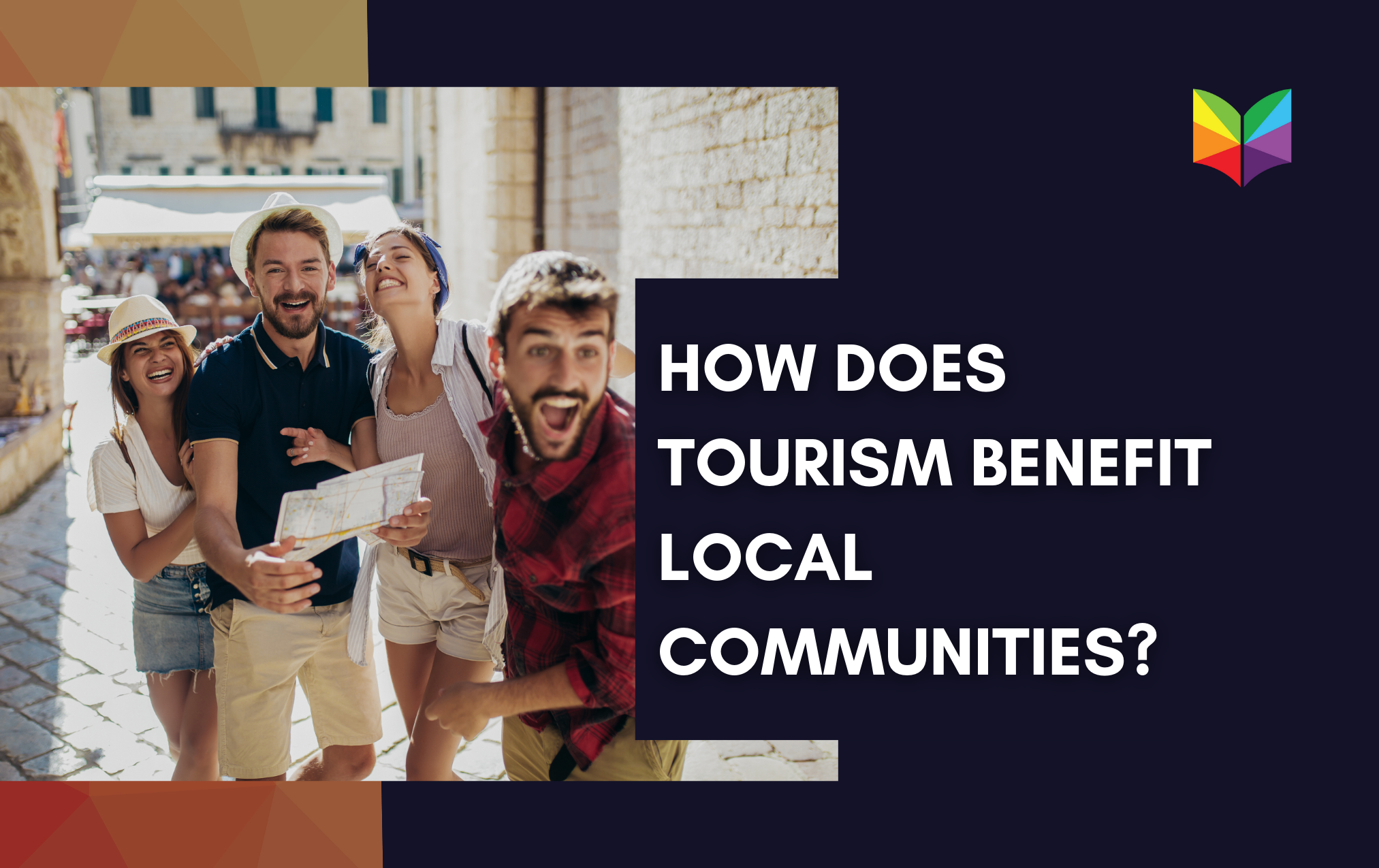

How Does Tourism Benefit Local Communities?
Tourism is a thriving industry that not only brings in visitors from around the world but also has significant positive impacts on local communities. While the economic benefits of tourism are well-known, its contributions to social, cultural, and environmental aspects are often overlooked. This article will explore how tourism can catalyze sustainable development and create a range of advantages for local communities.
Economic Growth and Job Creation: One of the most apparent benefits of tourism is its role in generating economic growth and employment opportunities. Tourists visit a destination and spend money on accommodation, transportation, food, shopping, and various services. This expenditure stimulates the local economy, increasing business activities and new jobs. Hotels, restaurants, tour operators, and local artisans are among the many businesses that directly benefit from the influx of tourists.
Preservation of Cultural Heritage: Tourism plays a significant role in preserving and promoting the cultural heritage of local communities. Visitors are often eager to explore a destination's unique traditions, customs, and historical sites. This creates a demand for cultural experiences, encouraging locals to preserve their traditions and showcase their heritage. By valuing their cultural assets, communities are motivated to protect historical landmarks, monuments, festivals, and traditional craftsmanship, which might have been neglected or forgotten.
Community Development and Infrastructure Improvement: Tourism can lead to the development of community infrastructure and public services. The revenue generated from tourism can be reinvested in improving transportation networks, healthcare facilities, educational institutions, and public spaces. This benefits tourists and enhances the quality of life for local residents. Additionally, the need to provide a positive visitor experience can encourage communities to invest in better facilities, amenities, and attractions, which ultimately benefit both tourists and locals alike.
Encouragement of Small Businesses and Entrepreneurship: The tourism industry allows small businesses and local entrepreneurs to thrive. Locals can establish their guesthouses, homestays, restaurants, tour companies, souvenir shops, and other tourism-related enterprises. This fosters entrepreneurship and empowers individuals within the community, promoting self-sufficiency and economic diversification. The growth of small businesses contributes to a more balanced and sustainable local economy, reducing dependency on a single industry.
Cultural Exchanges and Social Understanding: Tourism acts as a bridge for cultural exchange, fostering greater understanding and appreciation between visitors and locals. When tourists engage with the community, they gain insights into the local way of life, traditions, and customs. Similarly, locals can learn about different cultures, perspectives, and values. These interactions promote mutual respect and tolerance, breaking down stereotypes and fostering a sense of global citizenship.
Environmental Conservation and Sustainable Practices: Tourism can also drive environmental conservation and sustainable practices. Destinations with natural attractions often rely on preserving their environment to attract tourists. This incentivizes local communities to protect and conserve their natural resources, such as forests, wildlife, and marine ecosystems. Sustainable tourism practices, including responsible waste management, energy conservation, and eco-friendly initiatives, can benefit the environment and the community's long-term well-being.
RELATED: Train Your Tourism Ambassadors
Conclusion: Tourism brings many benefits to local communities beyond economic gains. It contributes to cultural preservation, infrastructure development, entrepreneurship, social understanding, and environmental conservation. By embracing sustainable tourism practices and involving local communities in decision-making processes, we can ensure that the positive impacts of tourism are maximized while minimizing its potential negative consequences. As travelers, we have the power to support and promote tourism that benefits local communities, ultimately creating a more inclusive and sustainable world.

Leave a comment
Related articles, the best time to launch your tourism ambassador training, leveraging online learning to build a sustainable tourism economy: a case study of rwenzori tourism academy in uganda, bordering a unesco site, the tourism academy's role in preserving local culture and natural habitats: empowering dmos.
Thank you for visiting nature.com. You are using a browser version with limited support for CSS. To obtain the best experience, we recommend you use a more up to date browser (or turn off compatibility mode in Internet Explorer). In the meantime, to ensure continued support, we are displaying the site without styles and JavaScript.
- View all journals
- My Account Login
- Explore content
- About the journal
- Publish with us
- Sign up for alerts
- Open access
- Published: 31 March 2023
The benefits of tourism for rural community development
- Yung-Lun Liu 1 ,
- Jui-Te Chiang 2 &
- Pen-Fa Ko 2
Humanities and Social Sciences Communications volume 10 , Article number: 137 ( 2023 ) Cite this article
22k Accesses
14 Citations
5 Altmetric
Metrics details
- Business and management
- Development studies
While the main benefits of rural tourism have been studied extensively, most of these studies have focused on the development of sustainable rural tourism. The role of tourism contributions to rural community development remains unexplored. Little is known about what tourism contribution dimensions are available for policy-makers and how these dimensions affect rural tourism contributions. Without a clear picture and indication of what benefits rural tourism can provide for rural communities, policy-makers might not invest limited resources in such projects. The objectives of this study are threefold. First, we outline a rural tourism contribution model that policy-makers can use to support tourism-based rural community development. Second, we address several methodological limitations that undermine current sustainability model development and recommend feasible methodological solutions. Third, we propose a six-step theoretical procedure as a guideline for constructing a valid contribution model. We find four primary attributes of rural tourism contributions to rural community development; economic, sociocultural, environmental, and leisure and educational, and 32 subattributes. Ultimately, we confirm that economic benefits are the most significant contribution. Our findings have several practical and methodological implications and could be used as policy-making guidelines for rural community development.
Similar content being viewed by others

Creativity development of tourism villages in Bandung Regency, Indonesia: co-creating sustainability and urban resilience

Eco-tourism, climate change, and environmental policies: empirical evidence from developing economies

Knowledge mapping of relative deprivation theory and its applicability in tourism research
Introduction.
In many countries, rural areas are less developed than urban areas. They are often perceived as having many problems, such as low productivity, low education, and low income. Other issues include population shifts from rural to urban areas, low economic growth, declining employment opportunities, the loss of farms, impacts on historical and cultural heritage, sharp demographic changes, and low quality of life. These issues indicate that maintaining agricultural activities without change might create deeper social problems in rural regions. Li et al. ( 2019 ) analyzed why some rural areas decline while others do not. They emphasized that it is necessary to improve rural communities’ resilience by developing new tourism activities in response to potential urban demands. In addition, to overcome the inevitability of rural decline, Markey et al. ( 2008 ) pointed out that reversing rural recession requires investment orientation and policy support reform, for example, regarding tourism. Therefore, adopting rural tourism as an alternative development approach has become a preferred strategy in efforts to balance economic, social, cultural, and environmental regeneration.
Why should rural regions devote themselves to tourism-based development? What benefits can rural tourism bring to a rural community, particularly during and after the COVID pandemic? Without a clear picture and answers to these questions, policy-makers might not invest limited resources in such projects. Understanding the contributions of rural tourism to rural community development is critical for helping government and community planners realize whether rural tourism development is beneficial. Policy-makers are aware that reducing rural vulnerability and enhancing rural resilience is a necessary but challenging task; therefore, it is important to consider the equilibrium between rural development and potential negative impacts. For example, economic growth may improve the quality of life and enhance the well-being index. However, it may worsen income inequality, increase the demand for green landscapes, and intensify environmental pollution, and these changes may impede natural preservation in rural regions and make local residents’ lives more stressful. This might lead policy-makers to question whether they should support tourism-based rural development. Thus, the provision of specific information on the contributions of rural tourism is crucial for policy-makers.
Recently, most research has focused on rural sustainable tourism development (Asmelash and Kumar, 2019 ; Polukhina et al., 2021 ), and few studies have considered the contributions of rural tourism. Sustainability refers to the ability of a destination to maintain production over time in the face of long-term constraints and pressures (Altieri et al., 2018 ). In this study, we focus on rural tourism contributions, meaning what rural tourism contributes or does to help produce something or make it better or more successful. More specifically, we focus on rural tourism’s contributions, not its sustainability, as these goals and directions differ. Today, rural tourism has responded to the new demand trends of short-term tourists, directly providing visitors with unique services and opportunities to contact other business channels. The impact on the countryside is multifaceted, but many potential factors have not been explored (Arroyo et al., 2013 ; Tew and Barbieri, 2012 ). For example, the demand for remote nature-based destinations has increased due to the fear of COVID-19 infection, the perceived risk of crowding, and a desire for low tourist density. Juschten and Hössinger ( 2020 ) showed that the impact of COVID-19 led to a surge in demand for natural parks, forests, and rural areas. Vaishar and Šťastná ( 2022 ) demonstrated that the countryside is gaining more domestic tourists due to natural, gastronomic, and local attractions. Thus, they contended that the COVID-19 pandemic created rural tourism opportunities.
Following this change in tourism demand, rural regions are no longer associated merely with agricultural commodity production. Instead, they are seen as fruitful locations for stimulating new socioeconomic activities and mitigating public mental health issues (Kabadayi et al., 2020 ). Despite such new opportunities in rural areas, there is still a lack of research that provides policy-makers with information about tourism development in rural communities (Petrovi’c et al., 2018 ; Vaishar and Šťastná, 2022 ). Although there are many novel benefits that tourism can bring to rural communities, these have not been considered in the rural community development literature. For example, Ram et al. ( 2022 ) showed that the presence of people with mental health issues, such as nonclinical depression, is negatively correlated with domestic tourism, such as rural tourism. Yang et al. ( 2021 ) found that the contribution of rural tourism to employment is significant; they indicated that the proportion of nonagricultural jobs had increased by 99.57%, and tourism in rural communities had become the leading industry at their research site in China, with a value ten times higher than that of agricultural output. Therefore, rural tourism is vital in counteracting public mental health issues and can potentially advance regional resilience, identity, and well-being (López-Sanz et al., 2021 ).
Since the government plays a critical role in rural tourism development, providing valuable insights, perspectives, and recommendations to policy-makers to foster sustainable policies and practices in rural destinations is essential (Liu et al., 2020 ). Despite the variables developed over time to address particular aspects of rural tourism development, there is still a lack of specific variables and an overall measurement framework for understanding the contributions of rural tourism. Therefore, more evidence is needed to understand how rural tourism influences rural communities from various structural perspectives and to prompt policy-makers to accept rural tourism as an effective development policy or strategy for rural community development. In this paper, we aim to fill this gap.
The remainder of this paper is organized as follows: the section “Literature review” presents the literature review. Our methodology is described in the section “Methodology”, and our results are presented in the section “Results”. Our discussion in the section “Discussion/implications” places our findings in perspective by describing their theoretical and practical implications, and we provide concluding remarks in the section “Conclusion”.
Literature review
The role of rural tourism.
The UNWTO ( 2021 ) defined rural tourism as a type of tourism in which a visitor’s experience is related to a wide range of products generally linked to nature-based activity, agriculture, rural lifestyle/culture, angling, and sightseeing. Rural tourism has been used as a valid developmental strategy in rural areas in many developed and developing countries. This developmental strategy aims to enable a rural community to grow while preserving its traditional culture (Kaptan et al., 2020 ). In rural areas, ongoing encounters and interactions between humans and nature occur, as well as mutual transformations. These phenomena take place across a wide range of practices that are spatially and temporally bound, including agriculture, forestry, fishing, hunting, farm tourism, cultural heritage preservation, and country life (Hegarty and Przezbórska, 2005 ). To date, rural tourism in many places has become an important new element of the regional rural economy; it is increasing in importance as both a strategic sector and a way to boost the development of rural regions (Polukhina et al., 2021 ). Urban visitors’ demand for short-term leisure activities has increased because of the COVID-19 pandemic (Slater, 2020 ). Furthermore, as tourists shifted their preferences from exotic to local rural tourism amid COVID-19, Marques et al. ( 2022 ) suggested that this trend is a new opportunity that should be seized, as rural development no longer relies on agriculture alone. Instead, other practices, such as rural tourism, have become opportunities for rural areas. Ironically, urbanization has both caused severe problems in rural areas and stimulated rural tourism development as an alternative means of economic revitalization (Lewis and Delisle, 2004 ). Rural tourism provides many unique events and activities that people who live in urban areas are interested in, such as agricultural festivals, crafts, historical buildings, natural preservation, nostalgia, cuisine, and opportunities for family togetherness and relaxation (Christou, 2020 ; Getz, 2008 ). As rural tourism provides visitors from urban areas with various kinds of psychological, educational, social, esthetic, and physical satisfaction, it has brought unprecedented numbers of tourists to rural communities, stimulated economic growth, improved the viability of these communities, and enhanced their living standards (Nicholson and Pearce, 2001 ). For example, rural tourism practitioners have obtained significant economic effects, including more income, more direct sales, better profit margins, and more opportunities to sell agricultural products or craft items (Everett and Slocum, 2013 ). Local residents can participate in the development of rural tourism, and it does not necessarily depend on external resources. Hence, it provides entrepreneurial opportunities (Lee et al., 2006 ). From an environmental perspective, rural tourism is rooted in a contemporary theoretical shift from cherishing local agricultural resources to restoring the balance between people and ecosystems. Thus, rural land is preserved, natural landscapes are maintained, and green consumerism drives farmers to focus on organic products, green chemistry, and value-added products, such as land ethics (Higham and Ritchie, 2001 ). Therefore, the potential contributions of rural tourism are significant and profound (Marques, 2006 ; Phillip et al., 2010 ). Understanding its contributions to rural community development could encourage greater policy-maker investment and resident support (Yang et al., 2010 ).
Contributions of rural tourism to rural community development
Maintaining active local communities while preventing the depopulation and degradation of rural areas requires a holistic approach and processes that support sustainability. What can rural tourism contribute to rural development? In the literature, rural tourism has been shown to bring benefits such as stimulating economic growth (Oh, 2005 ), strengthening rural and regional economies (Lankford, 1994 ), alleviating poverty (Zhao et al., 2007 ), and improving living standards in local communities (Uysal et al., 2016 ). In addition to these economic contributions, what other elements have not been identified and discussed (Su et al., 2020 )? To answer these questions, additional evidence is a prerequisite. Thus, this study examines the following four aspects. (1) The economic perspective: The clustering of activities offered by rural tourism stimulates cooperation and partnerships between local communities and serves as a vehicle for creating various economic benefits. For example, rural tourism improves employment opportunities and stability, local residents’ income, investment, entrepreneurial opportunities, agricultural production value-added, capital formation, economic resilience, business viability, and local tax revenue (Atun et al., 2019 ; Cheng and Zhang, 2020 ; Choi and Sirakaya, 2006 ; Chong and Balasingam, 2019 ; Cunha et al., 2020 ). (2) The sociocultural perspective: Rural tourism no longer refers solely to the benefits of agricultural production; through economic improvement, it represents a greater diversity of activities. It is important to take advantage of the novel social and cultural alternatives offered by rural tourism, which contribute to the countryside. For example, rural tourism can be a vehicle for introducing farmers to potential new markets through more interactions with consumers and other value chain members. Under such circumstances, the sociocultural benefits of rural tourism are multifaceted. These include improved rural area depopulation prevention (López-Sanz et al., 2021 ), cultural and heritage preservation, and enhanced social stability compared to farms that do not engage in the tourism business (Ma et al., 2021 ; Yang et al., 2021 ). Additional benefits are improved quality of life; revitalization of local crafts, customs, and cultures; restoration of historical buildings and community identities; and increased opportunities for social contact and exchange, which enhance community visibility, pride, and cultural integrity (Kelliher et al., 2018 ; López-Sanz et al., 2021 ; Ryu et al., 2020 ; Silva and Leal, 2015 ). (3) The environmental perspective: Many farms in rural areas have been rendered noncompetitive due to a shortage of labor, poor managerial skills, and a lack of financial support (Coria and Calfucura, 2012 ). Although there can be immense pressure to maintain a farm in a family and to continue using land for agriculture, these problems could cause families to sell or abandon their farms or lands (Tew and Barbieri, 2012 ). In addition, unless new income pours into rural areas, farm owners cannot preserve their land and its natural aspects; thus, they tend to allow their land to become derelict or sell it. In the improved economic conditions after farms diversify into rural tourism, rural communities have more money to provide environmental care for their natural scenic areas, pastoral resources, forests, wetlands, biodiversity, pesticide mitigation, and unique landscapes (Theodori, 2001 ; Vail and Hultkrantz, 2000 ). Ultimately, the entire image of a rural community is affected; the community is imbued with vitality, and farms that participate in rural tourism instill more togetherness among families and rural communities. In this study, the environmental benefits induced by rural tourism led to improved natural environmental conservation, biodiversity, environmental awareness, infrastructure, green chemistry, unspoiled land, and family land (Di and Laura, 2021 ; Lane, 1994 ; Ryu et al., 2020 ; Yang et al., 2021 ). (4) The leisure and educational perspective: Rural tourism is a diverse strategy associated with an ongoing flow of development models that commercialize a wide range of farming practices for residents and visitors. Rural territories often present a rich set of unique resources that, if well managed, allow multiple appealing, authentic, and memorable tourist experiences. Tourists frequently comment that the rural tourism experience positively contrasts with the stress and other negatively perceived conditions of daily urban life. This is reflected in opposing, compelling images of home and a visited rural destination (Kastenholz et al., 2012 ). In other words, tourists’ positive experiences result from the attractions and activities of rural tourism destinations that may be deemed sensorially, symbolically, or socially opposed to urban life (Kastenholz et al. 2018 ). These experiences are associated with the “search for authenticity” in the context of the tension between the nostalgic images of an idealized past and the demands of stressful modern times. Although visitors search for the psychological fulfillment of hedonic, self-actualization, challenge, accomplishment, exploration, and discovery goals, some authors have uncovered the effects of rural tourism in a different context. For example, Otto and Ritchie ( 1996 ) revealed that the quality of a rural tourism service provides a tourist experience in four dimensions—hedonic, peace of mind, involvement, and recognition. Quadri-Felitti and Fiore ( 2013 ) identified the relevant impact of education, particularly esthetics, versus memory on satisfaction in wine tourism. At present, an increasing number of people and families are seeking esthetic places for relaxation and family reunions, particularly amid COVID-19. Rural tourism possesses such functions; it remains a novel phenomenon for visitors who live in urban areas and provides leisure and educational benefits when visitors to a rural site contemplate the landscape or participate in an agricultural process for leisure purposes (WTO, 2020 ). Tourists can obtain leisure and educational benefits, including ecological knowledge, information about green consumerism, leisure and recreational opportunities, health and food security, reduced mental health issues, and nostalgia nurturing (Alford and Jones, 2020 ; Ambelu et al., 2018 ; Christou, 2020 ; Lane, 1994 ; Li et al., 2021 ). These four perspectives possess a potential synergy, and their effects could strengthen the relationship between rural families and rural areas and stimulate new regional resilience. Therefore, rural tourism should be understood as an enabler of rural community development that will eventually attract policy-makers and stakeholders to invest more money in developing or advancing it.
Methodology
The literature on rural tourism provides no generally accepted method for measuring its contributions or sustainability intensity. Although many statistical methods are available, several limitations remain, particularly in terms of the item generation stage and common method bias (CMB). For example, Marzo-Navar et al. ( 2015 ) used the mean and SD values to obtain their items. However, the use of the mean has been criticized because it is susceptible to extreme values or outliers. In addition, they did not examine omitted variables and CMB. Asmelash and Kumar ( 2019 ) used the Delphi method with a mean value for deleting items. Although they asked experts to suggest the inclusion of any missed variables, they did not discuss these results. Moreover, they did not assess CMB. Islam et al. ( 2021 ) used a sixteen-step process to formulate sustainability indicators but did not consider omitted variables, a source of endogeneity bias. They also did not designate a priority for each indicator. Although a methodologically sound systematic review is commonly used, little attention has been given to reporting interexpert reliability when multiple experts are used to making decisions at various points in the screening and data extraction stages (Belur et al., 2021 ). Due to the limitations of the current methods for assessing sustainable tourism development, we aim to provide new methodological insights. Specifically, we suggest a six-stage procedure, as shown in Fig. 1 .
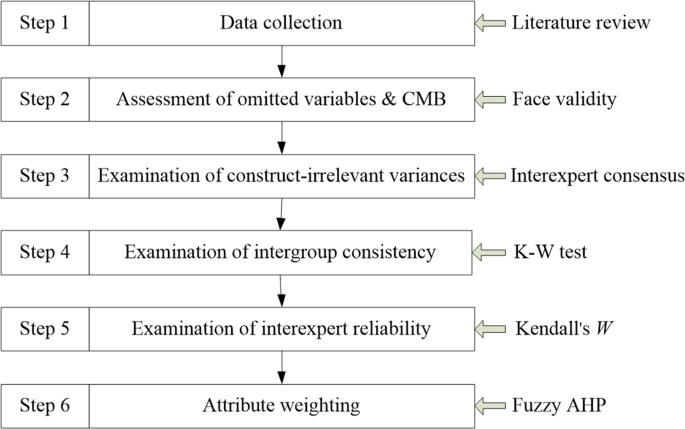
Steps required in developing the model for analysis after obtaining the data.
Many sources of data collection can be used, including literature reviews, inferences about the theoretical definition of the construct, previous theoretical and empirical research on the focal construct, advice from experts in the field, interviews, and focus groups. In this study, the first step was to retrieve data from a critical literature review. The second step was the assessment of omitted variables to produce items that fully captured all essential aspects of the focal construct domain. In this case, researchers must not omit a necessary measure or fail to include all of the critical dimensions of the construct. In addition, the stimuli of CMB, for example, double-barreled items, items containing ambiguous or unfamiliar terms, and items with a complicated syntax, should be simplified and made specific and concise. That is, researchers should delete items contaminated by CMB. The third step was the examination of construct-irrelevant variance to retain the variances relevant to the construct of interest and minimize the extent to which the items tapped concepts outside the focal construct domain. Variances irrelevant to the targeted construct should be deleted. The fourth step was to examine intergroup consistency to ensure that there was no outlier impact underlying the ratings. The fifth step was to examine interexpert reliability to ensure rating conformity. Finally, we prioritized the importance of each variable with the fuzzy analytic hierarchy process (AHP), which is a multicriteria decision-making approach. All methods used in this study are expert-based approaches.
Selection of experts
Because this study explores the contributions of rural tourism to rural community development, it involves phenomena in the postdevelopment stage; therefore, a few characteristics are essential for determining the choice of experts. The elements used to identify the experts in this study were (1) the number of experts, (2) expertise, (3) knowledge, (4) diversity, (5) years working in this field, and 5) commitment to participation. Regarding the number of experts, Murphy-Black et al. ( 1998 ) suggested that the more participants there are, the better, as a higher number reduces the effects of expert attrition and rater bias. Taylor-Powell ( 2002 ) pointed out that the number of participants in an expert-based study depends not only on the purpose of the research but also on the diversity of the target population. Okoli and Pawlowski ( 2004 ) recommended a target number of 10–18 experts for such a purpose. Therefore, we recruited a group of 18 experts based on their stated interest in the topic and asked them to comment on our rationale concerning the rating priorities among the items. We asked them to express a degree of agreement or disagreement with each item we provided. We adopted a heterogeneous and anonymous arrangement to ensure that rater bias did not affect this study. The 18 experts had different backgrounds, which might have made it easier for them to reach a consensus objectively. We divided the eighteen experts into three subgroups: (1) at least six top managers from rural tourism businesses, all of whom had been in the rural tourism business for over 10 years; (2) at least six academics who taught subjects related to tourism at three different universities in Taiwan; and (3) at least six government officials involved in rural development issues in Taiwan.
Generating items to represent the construct
Step 1: data collection.
Data collection provides evidence for investigation and reflects the construct of interest. While there is a need to know what rural tourism contributes, previous studies have provided no evidence for policy-makers to establish a rural community strategy; thus, it is essential to use a second source to achieve this aim. We used a literature review for specific topics; the data we used were based on the findings being presented in papers on rural tourism indexed in the SSCI (Social Sciences Citation Index) and SCIE (Science Citation Index Expanded). In this study, we intended to explore the role of rural tourism and its contributions to rural development. Therefore, we explored the secondary literature on the state of the questions of rural development, sustainable development, sustainability indicators, regional resilience, farm tourism, rural tourism, COVID-19, tourist preferences, and ecotourism using terms such as land ethics, ecology, biodiversity, green consumerism, environmentalism, green chemistry, community identity, community integration, community visibility, and development goals in an ad hoc review of previous studies via Google Scholar. Based on the outcomes of this first data collection step, we generated thirty-three subattributes and classified them into four domains.
Step 2: Examine the face validity of omitted variables and CMB
Face validity is defined as assessing whether a measurement scale or questionnaire includes all the necessary items (Dempsey and Dempsey, 1992 ). Based on the first step, we generated data subattributes from our literature review. However, there might have been other valuable attributes or subattributes that were not considered or excluded. Therefore, our purposes for examining face validity were twofold. First, we assessed the omitted variables, defined as the occurrence of crucial aspects or facets that were omitted (Messick, 1995 ). These comprise a threat to construct validity that, if ignored by researchers, might result in unreliable findings. In other words, face validity is used to distinguish whether the researchers have adequately captured the full dimensions of the construct of interest. If not, the evaluation instrument or model is deficient. However, the authors found that most rural tourism studies have not assessed the issue of omitted variables (An and Alarcon, 2020 ; Lin, 2022 ). Second, we mitigated the CMB effect. In a self-report survey, it is necessary to provide a questionnaire without CMB to the targeted respondents, as CMB affects respondent comprehension. Therefore, we assessed item characteristic effects, item context effects, and question response process effects. These three effects are related to the respondents’ understanding, retrieval, mood, affectivity, motivation, judgment, response selection, and response reporting (Podsakoff et al., 2003 ). Specifically, items containing flaws from these three groups in a questionnaire can seriously influence an empirical investigation and potentially result in misleading conclusions. We assessed face validity by asking all the experts to scrutinize the content items that we collected from the literature review and the questionnaire that we drafted. The experts could then add any attribute or subattribute they thought was essential that had been omitted. They could also revise the questionnaire if CMB were embedded. We added the new attributes or subattributes identified by the experts to those collected from the literature review.
Step 3: Examine interexpert consensus for construct-irrelevant variances
After examining face validity, we needed to rule out items irrelevant to the construct of interest; otherwise, the findings would be invalid. We examined the interexpert consensus to achieve this aim. The purpose was to estimate the experts’ ratings of each item. In other words, interexpert consensus assesses the extent to which experts make the same ratings (Kozlowski and Hattrup, 1992 ; Northcote et al., 2008 ). In prior studies, descriptive statistics have often been used to capture the variability among individual characteristics, responses, or contributions to the subject group (Landeta, 2006 ; Roberson et al., 2007 ). Many expert-based studies have applied descriptive statistics to determine consensus and quantify its degree (Paraskevas and Saunders, 2012 ; Stewart et al., 2016 ). Two main groups of descriptive statistics, central tendencies (mode, mean, and median) and level of dispersion (standard deviation, interquartile, and coefficient of variation), are commonly used when determining consensus (Mukherjee et al., 2015 ). Choosing the cutoff point of interexpert consensus was critical because we used it as a yardstick for item retention and its value can also be altered by a number on the Likert scale (Förster and von der Gracht, 2014 ). In the case of a 5-point Likert scale, the coefficient of variation (CV) is used to measure interexpert consensus. Hence, CV ≤ 0.3 indicated high consensus (Zinn et al., 2001 ). In addition, based on the feedback obtained from the expert panel, we used standard deviation (SD) as another measurement to assess the variation in our population. Henning and Jordaan ( 2016 ) indicate that SD ≤ 1 represents a high level of consensus, meaning that it can act as a guideline for cutoff points. In addition, following Vergani et al. ( 2022 ), we used the percentage agreement (% AGR) to examine interexpert consensus. If the responses reached ≧ 70% 4 and 5 in the case of a 5-point Likert scale, it indicated that the item had interexpert consensus; thus, we could retain it. Moreover, to avoid the impact of outliers, we used the median instead of the mean as another measurement. Items had a high consensus if their median value was ≥4.00 (Rice, 2009 ). Considering these points, we adopted % AGR, median, SD, and CV to examine interexpert consensus.
Step 4: Examine intergroup consistency
In this expert-based study, the sample size was small. Any rater bias could have caused inconsistency among the subgroups of experts; therefore, we needed to examine the effect of rater bias on intergroup consistency. When the intergroup ratings showed substantially different distributions, the aggregated data were groundless. Dajani et al. ( 1979 ) remarked that interexpert consensus is meaningless if the consistency of responses in a study is not reached, as it means that any rater bias could distort the median, SD, or CV. Most studies have used one-way ANOVA to determine whether there is a significant difference between the expected and observed frequency in three or more categories. However, this method is based on large sample size and normal distribution. In the case of expert-based studies, the expert sample size is small, and the assessment distribution tends to be skewed. Thus, we used the nonparametric test instead of one-way ANOVA for consistency measurement (Potvin and Roff, 1993 ). We used the Kruskal‒Wallis test (K–W) to test the intergroup consistency among the three subgroups of experts. The purpose of the K–W test is to determine whether there are significant differences among three or more subgroups regarding the ratings of the domains (Huck, 2004 ). The judgment criteria in the K-W test depended on the level of significance, and we set the significance level at p < 0.05 (Love and Irani, 2004 ), with no significant differences among groups set at p > 0.05 (Loftus et al., 2000 ; Rice, 2009 ). We used SPSS to conduct the K–W test to assess intergroup consistency in this study.
Step 5: Examine interexpert reliability
Interexpert reliability, on the one hand, is usually defined as the proportion of systematic variance to the total variance in ratings (James et al., 1984 ). On the other hand, interexpert reliability estimation is not concerned with the exact or absolute value of ratings. Rather, it measures the relative ordering or ranking of rated objects. Thus, interexpert reliability estimation concerns the consistency of ratings (Tinsley and Weiss, 1975 ). If an expert-based study did not achieve interexpert reliability, we could not trust its analysis (Singletary, 1994 ). Thus, we examined interexpert reliability in this expert-based study. Many methods are available in the literature for measuring interexpert reliability, but there seems to be little consensus on a standard method. We used Kendall’s W to assess the reliability among the experts for each sample group (Goetz et al., 1994 ) because it was available for any sample size or ordinal number. If W was 1, all the experts were unanimous, and each had assigned the same order to the list of objects or concerns. As Spector et al. ( 2002 ) and Schilling ( 2002 ) suggested, reliabilities well above the recommended value of .70 indicate sufficient internal reliability. In this study, there was a strong consensus when W > 0.7. W > 0.5 represented a moderate consensus; and W < 0.3 indicated weak interexpert agreement (Schmidt et al., 2001 ). To measure Kendall’s W , we used SPSS 23 to assess interexpert reliability.
Step 6: Examine the fuzzy analytic hierarchy process
After examining face validity, interexpert consensus, intergroup consistency, and interexpert reliability, we found that the aggregated items were relevant, authentic, and reliable in relation to the construct of interest. To provide policy-makers with a clear direction regarding which contributions are more or less important, we scored each attribute and subattribute using a multicriteria decision-making technique. Fuzzy AHP is a well-known decision-making tool for modeling unstructured problems. It enables decision-makers to model a complex issue in a hierarchical structure that indicates the relationships between the goal, criteria, and subcriteria on the basis of scores (Park and Yoon, 2011 ). The fuzzy AHP method tolerates vagueness and ambiguity (Mikhailov and Tsvetinov, 2004 ). In other words, fuzzy AHP can capture a human’s appraisal of ambiguity when considering complex, multicriteria decision-making problems (Erensal et al., 2006 ). In this study, we used Power Choice 2.5 software to run fuzzy AHP, determine weights, and develop the impact structure of rural tourism on sustainable rural development.
Face validity
To determine whether we had omitted variables, we asked all 18 experts to scrutinize our list of four attributes and 33 subattributes for omitted variables and determine whether the questionnaire contained any underlying CMB. We explained the meaning of omitted variables, the stimuli of CMB, and the two purposes of examining face validity to all the experts. In their feedback, the eighteen experts added one item as an omitted variable: business viability. The experts suggested no revisions to the questionnaire we had drafted. These results indicated that one omitted variable was revealed and that our prepared questionnaire was clear, straightforward, and understandable. The initially pooled 34 subattributes represented the construct of interest, and all questionnaires used for measurement were defendable in terms of CMB. The biasing effects of method variance did not exist, indicating that the threat of CMB was minor.
Interexpert consensus
In this step, we rejected any items irrelevant to the construct of interest. Consensus measurement played an essential role in aggregating the experts’ judgments. This study measured the AGR, median, SD, and CV. Two items, strategic alliance (AGR = 50%) and carbon neutrality (AGR = 56%) were rated < 70%, and we rejected them accordingly. These results are shown in Table 1 . The AGR, median, SD, and CV values were all greater than the cutoff points, thus indicating that the majority of experts in this study consistently recognized high values and reached a consensus for the rest of the 32 subattributes. Consequently, the four attributes and 32 subattributes remained and were initially identified as determinants for further analysis.
Intergroup consistency and interexpert reliability
In this study, with scores based on a 5-point Likert scale, we conducted the K–W test to assess intergroup differences for each subattribute. Based on the outcomes, the K–W test yielded significant results for all 32 subattributes; all three groups of experts reached consistency at p > 0.05. This result indicated that no outlier or extreme value underlay the ratings, and therefore, intergroup consistency was reached. Finally, we measured interexpert reliability with Kendall’s W . The economic perspective was W = 0.73, the sociocultural perspective was W = 0.71, the environmental perspective was W = 0.71, and the leisure and educational perspective was W = 0.72. These four groups of W were all ≧ 0.7, indicating high reliability for the ranking order and convergence judged by all subgroup experts. These results are shown in Table 2 .
The hierarchical framework
The results of this study indicate that rural tourism contributions to rural community development comprise four attributes and thirty-two subattributes. The economic perspective encompasses nine subattributes and is weighted at w = 0.387. In addition, rural tourism has long been considered a possible means of sociocultural development and regeneration of rural areas, particularly those affected by the decline in traditional rural
activities, agricultural festivals, and historical buildings. According to the desired benefits, the sociocultural perspective encompasses nine subattributes and is weighted at w = 0.183. Moreover, as rural tourism can develop on farms and locally, its contribution to maintaining and enhancing environmental regeneration and protection is significant. Therefore, an environmental perspective can determine rural tourism’s impact on pursuing environmental objectives. Our results indicate that the environmental perspective encompasses seven subattributes and that its weight is w = 0.237. Furthermore, the leisure and educational perspective indicates the attractiveness of rural tourism from visitors’ viewpoint and their perception of a destination’s value and contributions. These results show that this perspective encompasses seven subattributes and is weighted at w = 0.193. This specific contribution model demonstrates a 3-level hierarchical structure, as shown in Fig. 2 . The scores for each criterion could indicate each attribute’s importance and explain the priority order of the groups. Briefly, the critical sequence of each measure in the model at Level 2 is as follows: economic perspective > environmental perspective > leisure and educational perspective > sociocultural perspective. Since scoring and ranking were provided by 18 experts from three different backgrounds and calculated using fuzzy AHP, our rural tourism contribution model is established. It can provide policy-makers with information on the long-term benefits and advantages following the completion of excellent community development in rural areas.
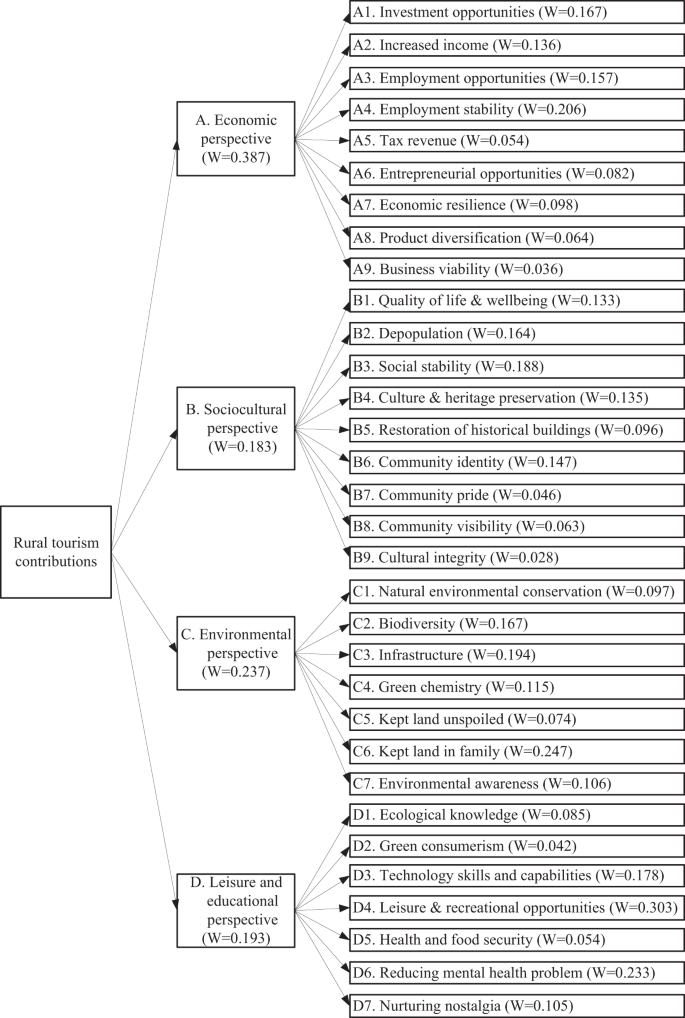
The priority index of each attribute and sub-attribute.
Discussion/Implications
In the era of sustainable rural development, it is vital to consider the role of rural tourism and how research in this area shapes access to knowledge on rural community development. This study provides four findings based on the increasing tendency of policy-makers to use such information to shape their policy-making priorities. It first shows that the demand for rural tourism has soared, particularly during COVID-19. Second, it lists four significant perspectives regarding the specific contributions of rural tourism to rural community development and delineates how these four perspectives affect rural tourism development. Our findings are consistent with those of prior studies. For example, geography has been particularly important in the rural or peripheral tourism literature (Carson, 2018 ). In terms of the local geographical context, two contributions could be made by rural tourism. The first stems from the environmental perspective. When a rural community develops rural tourism, environmental protection awareness is increased, and the responsible utilization of natural resources is promoted. This finding aligns with Lee and Jan ( 2019 ). The second stems from the leisure and educational perspective. The geographical context of a rural community, which provides tourists with geographical uniqueness, advances naturally calming, sensory-rich, and emotion-generating experiences for tourists. These results suggest that rural tourism will likely positively impact tourists’ experience. This finding is consistent with Kastenhoz et al. ( 2020 ). Third, although expert-based approaches have considerable benefits in developing and testing underlying phenomena, evidence derived from interexpert consensus, intergroup consistency, and interexpert reliability has been sparse. This study provides such evidence. Fourth, this research shows that rural tourism makes four main contributions, economic, sociocultural, environmental, leisure, and educational, to rural community development. Our results show four key indicators at Level 2. The economic perspective is strongly regarded as the most important indicator, followed by the environmental perspective, leisure and educational perspective, and sociocultural perspective, which is weighted as the least important. The secondary determinants of contributions have 32 subindicators at Level 3: each was identified and assigned a different weight. These results imply that the attributes or subattributes with high weights have more essential roles in understanding the contributions of rural tourism to rural community development. Policy-makers can use these 32 subindicators to formulate rural tourism development policies or strategies.
This study offers the following five practical implications for policymakers and rural communities:
First, we argue that developing rural tourism within a rural community is an excellent strategy for revitalization and countering the effects of urbanization, depopulation, deforestation, and unemployment.
Second, our analytical results indicate that rural tourism’s postdevelopment contribution is significant from the economic, sociocultural, environmental, leisure, and educational perspectives, which is consistent with Lee and Jan ( 2019 ).
Third, there is an excellent opportunity to build or invest more in rural tourism during COVID-19, not only because of the functions of rural tourism but also because of its timing. Many prior studies have echoed this recommendation. For example, Yang et al. ( 2021 ) defined rural tourism as the leading industry in rural areas, offering an output value ten times higher than that of agriculture in China. In addition, rural tourism has become more attractive to urban tourists amid COVID-19. Vaishar and Šťastná ( 2022 ) suggested that the COVID-19 pandemic created a strong demand for rural tourism, which can mitigate threats to public mental health, such as anxiety, depression, loneliness, isolation, and insomnia. Marques et al. ( 2022 ) showed that tourists’ preference for tourism in rural areas increased substantially during COVID-19.
Fourth, the contributions of this study to policy development are substantial. The more focused rural tourism in rural areas is, the more effective revitalization becomes. This finding highlights the importance of such features in developing rural tourism to enhance rural community development from multiple perspectives. This finding echoes Zawadka et al. ( 2022 ); i.e., policy-makers should develop rural tourism to provide tourists with a safe and relaxed environment and should not ignore the value of this model for rural tourism.
Fifth, our developed model could drive emerging policy issues from a supporting perspective and provide policy-makers with a more comprehensive overview of the development of the rural tourism sector, thus enabling them to create better policies and programs as needed. For example, amid COVID-19, rural tourism created a safe environment for tourists, mainly by reducing their fears of contamination (Dennis et al., 2021 ). This novel contribution that rural tourism destinations can provide to residents and visitors from other places should be considered and built into any rural community development policy.
This study also has the following four methodological implications for researchers:
First, it addresses methodological limitations that still impede tourism sustainability model development. Specifically, we suggest a six-stage procedure as the guideline; it is imperative that rural tourism researchers or model developers follow this procedure. If they do not, their findings tend to be flawed.
Second, to ensure that collected data are without extraneous interference or differences via subgroups of experts, the assessment of intergroup consistency with the K–W test instead of one-way ANOVA is proposed, especially in small samples and distribution-free studies.
Third, providing interexpert reliability evidence within expert-based research is critical; we used Kendall’s W to assess the reliability among experts for each sample group because it applies to any sample size and ordinal number.
Finally, we recommend using fuzzy AHP to establish a model with appropriate indicators for decision-making or selection. This study offers novel methodological insights by estimating a theoretically grounded and empirically validated rural tourism contribution model.
There are two limitations to this study. First, we examine all subattributes by interexpert consensus to delete construct-irrelevant variances that might receive criticism for their lack of statistical rigor. Future studies can use other rigorous methods, such as AD M( j ) or rWG ( j ) , interexpert agreement indices to assess and eliminate construct-irrelevant variances. Second, we recommend maximizing rural tourism contributions to rural community development by using the general population as a sample to identify any differences. More specifically, we recommend using Cronbach’s alpha, confirmatory factor analysis (CFA), and structural equation modeling (SEM) to test the overall reliability and validity of the data and results. It is also necessary to provide results for goodness-of-fit measures—e.g., the goodness-of-fit index (GFI), adjusted goodness-of-fit index (AGFI), comparative fit index (CFI), normed fit index (NFI), Tucker–Lewis Index (TLI), standardized root mean square residual (SRMR), or root mean square error of approximation (RMSEA).
Numerous empirical studies have illustrated how rural tourism can positively and negatively affect the contexts in rural areas where it is present. This study reveals the positive contributions of rural tourism to rural community development. The findings show that using rural tourism as a revitalization strategy is beneficial to nonurban communities in terms of their economic, sociocultural, environmental, and leisure and educational development. The contribution from the economic perspective is particularly important. These findings suggest that national, regional, and local governments or community developers should make tourism a strategic pillar in their policies for rural development and implement tourism-related development projects to gain 32 benefits, as indicated in Fig. 2 . More importantly, rural tourism was advocated and proved effective for tourists and residents to reduce anxiety, depression, or insomnia during the COVID-19 pandemic. With this emerging contribution, rural tourism is becoming more critical to tourists from urban areas and residents involved in rural community development. With this model, policy-makers should not hesitate to develop or invest more in rural communities to create additional tourism-based activities and facilities. As they could simultaneously advance rural community development and public mental health, policy-makers should include these activities among their regional resilience considerations and treat them as enablers of sustainable rural development. We conclude that amid COVID-19, developing rural tourism is an excellent strategy for promoting rural community development and an excellent alternative that could counteract the negative impacts of urbanization and provide stakeholders with more positive interests. The proposed rural tourism contribution model also suggests an unfolding research plan.
Data availability
The datasets generated and/or analyzed during the current study are available from the corresponding author on reasonable request.
Alford P, Jones R (2020) The lone digital tourism entrepreneur: Knowledge acquisition and collaborative transfer. Tour Manag 81:104–139. https://doi.org/10.1016/j.tourman.2020.104139
Article Google Scholar
Altieri MA, Farrell JG, Hecht SB, Liebman M, Magdoff F et al (2018) The agroecosystem: determinants, resources, processes, and sustainability. Agroecology 41–68. https://doi.org/10.1201/9780429495465-3
Ambelu G, Lovelock B, Tucker H (2018) Empty bowls: conceptualising the role of tourism in contributing to sustainable rural food security. J Sustain Tour 26(10):1749–1765. https://doi.org/10.1080/09669582.2018.1511719
An W, Alarcon S (2020) How can rural tourism be sustainable? A systematic review. Sustainability 12(18):7758. https://doi.org/10.3390/su12187758
Arroyo C, Barbieri C, Rich SR (2013) Defining agritourism: a comparative study of stakeholders’ perceptions in Missouri and North Carolina. Tour Manag 37:39–47. https://doi.org/10.1016/j.tourman.2012.12.007
Asmelash AG, Kumar S (2019) Assessing progress of tourism sustainability: Developing and validating sustainability indicators. Tour Manag 71:67–83. https://doi.org/10.1016/j.tourman.2018.09.020
Atun RA, Nafa H, Türker ÖO (2019) Envisaging sustainable rural development through ‘context-dependent tourism’: case of Northern Cyprus. Environ Dev Sustain 21:1715–1744. https://doi.org/10.1007/s10668-018-0100-8
Belur J, Tompson L, Thornton A, Simon M (2021) Interrater reliability in systematic review methodology: exploring variation in coder decision-making. Sociol Methods Res 50(2):837–865. https://doi.org/10.1177/0049124118799372
Article MathSciNet Google Scholar
Carson DA (2018) Challenges and opportunities for rural tourism geographies: a view from the ‘boring’ peripheries. Tour Geogr 20(4):737–741. https://doi.org/10.1080/4616688.2018.1477173
Cheng L, Zhang J (2020) Is tourism development a catalyst of economic recovery following natural disaster? An analysis of economic resilience and spatial variability. Curr Issues Tour 1–22. https://doi.org/10.1080/13683500.2019.1711029
Choi H-SC, Sirakaya E (2006) Sustainability indicators for managing community tourism. Tour Manag 27(6):1274–1289. https://doi.org/10.1016/j.tourman.2005.05.018
Chong KY, Balasingam AS (2019) Tourism sustainability: economic benefits and strategies for preservation and conservation of heritage sites in Southeast Asia. Tour Rev 74(2):268–279. https://doi.org/10.1108/TR-11-2017-0182
Christou PA (2020) Tourism experiences as the remedy to nostalgia: conceptualizing the nostalgia and tourism nexus. Curr Issues Tour 23(5):612–625. https://doi.org/10.1080/13683500.2018.1548582
Coria J, Calfucura E (2012) Ecotourism and the development of indigenous communities: the good, the bad and the ugly. Ecol Econ 73(15):47–55. https://doi.org/10.1016/j.ecolecon.2011.10.024
Cunha C, Kastenholz E, Carneiro MJ (2020) Entrepreneurs in rural tourism: do lifestyle motivations contribute to management practices that enhance sustainable entrepreneurial ecosystems? J Hosp Tour Manag 44:215–226. https://doi.org/10.1016/j.jhtm.2020.06.007
Dajani JS, Sincoff MZ, Talley WK (1979) Stability and agreement criteria for the termination of Delphi studies. Technol Forecast Soc Change 13(1):83–90. https://doi.org/10.1016/0040-1625(79)90007-6
Dempsey PA, Dempsey AD (1992) Nursing research with basic statistical applications, 3rd edn. Jones and Bartlett, Boston
Google Scholar
Dennis D, Radnitz C, Wheaton MG (2021) A perfect storm? Health anxiety, contamination fears, and COVID-19: lessons learned from past pandemics and current challenges. Int J Cogn Ther 14:497–513. https://doi.org/10.1007/s41811-021-00109-7
Article PubMed PubMed Central Google Scholar
Di TF, Laura M (2021) How green possibilities can help in a future sustainable conservation of cultural heritage in Europe. Sustainability 13(7):3609. https://doi.org/10.3390/su13073609
Erensal YC, ncan TÖ, Demircan ML (2006) Determining key capabilities in technology management using fuzzy analytic hierarchy process: a case study of Turkey. Inf Sci 176(18):2755–2770. https://doi.org/10.1016/j.ins.2005.11.004
Everett S, Slocum SL (2013) Food and tourism: an effective partnership? A UK-based review. J Sustain Tour 21(6):789–809. https://doi.org/10.1080/09669582.2012.741601
Förster B, von der Gracht H (2014) Assessing Delphi panel composition for strategic foresight—a comparison of panels based on company-Internal and external participants. Technol Forecast Soc Change 84:215–229. https://doi.org/10.1016/.techfore.2013.07.012
Getz D (2008) Event tourism: definition, evolution and research. Tour Manag 29(3):403–428. https://doi.org/10.1016/j.tourman.2007.07.017
Goetz CG, Stebbins GT, Shale HM, Lang AE, Chernik DA, Chmura TA, Ahlskog JE, Dorflinger EE (1994) Utility of an objective dyskinesia rating scale for Parkinson’s disease: inter- and intrarater reliability assessment. Mov Disord 9(4):390–394. https://doi.org/10.1002/mds.870090403
Article CAS PubMed Google Scholar
Hegarty C, Przezborska L (2005) Rural and agri-tourism as a tool for reorganizing rural areas in old and new member states—a comparison study of Ireland and Poland. Int J Tour Res 7(2):63–77. https://doi.org/10.1002/jtr.513
Henning JIF, Jordaan H (2016) Determinants of financial sustainability for farm credit applications—a Delphi study. Sustainability 8(1):77. https://doi.org/10.3390/su8010077
Higham JES, Ritchie B (2001) The evolution of festivals and other events in rural Southern New Zealand. Event Manag 7(1):39–49. https://doi.org/10.3727/152599501108751461
Huck SW (2004) Reading statistics and research, 4th edn. Allyn and Bacon, Boston
Islam MS, Lovelock B, Coetzee WJL (2021) Liberating sustainability indicators: developing and implementing a community-operated tourism sustainability indicator system in Boga Lake, Bangladesh. J Sustain Tour. https://doi.org/10.1080/09669582.2021.1928147
James LR, Demaree RG, Wolf G (1984) Estimating within-group interrater reliability with and without response bias. J Appl Psychol 69(1):322–327. https://doi.org/10.1037/0021-9010.69.1.85
Juschten M, Hössinger R (2020) Out of the city - But how and where? A mode-destination choice model for urban–rural tourism trips in Austria. Curr Issues Tour 24(10):1465–1481. https://doi.org/10.1080/13683500.2020.1783645
Kabadayi S, O’Connor G, Tuzovic S (2020) Viewpoint: the impact of coronavirus on service ecosystems as service mega-disruptions. J Serv Mark 34(6):809–817. reurl.cc/oen0lM
Kaptan AÇ, Cengı̇z TT, Özkök F, Tatlı H (2020) Land use suitability analysis of rural tourism activities: Yenice, Turkey. Tour Manag 76:103949. https://doi.org/10.1016/j.tourman.2019.07.003
Kastenholz E, Carneiro MJ, Marques CP, Lima J (2012) Understanding and managing the rural tourism experience—the case of a historical village in Portugal. Tour Manag Perspect 4:207–214. https://doi.org/10.1016/j.tmp.2012.08.009
Kastenholz E, Carneiro M, Marques CP, Loureiro SMC (2018) The dimensions of rural tourism experience: impacts on arousal, memory and satisfaction. J Travel Tour Mark 35(2):189–201. https://doi.org/10.1080/10548408.2017.1350617
Kastenhoz E, Marques CP, Carneiro MJ (2020) Place attachment through sensory-rich, emotion-generating place experiences in rural tourism. J Destin Mark Manage 17:100455. https://doi.org/10.1016/j.jdmm.2020.100455
Kelliher F, Rein L, Johnson TG, Joppe M (2018) The role of trust in building rural tourism micro firm network engagement: a multi-case study. Tour Manag 68:1–12. https://doi.org/10.1016/j.tourman.2018.02.014
Kozlowski SW, Hattrup K (1992) A disagreement about within-group agreement: disentangling issues of consistency versus consensus. J Appl Psychol 77(2):161–167. https://doi.org/10.1037/0021-9010.77.2.161
Landeta J (2006) Current validity of the Delphi method in social sciences. Technol Forecast Soc Change 73(5):467–482. https://doi.org/10.1016/j.techfore.2005.09.002
Lankford SV (1994) Attitudes and perceptions toward tourism and rural regional development. J Travel Res 32(3):35–43. https://doi.org/10.1177/004728759403200306
Lane B (1994) What is rural tourism? J Sustain Tour 2(1&2):7–21. https://doi.org/10.1080/09669589409510680
Lee TH, Jan FH (2019) Can community-based tourism contribute to sustainable development? Evidence from residents perceptions of the sustainability. Tour Manag 70:368–380. https://doi.org/10.1016/j.tourman.2018.09.003
Lee J, Árnason A, Nightingale A, Shucksmith M (2006) Networking: Social capital and identities in European rural development. Sociol Rural 45(4):269–283. https://doi.org/10.1111/j.1467-9523.2005.00305.x
Lewis JB, Delisle L (2004) Tourism as economic self-development in rural Nebraska: a case study. Tour Anal 9(3):153–166. https://doi.org/10.3727/108354204278122
Li Y, Westlund H, Liu Y (2019) Why some rural areas decline while some others not: an overview of rural evolution in the world. J Rural Stud 68:135–143. https://doi.org/10.1016/j.jrurstud.2019.03.003
Li Z, Zhang X, Yang K, Singer R, Cui R (2021) Urban and rural tourism under COVID-19 in China: research on the recovery measures and tourism development. Tour Rev 76(4):718–736. https://doi.org/10.1108/TR-06-2020-0357
Lin CL (2022) Evaluating the urban sustainable development strategies and common suited paths considering various stakeholders. Environ Dev Sustain 1–42. https://doi.org/10.1007/s10668-021-02021-8
Liu CY, Doub XT, Lia JF, Caib LA (2020) Analyzing government role in rural tourism development: an empirical investigation from China. J Rural Stud 79:177–88. https://doi.org/10.1016/j.jrurstud.2020.08.046
Loftus IM, Naylor AR, Goodall SM, Crowther LJ, Bell PRF, Thompson MM (2000) Increased matrix metalloproteinase-9 activity in unstable carotid plaques: a potential role in acute plaque disruption. Stroke 31(1):40–47. https://doi.org/10.1161/01.STR.31.1.40
López-Sanz JM, Penelas-Leguía A, Gutiérrez-Rodríguez P, Cuesta-Valiño P (2021) Sustainable development and rural tourism in depopulated areas. Land 10(9):985. https://doi.org/10.3390/land10090985
Love PED, Irani Z (2004) An exploratory study of information technology evaluation and benefits management practices of SMEs in the construction industry. Inf Manag 42(1):227–242. https://doi.org/10.1016/j.im.2003.12.011
Ma X, Wang R, Dai M, Ou Y (2021) The influence of culture on the sustainable livelihoods of households in rural tourism destinations. J Sustain Tour 29:1235–1252. https://doi.org/10.1080/09669582.2020.1826497
Markey S, Halseth G, Manson D (2008) Challenging the inevitability of rural decline: advancing the policy of place in northern British Columbia. J Rural Stud 24:409–421. https://doi.org/10.1016/j.jrurstud.2008.03.012
Marques H (2006) Searching for complementarities between agriculture and tourism—the demarcated wine-producing regions of Northern Portugal. Tour Econ 12(1):147–155. https://doi.org/10.5367/000000006776387141
Marques CP, Guedes A, Bento R (2022) Rural tourism recovery between two COVID-19 waves: the case of Portugal. Curr Issues Tour 25(6):857–863. https://doi.org/10.1080/13683500.2021.1910216
Marzo-Navar M, Pedraja-Iglesia M, Vinzon L (2015) Sustainability indicators of rural tourism from the perspective of the residents. Tour Geogr 17(4):586–602. https://doi.org/10.1080/14616688.2015.1062909
Messick S (1995) Validity of psychological assessment: Validation of inferences from persons’ responses and performances as scientific inquiry into score meaning. Am Psychol 50(9):741–749. https://doi.org/10.1037/0003-066X.50.9.741
Mikhailov L, Tsvetinov P (2004) Evaluation of services using a fuzzy analytic hierarchy process. Appl Soft Comput 5(1):23–33. https://doi.org/10.1016/j.asoc.2004.04.001
Mukherjee N, Huge J, Sutherland WJ, McNeill J, Van Opstal M, Dahdouh-Guebas F, Koedam N (2015) The Delphi technique in ecology and biological conservation: applications and guidelines. Methods. Ecol Evol 6(9):1097–1109. https://doi.org/10.1111/2041-210X.12387
Murphy-Black T, Lamping D, McKee M, Sanderson C, Askham J, Marteau T (1998) CEM and their use in clinical guideline development—factors which influence the process and outcome of CDMs. Health Technol Assess 2(3):1–88
Nicholson RE, Pearce DG (2001) Why do people attend events: a comparative analysis of visitor motivations at four south island events. J Travel Res 39:449–460. https://doi.org/10.1177/004728750103900412
Northcote J, Lee D, Chok S, Wegner A (2008) An email-based Delphi approach to tourism program evaluation: involving stakeholders in research design. Curr Issues Tour 11(3):269–279. https://doi.org/10.1080/13683500802140315
Oh CO (2005) The contribution of tourism development to economic growth in the Korean economy. Tour Manag 26(1):39–44. https://doi.org/10.1016/j.tourman.2003.09.014
Okoli C, Pawlowski SD (2004) The Delphi method as a research tool: an example, design considerations and applications. Inf Manag 42(1):15–29. https://doi.org/10.1016/j.im.2003.11.002
Otto JE, Ritchie JRB (1996) The service experience in tourism. Tour Manag 17(3):165–174
Paraskevas A, Saunders MNK (2012) Beyond consensus: an alternative use of Delphi enquiry in hospitality research. Int J Contemp Hosp Manag 24(6):907–924. https://doi.org/10.1108/09596111211247236
Park DB, Yoon YS (2011) Developing sustainable rural tourism evaluation indicators. Int J Tour Res 13(5):401–415. https://doi.org/10.1002/jtr.804
Petrovi´c MD, Vujko A, Gaji´c T, Vukovi´c DB, Radovanovi´c M, Jovanovi´c JM, Vukovi´c N (2018) Tourism as an approach to sustainable rural development in post-socialist countries: a comparative study of Serbia and Slovenia. Sustainability 10(1):54. https://doi.org/10.3390/su10010054
Phillip S, Hunter C, Blackstock K (2010) A typology for defining agritourism. Tour Manag 31(6):754–758. https://doi.org/10.1016/j.tourman.2009.08.001
Podsakoff PM, MacKenzie SB, Lee JY et al. (2003) Common method biases in behavioral research: a critical review of the literature and recommended remedies. J Appl Psychol 88:879–903. https://doi.org/10.1037/0021-9010.88.5.879
Article PubMed Google Scholar
Polukhina A, Sheresheva M, Efremova M, Suranova O, Agalakova O, Antonov-Ovseenko A (2021) The concept of sustainable rural tourism development in the face of COVID-19 crisis: evidence from Russia. J Risk Financ Manag 14:38. https://doi.org/10.3390/jrfm14010038
Potvin C, Roff DA (1993) Distribution-free and robust statistical methods: viable alternatives to parametric statistics. Ecology 74(6):1617–1628. https://doi.org/10.2307/1939920
Quadri-Felitti DL, Fiore AM (2013) Destination loyalty: effects of wine tourists’ experiences, memories, and satisfaction on intentions. Tour Hosp Res 13(1):47–62. https://doi.org/10.1177/1467358413510017
Ram Y, Collins-Kreiner N, Gozansky E, Moscona G, Okon-Singer H (2022) Is there a COVID-19 vaccination effect? A three-wave cross-sectional study. Curr Issues Tour 25(3):379–386. https://doi.org/10.1080/13683500.2021.1960285
Rice K (2009) Priorities in K-12 distance education: a Delphi study examining multiple perspectives on policy, practice, and research. Educ Technol Soc 12(3):163–177
Roberson QM, Sturman MC, Simons TL (2007) Does the measure of dispersion matter in multilevel research? Organ Res Methods 10(4):564–588. https://doi.org/10.1177/1094428106294746
Ryu K, Roy PA, Kim H, Ryu H (2020) The resident participation in endogenous rural tourism projects: a case study of Kumbalangi in Kerala, India. J Travel Tour Mark 37(1):1–14. https://doi.org/10.1080/10548408.2019.1687389
Schilling MA (2002) Technology success and failure in winner-take-all markets: the impact of learning orientation, timing, and network externalities. Acad Manag J 45(2):387–398. https://doi.org/10.5465/3069353
Schmidt R, Lyytinen K, Keil M, Cule P (2001) Identifying software project risks: an international Delphi study. J Manag Inf Syst 17(4):5–36. https://reurl.cc/RrE1qG
Silva L, Leal J (2015) Rural tourism and national identity building in contemporary Europe: evidence from Portugal. J Rural Stud 38:109–119. https://doi.org/10.1016/j.jrurstud.2015.02.005
Singletary M (1994) Mass communication research: contemporary methods and applications. Longman, New York
Slater SJ (2020) Recommendations for keeping parks and green space accessible for mental and physical health during COVID-19 and other pandemics. Prev Chronic Dis https://doi.org/10.5888/pcd17.200204
Spector PE, Cooper CL, Sanchez JI, O’Driscoll M, Sparks K, Bernin P et al. (2002) Locus of control and well-being at work: How generalizable are western findings? Acad Manag J 45(2):453–470. https://doi.org/10.5465/3069359
Stewart BT, Gyedu A, Quansah R, Addo WL, Afoko A, Agbenorku P et al. (2016) District-level hospital trauma care audit filters: Delphi technique for defining context-appropriate indicators for quality improvement initiative evaluation in developing countries. Injury 47(1):211–219. https://reurl.cc/WrMLOk
Su MM, Dong Y, Geoffrey W, Sun Y (2020) A value-based analysis of the tourism use of agricultural heritage systems: Duotian Agrosystem, Jiangsu Province, China. J Sustain Tour 28(12):2136–2155. https://doi.org/10.1080/09669582.2020.1795184
Taylor-Powell E (2002) Quick tips collecting group data: Delphi technique. University of Wisconsin, Madison, WI
Tew C, Barbieri C (2012) The perceived benefits of agritourism: the provider’s perspective. Tour Manag 33(1):215–224. https://doi.org/10.1016/j.tourman.2011.02.005
Theodori GL (2001) Examining the effects of community satisfaction and attachment on individual well-being. Rural Sociol 66(4):618–828. https://doi.org/10.1111/j.1549-0831.2001.tb00087.x
Tinsley HEA, Weiss DJ (1975) Interrater reliability and agreement of subjective judgments. J Couns Psychol 22(4):358–376. https://doi.org/10.1037/h0076640
UNWTO (2021) Rural tourism. https://www.unwto.org/rural-tourism . Accessed 3 Nov 2021
Uysal M, Sirgy MJ, Woo E, Kim H (2016) Quality of Life (QOL) and well-being research in tourism. Tour Manag 53:244–261. https://doi.org/10.1016/j.tourman.2015.07.013
Vail D, Hultkrantz L (2000) Property rights and sustainable nature tourism: adaptation and mal-adaptation in Dalarna (Sweden) and Maine (USA). Ecol Econ 35(2):223–242. https://doi.org/10.1016/S0921-8009(00)00190-7
Vaishar A, Šťastná M (2022) Impact of the COVID-19 pandemic on rural tourism in Czechia preliminary considerations. Curr Issues Tour 25(2):187–191. https://doi.org/10.1080/13683500.2020.1839027
Vergani L, Cuniberti M, Zanovello M et al. (2022) Return to play in long-standing adductor-related groin pain: a Delphi study among experts. Sports Med—Open 8:11. https://doi.org/10.1186/s40798-021-00400-z
World Tourism Organization (2020) UNWTO recommendations on tourism and rural development—a guide to making tourism an effective tool for rural development. UNWTO, Madrid
Book Google Scholar
Yang Z, Cai J, Sliuzas R (2010) Agro-tourism enterprises as a form of multi-functional urban agriculture for peri-urban development in China. Habitat Int 34(4):374–385. https://doi.org/10.1016/j.habitatint.2009.11.002
Yang J, Yang RX, Chen MH, Su CH, Zhi Y, Xi JC (2021) Effects of rural revitalization on rural tourism. J Hosp Tour Manag 47:35–45. https://doi.org/10.1016/j.jhtm.2021.02.008
Zawadka J, Jęczmyk A, Wojcieszak-Zbierska MM, Niedbała G, Uglis J, Pietrzak-Zawadka J (2022) Socio-economic factors influencing agritourism farm stays and their safety during the COVID-19 pandemic: evidence from Poland. Sustainability 14:3526. https://doi.org/10.3390/su14063526
Article CAS Google Scholar
Zhao W, Brent Ritchie JR (2007) Tourism and poverty alleviation: an integrative research framework. Curr Issues Tour 10(2&3):119–143. https://doi.org/10.2167/cit296.0
Zinn J, Zalokowski A, Hunter L (2001) Identifying indicators of laboratory management performance: a multiple constituency approach. Health Care Manag Rev 26(1):40–53. https://www.jstor.org/stable/44951308
Download references
Author information
Authors and affiliations.
Chienkuo Technology University, Changhua, Taiwan
Yung-Lun Liu
Dayeh University, Changhua, Taiwan
Jui-Te Chiang & Pen-Fa Ko
You can also search for this author in PubMed Google Scholar
Contributions
We declare all authors involved in the work. The division of labor is stated as follows; Conceptualization: J-TC; Supervision: J-TC; Methodology: Y-LL; Investigation: Y-LL; Data collection, analysis, and curation: J-TC, Y-LL, P-FK; Original draft preparation: J-TC, Y-LL; Review: P-FK; Interpretation and editing: P-FK; Validation: J-TC, Y-LL, P-FK.
Corresponding author
Correspondence to Jui-Te Chiang .
Ethics declarations
Competing interests.
The authors declare no competing interests.
Ethical approval
Obtaining ethical approval from the Ethics Committee of the authors’ institution for such tourism management in Taiwan is unnecessary. This study was granted an exemption from requiring ethical approval.
Informed consent
To obtain the necessary permissions, prior to the questionnaire survey, we contacted all 18 content experts by telephone and explained the purpose of this study. This research was limited to an anonymous survey with no additional personal information recorded or analyzed beyond that shown to the survey experts. Subsequently, we sent the questionnaire with detailed information to those who confirmed that they wanted to cooperate. We have included all three authors’ contact information and the letter of withdrawal of cooperation for all eighteen experts.
Additional information
Publisher’s note Springer Nature remains neutral with regard to jurisdictional claims in published maps and institutional affiliations.
Rights and permissions
Open Access This article is licensed under a Creative Commons Attribution 4.0 International License, which permits use, sharing, adaptation, distribution and reproduction in any medium or format, as long as you give appropriate credit to the original author(s) and the source, provide a link to the Creative Commons license, and indicate if changes were made. The images or other third party material in this article are included in the article’s Creative Commons license, unless indicated otherwise in a credit line to the material. If material is not included in the article’s Creative Commons license and your intended use is not permitted by statutory regulation or exceeds the permitted use, you will need to obtain permission directly from the copyright holder. To view a copy of this license, visit http://creativecommons.org/licenses/by/4.0/ .
Reprints and permissions
About this article
Cite this article.
Liu, YL., Chiang, JT. & Ko, PF. The benefits of tourism for rural community development. Humanit Soc Sci Commun 10 , 137 (2023). https://doi.org/10.1057/s41599-023-01610-4
Download citation
Received : 03 July 2022
Accepted : 06 March 2023
Published : 31 March 2023
DOI : https://doi.org/10.1057/s41599-023-01610-4
Share this article
Anyone you share the following link with will be able to read this content:
Sorry, a shareable link is not currently available for this article.
Provided by the Springer Nature SharedIt content-sharing initiative
Quick links
- Explore articles by subject
- Guide to authors
- Editorial policies
National Geographic content straight to your inbox—sign up for our popular newsletters here

Community-based tourism: how your trip can make a positive impact on local people
Community-based tourism can reap great rewards. Done well, it enables local organisations to protect precious habitats, preserve unique culture and empower grassroots employees.
In the mid-1990s, the remote community of Klemtu in Canada’s British Columbia had to make a choice. Hit hard by the collapse of the fishing and forestry industries, unemployment was rocketing, and options were running out. But they knew there were two things in the Great Bear Rainforest that you couldn’t get anywhere else: their own Indigenous culture and the rare, ghostly-white Kermode bear, also known as the Spirit Bear. And that’s how Spirit Bear Lodge was born: a showcase of the Kitasoo/Xai’xais First Nation, and an entry point for exploring the extraordinary wilderness of the largest temperate rainforest on Earth, with the added benefit of spotting those elusive bears, along with wolves, whales and brown bears. Today, the lodge is a blueprint for conservation-based, community-based tourism, with a string of successes under its belt: the surrounding rainforest is now protected from logging, bear hunting has been banned and the community has a steady income. It has also, they say, fuelled a cultural renaissance. “The lodge has created opportunities for young and old to thrive in their homelands, while educating people from around the world with our rich culture,” explains Roxanne Robinson, guest services manager at the lodge. Guests learn about Kitasoo/Xai’xais culture from the lodge staff and their guides on wildlife expeditions, kayaking tours and cultural visits, while younger community members drop by as part of the Súa Educational Foundation programme. “Súa means ‘thunder’ in our language, and they come to share stories, songs and dances with guests in our traditional big house,” says Robinson. Guests not only have an incredible experience, but they can also sleep easy knowing that their tourist dollars are doing good. Doing good, if reports are anything to go by, is something we all want to do more of. According to an American Express poll last year, 72% of travellers want to help boost tourism revenue in local economies. And the latest sustainability report by Booking.com showed that 73% of travellers would like to have authentic experiences that are representative of the local culture; 84% believe that preservation of cultural heritage is crucial; and 76% want to be sure that their economic impact is spread equally throughout society. So, being a responsible traveller is no longer just about protecting the environment or reducing our carbon footprints. It’s about how our tourist dollars can do good in the places we visit. It’s about communities. It’s taking the ‘buy local’ mantra — supporting your neighbourhood bookshop instead of buying on Amazon, say, or eating in a local restaurant instead of McDonald’s — and using it on your travels. When travelling, though, buying locally can be more nuanced. It could mean eating out in a local restaurant — but who owns the restaurant? Are the staff local but the profits going abroad? Does the restaurant support local producers and farmers, or are the ingredients imported? Is the attached gift shop a showcase of Indigenous craftsmanship, or are the souvenirs all made in China?

It is, in other words, complicated. “Is it tourism that takes place in a community?” asks Dr Albert Kimbu, head of tourism and transport at the University of Surrey. “Or is it tourism that’s actively engaging and benefitting communities?” That’s the key. That’s the question we, as travellers, need to be asking. “My take on community-based tourism, or CBT,” explains Dr Kimbu, “is that it has to be by the community, for the community.” In other words, if a hotel or lodge takes guests to visit a local school, or to see a cultural dance in a local village, which might be taking place in the community — is the community genuinely benefitting? They might be getting paid, but it could also be straight-up cultural exploitation. Jamie Sweeting, CEO of Planeterra, the non-profit partner of G Adventures, which specialises in community tourism, agrees: “It needs to be owned, led and run by the communities themselves.” Why? “Because,” explains Dr Kimbu, “When communities become aware that what they have is a product that can be sold, then they have a stake in protecting it.” Take the Sabyinyo Silverback Lodge in Rwanda. The saleable product here is the mountain gorilla that inhabits Volcanoes National Park next door. Visitors will pay a high price to see them in the wild. Working with Sacola, a local non-profit, the idea of a lodge that’s 100%-owned and -run by the community was born, with all profits going back into social and economic projects, as well as conservation within the park. It’s worked a treat. Since opening in 2006, US$4m (£3m) has gone into community and conservation projects, while the gorilla population in the park now includes 10 different gorilla groups. So, the community recognised the financial benefits of their neighbouring gorillas and now benefit by protecting their environment. But CBT at its best goes way beyond employing locally. It means the community gets to decide how to protect the culture and environment on which it depends. So, the community benefits, the environment and local culture is safeguarded, and the resulting economic benefits stay within the community. Win-win-win. There are ripple effects, too. Spier, a wine estate in South Africa’s Stellenbosch region, has a Growing for Good programme, which includes mentoring and assisting local entrepreneurs to create businesses that can then be used by Spier. This has worked with a local laundry service, for example, as well as a taxi service used by its guests. And Fogo Island Inn in Newfoundland, Canada is all about the ripple effects, having been created entirely for the benefit of the local community. This 29-room luxury inn was built by local philanthropist Zita Cobb through her Shorefast Foundation, and 100% of operating surpluses are reinvested in the community — a community that was in dire straits just a decade ago, thanks to the collapse of the global cod market.
Power in partnership
Sabyinyo, Spier and Fogo are examples of when it works. When it doesn’t work, community involvement is nothing short of exploitation. As Amanda Ho, the co-founder of Regenerative Travel, puts it: “In many cases, what we’ve seen is communities around the world angry that their health, wellbeing, and priorities are not being recognised or respected by tourism.” Jamie Sweeting tells me about a particular lodge in Botswana — he won’t name names — which was ‘talking the talk’ about working with the Indigenous San. “The website was shouting about empowering the local community,” he says. But when Planeterra did some digging, it found that while the San were used to put on cultural shows at the lodge, they were earning below the living wage and staying in poor accommodation with barely enough food. Planeterra worked with the local San people to promote and upskill the community-owned Dqae Qare San Lodge nearby, helping them gain direct access to the same markets the other lodge was benefitting from.
“Community-based tourism can be especially beneficial in empowering women, who are often responsible for the homestay or dining components of a trip” Francisca Kellett
That lack of access to market — and the lack of the knowledge, skills and infrastructure needed to run a successful travel business — is key. As Justin Francis of Responsible Travel puts it: “Being able to access the distribution chains of the tourism industry — to get guests through the doors — is difficult without the partnership of an established tour operator.” When CBT first appeared around 20-25 years ago, he says, NGOs and donors would pitch up at communities, build beautiful ecolodges, but allow the communities very little say — and then fail to provide the training, infrastructure and business know-how to lead to any kind of success.
Having a voice, Francis says, is key where elected community representatives participate in the decision making: “The driving force behind successful CBT projects is local people setting the terms. It’s about them making informed decisions around how tourism develops.” In the case of the Ccaccaccollo Women’s Weaving Cooperative in Peru’s Sacred Valley, it was three women that had that voice. “When they first came to us, only a handful could do traditional Inca weaving,” Sweeting says. Led by those women, Planeterra assisted with training, infrastructure and marketing, and the co-op has boomed, now owned and run by more than 65 individuals, with an attached homestay attracting overnight visitors. CBT can be especially beneficial in empowering women, who are often responsible for the homestay or dining components of a trip. Dreamcatchers, a tour operator in South Africa, recognised this over 30 years ago, and helped launch a range of CBT enterprises including ‘Kammama’, a selection of nationwide, women-run homestays and experiences, from cooking courses in Soweto to an overnight stay with a family in the Cape Winelands. In the case of Ccaccaccollo, the ripple effect has been a huge uptick in education in the community: all the women involved are now fully literate in Spanish, the first generation to achieve this locally, and most have children in tertiary education — another first. “And there has been an uplift in the pride in their culture. They’re embracing it. They can see that people from dozens of countries travel to visit them because they have something special to offer,” says Sweeting. That special offering is what’s in it for us. “For travellers, CBT offers a genuinely authentic experience and insight into local life,” says Zina Bencheikh, at Intrepid Travel. “Travellers are welcomed into a community and have the chance to immerse themselves.” Intrepid now aims to bring a degree of CBT into many of its sustainable, small-group adventure tours. “Our clients often talk about our CBT experiences as one of the unexpected highlights of their trip,” says Bencheikh. So how do we spot the good guys? How do we know whether a lodge or restaurant or experience that claims to benefit a community genuinely is? “Ask questions,” says Dr Kimbu. “Have a discussion with those organising your trip.” Bencheikh agrees. “Do your research. Before you visit, ask questions about how the project is run and where the money goes from your visit.” Travelling with a trusted tour operator is also sensible, as is looking out for any certification programmes such as B Corp. Covid-19, of course, has had a dreadful impact on CBT. Planeterra recently launched the Global Community Tourism Network, providing online training, promotion and marketing, to help organisations prepare for when tourists come back. “Many communities don’t have internet or phone access,” explains Sweeting. “So, we also have 16 strategic partnerships, mostly local non-profits with their own network. Our reach is now more than 800 community tourism enterprises in 75 countries.” On the flipside, Covid-19 has also changed how we want to travel. “There’s been a definite shift, with more travellers wanting to find purpose in their trips,” says Sweeting. “We need to take advantage of that. When you’re able to experience something owned and run by a community, it’s much more rewarding, and a more equitable experience for the host and the guest.” As Dr Kimbu puts it, “CBT has a sense of fairness and justice.” It’s that sense of fairness and justice that’s been behind the success of Spirit Bear Lodge for more than 20 years and one that the community hopes will last for generations. “I do hope that my children and future children continue with Spirit Bear Lodge,” Robinson tells me. “Seeing the growth in this company has been amazing. It’s a great way to learn and grow and thrive in our homelands.” You can’t say fairer than that.
Published in the May 2022 issue of National Geographic Traveller (UK)
Follow us on social media
Facebook | Twitter | Instagram
Related Topics
- CULTURAL TOURISM
- EDUCATIONAL TRAVEL
- SUSTAINABLE TOURISM
- VOLUNTOURISM
You May Also Like

From renewable energy to backing communities: how hotels can make a difference

They inspire us and teach us about the world: Meet our 2024 Travelers of the Year
Nat geo kids back-to-school exclusive offer.
Get up to 4 bonus issues!

5 remote destinations to put on your travel radar

A long weekend in Orkney

An insider's guide to Denver, Colorado's wildly creative capital

10 reasons to visit the East Coast in 2024

10 best things to do in Switzerland
- Interactive Graphic
- Environment
- Paid Content
History & Culture
- History Magazine
- History & Culture
- The Big Idea
- Mind, Body, Wonder
- Terms of Use
- Privacy Policy
- Your US State Privacy Rights
- Children's Online Privacy Policy
- Interest-Based Ads
- About Nielsen Measurement
- Do Not Sell or Share My Personal Information
- Nat Geo Home
- Attend a Live Event
- Book a Trip
- Inspire Your Kids
- Shop Nat Geo
- Visit the D.C. Museum
- Learn About Our Impact
- Support Our Mission
- Advertise With Us
- Customer Service
- Renew Subscription
- Manage Your Subscription
- Work at Nat Geo
- Sign Up for Our Newsletters
- Contribute to Protect the Planet
Copyright © 1996-2015 National Geographic Society Copyright © 2015-2024 National Geographic Partners, LLC. All rights reserved
Unveiling How Tourism Benefits and Empowers the Local Community
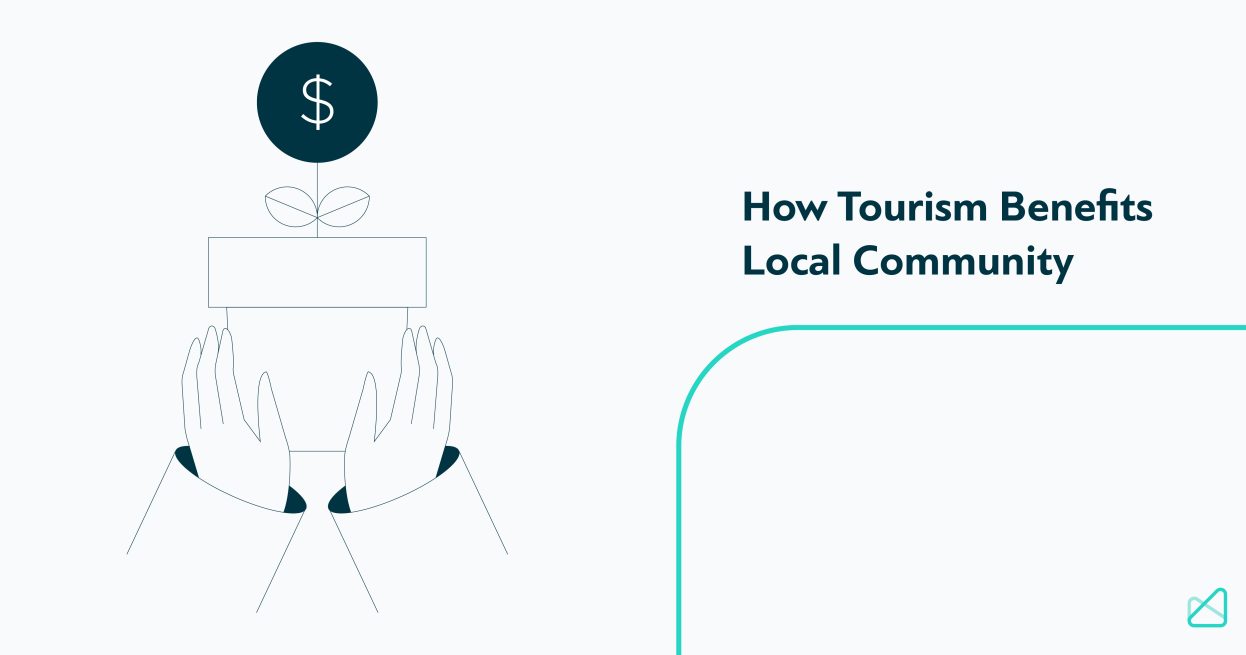
The Impact of Tourism on Local Communities
Economic benefits of tourism for local communities, social and cultural benefits of tourism, environmental benefits of tourism, challenges and solutions: managing tourism for community benefit.
Would you prefer to listen rather than read?👇🏼🎧
The tourism industry is a vertical with one of the most comprehensive impacts on economic and social landscapes. That’s precisely what makes it essential for macro- and micro-economies . Tourism can help generate additional revenue streams for local communities enabling locals to kickstart new businesses, rebuild and restore structures, and attract more tourists .
If you want to discover the impact of tourism on the local community, you’ve found an excellent resource. Below you can learn how tourism benefits local communities, real-life examples, and the most common challenges and solutions of managing tourism for community benefits.
To truly understand how tourism benefits local communities, you need to understand its impact. Let’s see the tourism industry’s power to shape communities socio-economically and its direct and indirect impacts on numerous aspects of local life.
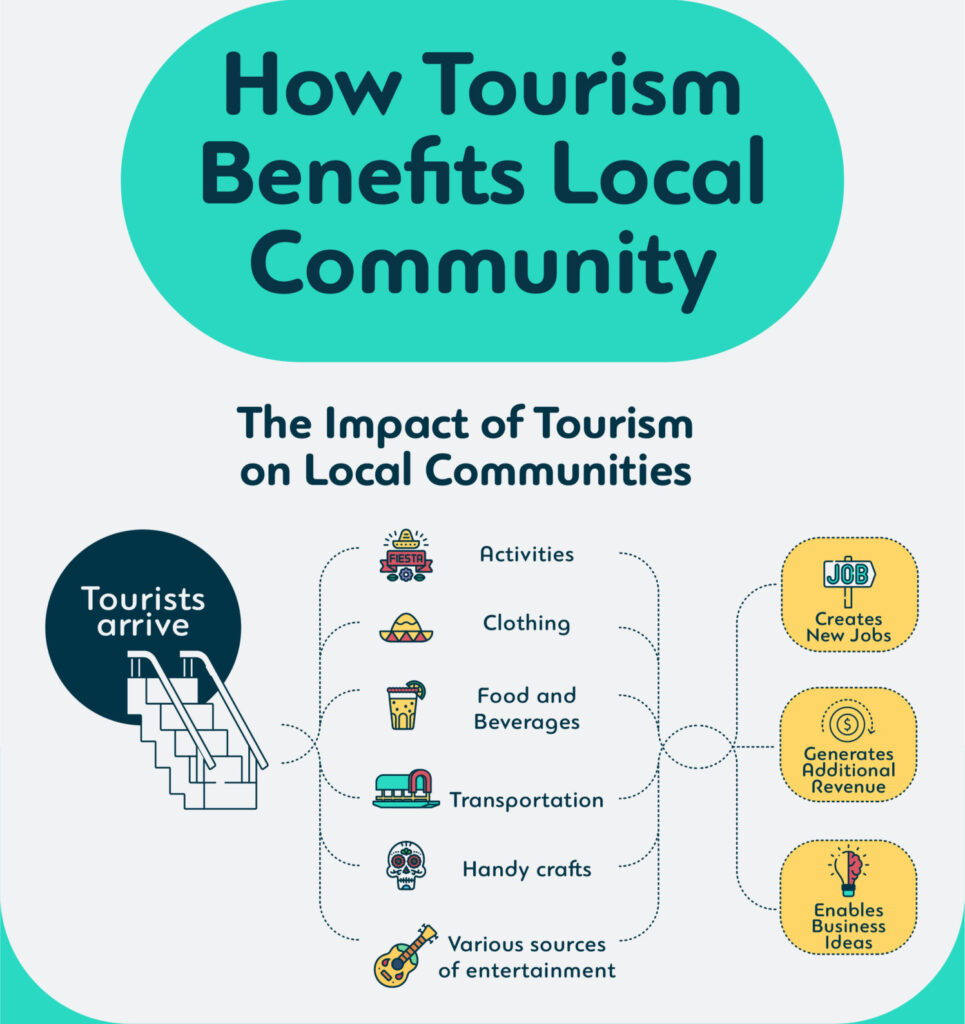
How tourism shapes communities socio-economically
The best way to recognize tourism’s potential to shape the social and economic aspects of local communities is to approach the subject with financial experts’ goggles on.
When many tourists arrive at a destination, their needs, expectations, and wants generate demand. The demand, in this instance, can be pretty diverse . New arrivals can generate demand for:
- Food and beverages
- Transportation
- Handy crafts
- Various sources of entertainment
This specific outcome has a positive economic impact on a community. It creates new jobs, generates additional revenue, and enables people to pursue various business ideas that were borderline impossible before the arrival of tourists.
The social impact follows the economic one. Local communities become more financially independent . Community participation in business activities enables it to become financially secure, stress-free, and experience feelings of ease and safety. However, tourism’s impact doesn’t end there. It has numerous direct and indirect effects on various aspects of local life.
The direct and indirect impacts of tourism on various aspects of local life
The subject of tourism’s impact on various aspects of local life has been of interest to researchers since the early 1980s . While the general consensus is that it is difficult to measure these effects, they are still there.
Tourism’s direct and indirect impacts can contribute to changes in the following ways:
- Value systems
- Individual behavior
- Family relationships
- Collective lifestyles
- Moral conduct
- Create expressions
- Traditional ceremonies
- Community organization
Now that you understand how tourism impacts local communities economically, we must dive deeper into the matter. Below you can find three unique economic benefits of tourism for local communities.
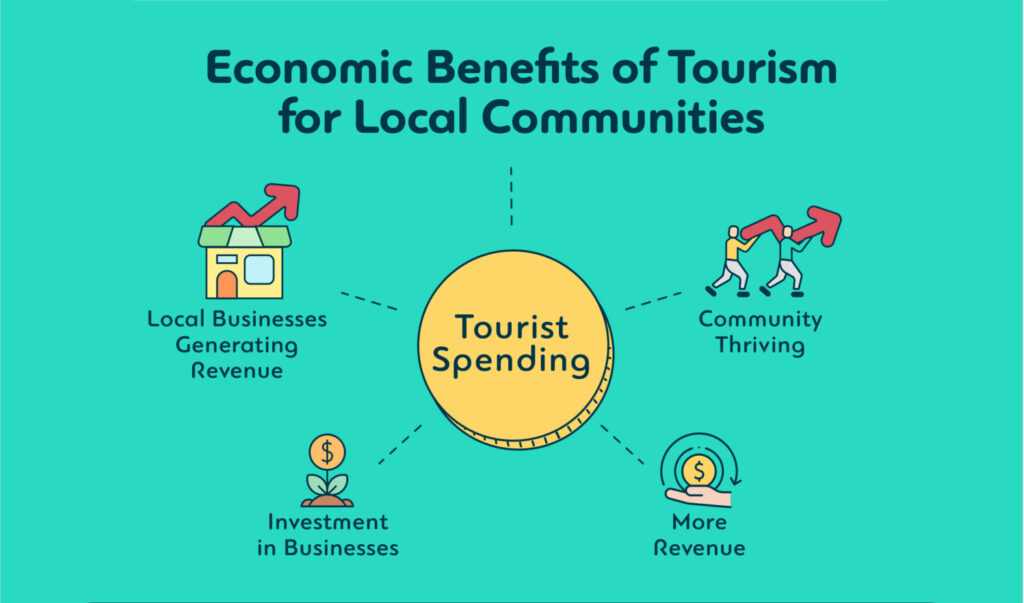
The multiplier effect: How tourist spending stimulates local economies
The multiplier effect directly results from tourists buying products and services in their destination. Tourists can buy a wide range of products and services while visiting or staying. These range from food, drinks, and transportation to locally produced goods and locally led excursions and activities.
Suddenly, you have local businesses of all sizes generating revenue. With the surplus in the local budget, the community can thrive. It increases not only their standard of life, but they can now invest in their businesses to make their products and services more attractive, thus generating repeat business and even more revenue.
Job creation: An in-depth look at how tourism creates employment opportunities
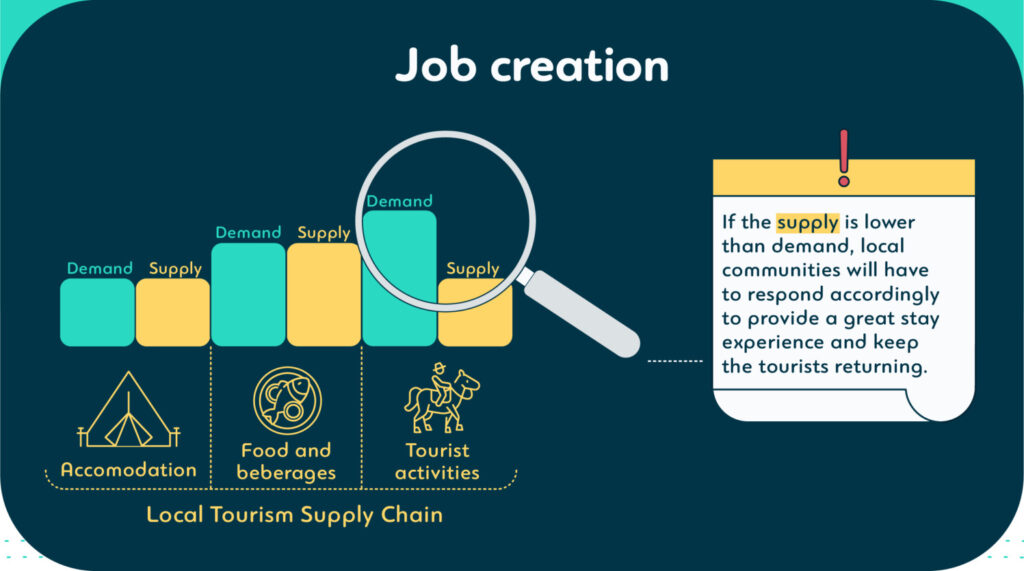
The most immediate benefit of tourism is job creation . The tourism services value chain consists of travel organization and reservations, transport from and to the destination, accommodation, food and beverages, and tourist activities. The last three items on this list are of interest to you.
In other words, local communities can benefit from job creation in accommodation, food and beverages, and tourist activities . How does this happen? Tourists create demand for products and services in these three categories. If the supply is lower than demand, local communities will have to respond accordingly to provide a great stay experience and keep the tourists returning.
Most often, new jobs will open in hotels, restaurants, small businesses, transportation companies, and tourist activity businesses.
Infrastructure development: Exploring how tourism funds improve local facilities and services
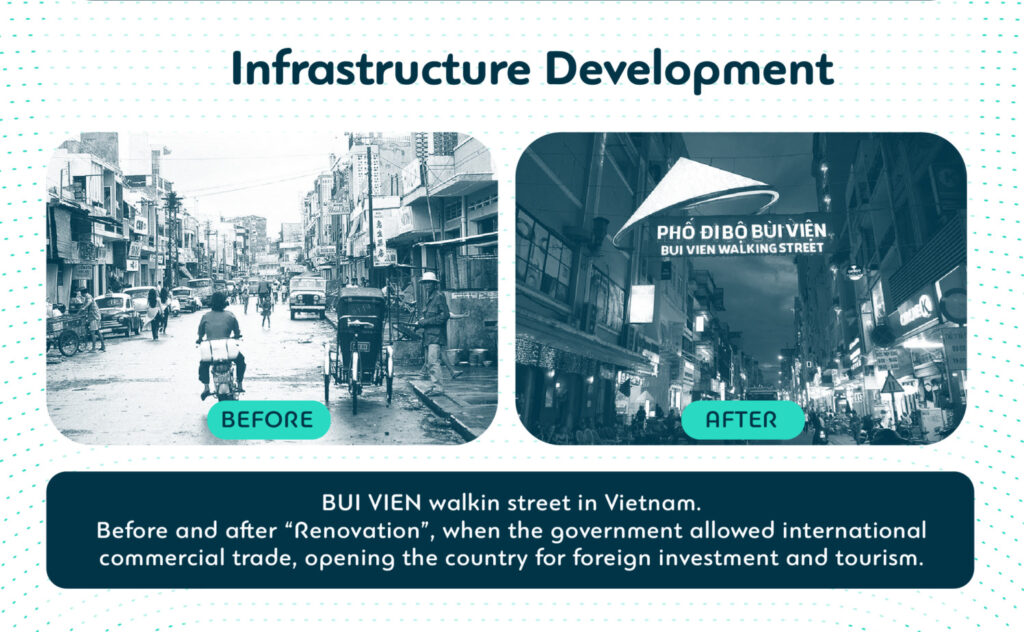
Remember that surplus in local budgets we’ve mentioned above? Local communities can now use it to facilitate infrastructure development which is yet another benefit of tourism for local communities. That’s perhaps the most noteworthy benefit because tourism infrastructure directly contributes to tourism growth and competitiveness .
The increasing funds in local businesses’ budgets and municipal budgets enable various projects. For instance, hotels can go through renovation and build new facilities; cities can renovate roads and build new ones to facilitate access to tourist attractions; they can invest in newer and better means of transportation, and so on. The bottom line, tourism funds can kickstart community-based tourism development overall.
Case study: A real-life example of a community that has economically benefited from tourism
Here is a real-life example to help you understand tourism’s importance to local communities. A case study of Bomborat Chital from 2018 is a perfect one to paint the picture of the economic benefits of tourism for local communities.
Over 92% of respondents said that tourism was vital for the economic development of their community and region. The respondents said that tourism led to an increase in:
- Household income
- Improved infrastructure
- Hotel business growth
- The capability of acquiring knowledge related to tourism and hotel management
Tourism has also helped increase the demand for local fresh and dry fruits, hand-crafted goods made by the locals, hotels, and transport.
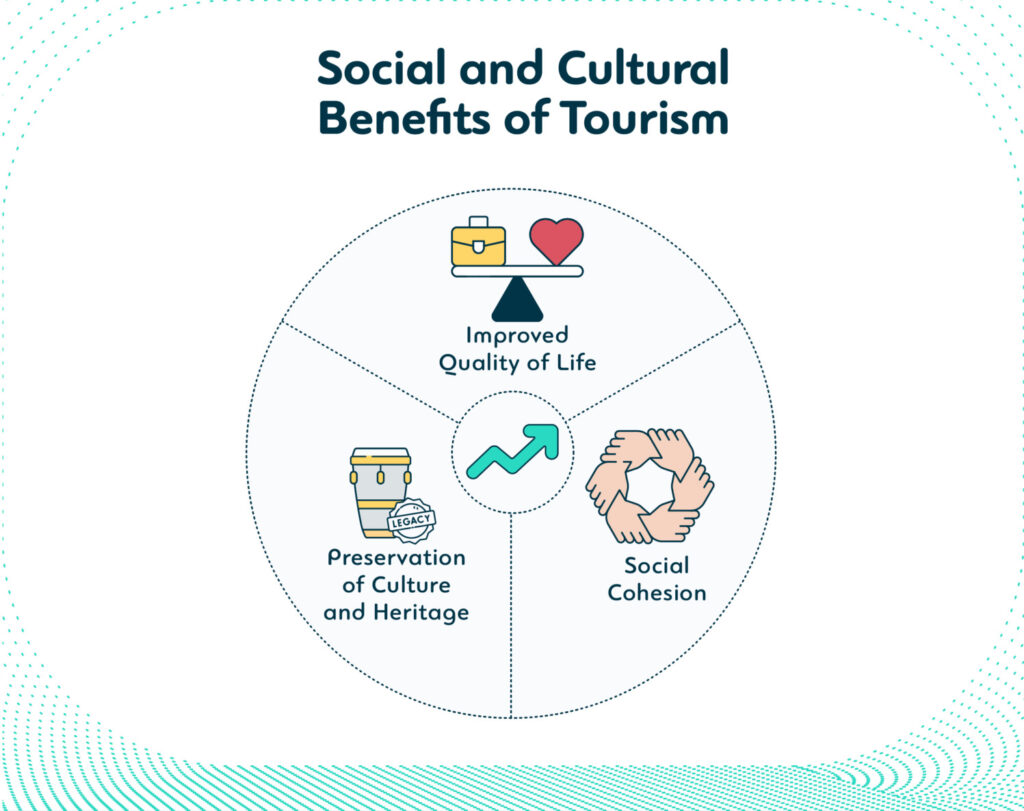
Tourism doesn’t offer only economic benefits to local communities. It can also bolster the social and cultural aspects of a local community. Let’s see how.
Preservation of culture and heritage: How tourism motivates communities to preserve and showcase their cultural assets
How can tourists motivate people to preserve and showcase their cultural assets? You probably know what cultural tourism is. Here is a quick reminder :
“Cultural tourism is a sub-segment of tourism which is focused on visiting destinations to experience and learn about a particular culture first-hand.”
Simply put, it creates demand for cultural assets. Cultural attractions can range from cuisine and national holidays to local outfits and customs. This demand can motivate communities to preserve the things that help them generate income.
Improved quality of life: Exploring how tourism’s economic impact can lead to enhanced living standards
Improved quality of life follows the economic benefits of tourism. The theory is rather straightforward – if families in certain regions have access to more income, their quality of life will improve. Such is the case with regions where tourism flourishes. Additional revenue streams and increased revenue can help people in certain regions achieve enhanced living standards.
Living standards include the level of wealth, material goods, comfort, and products and services available to a geographic area. Since tourism helps improve infrastructure, create new jobs, and generate repeat business, local communities can achieve an improved quality of life .
Social cohesion: Analysis of how tourism can bring communities together
Finally, tourism can help improve social cohesion and bring communities together. While the mechanism behind this benefit is not as obvious, it’s easy to understand it once your attention is brought to it.
Here is how it works: tourism creates opportunities for people from all socioeconomic tiers (wealth, income, race, education, and power). It also creates opportunities for people to learn and understand each other, thus promoting equality , collaboration, and working towards achieving a common goal despite their differences.
Case study: A real-life example of a community that has experienced social or cultural benefits from tourism
The Namibia tourism case study is an excellent example of how tourism can unlock social and cultural benefits. The country’s government has been focusing on tourism since the early 2000s. Initially, the primary goal was to promote and enable tourism purely for its economic benefits.
However, the government discovered that it also has cultural and social benefits. It enabled people to come and work together around a common cause. In this case, people came together to preserve cultural heritage. The tourism policy also included pro-poor aspects to help relieve poverty and facilitate the development of communities in rural areas.
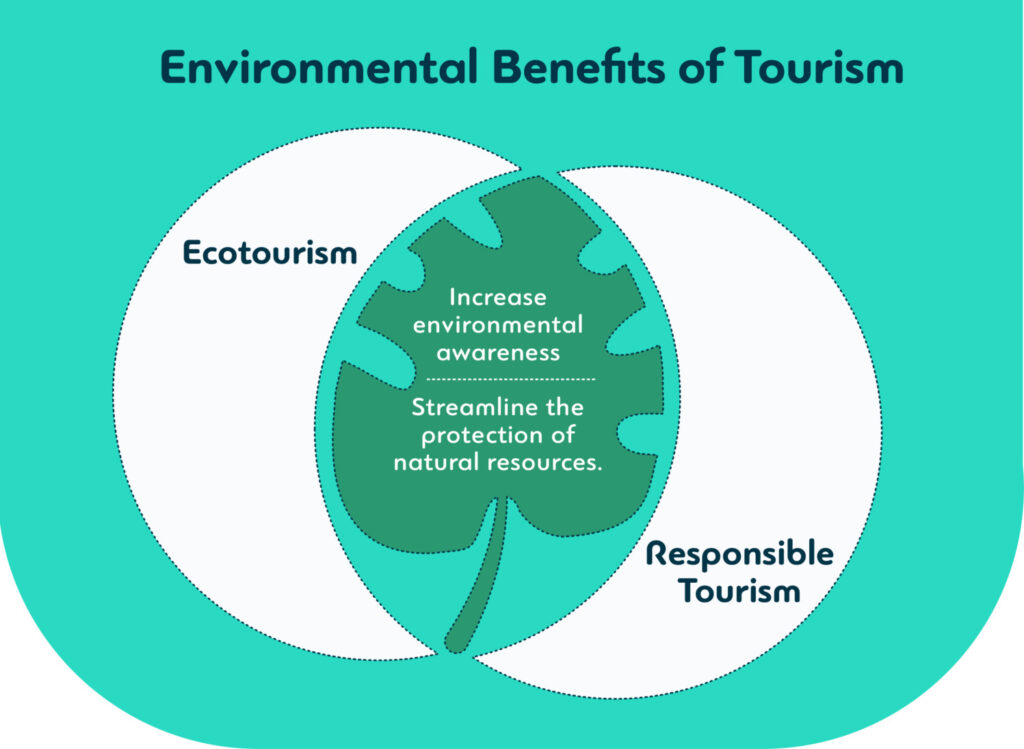
Ecotourism and responsible tourism are buzz works in the travel vertical. These types of tourism can help local communities conserve and preserve wildlife and natural wealth. Below you can find out more about the environmental benefits of tourism.
Conservation efforts: How tourism contributes to the preservation of natural resources
In some instances, wildlife and nature itself can be the main attractions and primary reason tourists come to visit. It’s a crystal clear message to local communities that they need to conserve these natural resources to keep generating income from tourism.
Plus, governments worldwide have joined together in the initiative to preserve nature . This double effect facilitates the entire initiative and helps motivate communities, even in rural areas, to start preserving nature and wildlife.
Sustainable tourism: The role of ecotourism in fostering environmental awareness and protection
Sustainable tourism is a broad concept. While it covers tourism experience, it also includes concerns for environmental issues. Governments with relevant policies try to enforce sustainability across industries in their effort to minimize their carbon footprint.
These policies apply to all communities. It helps increase environmental awareness and streamline the protection of natural resources.
Case study: A real-life example of a community that has benefited environmentally from tourism
Bhutan’s government developed an excellent policy to structure ecotourism, maintain community involvement, and still generate profits. Bhutan has a daily tariff every tourist must pay to experience what this country has to offer.
The tariff involves the necessary expenses such as hotel, food, tour guide, trekking equipment, and internal transportation. The enforced tariff ensured that only respectful and responsible tourists visited. In return, the communities in Bhutan can continue to effortlessly preserve nature and the environment overall.
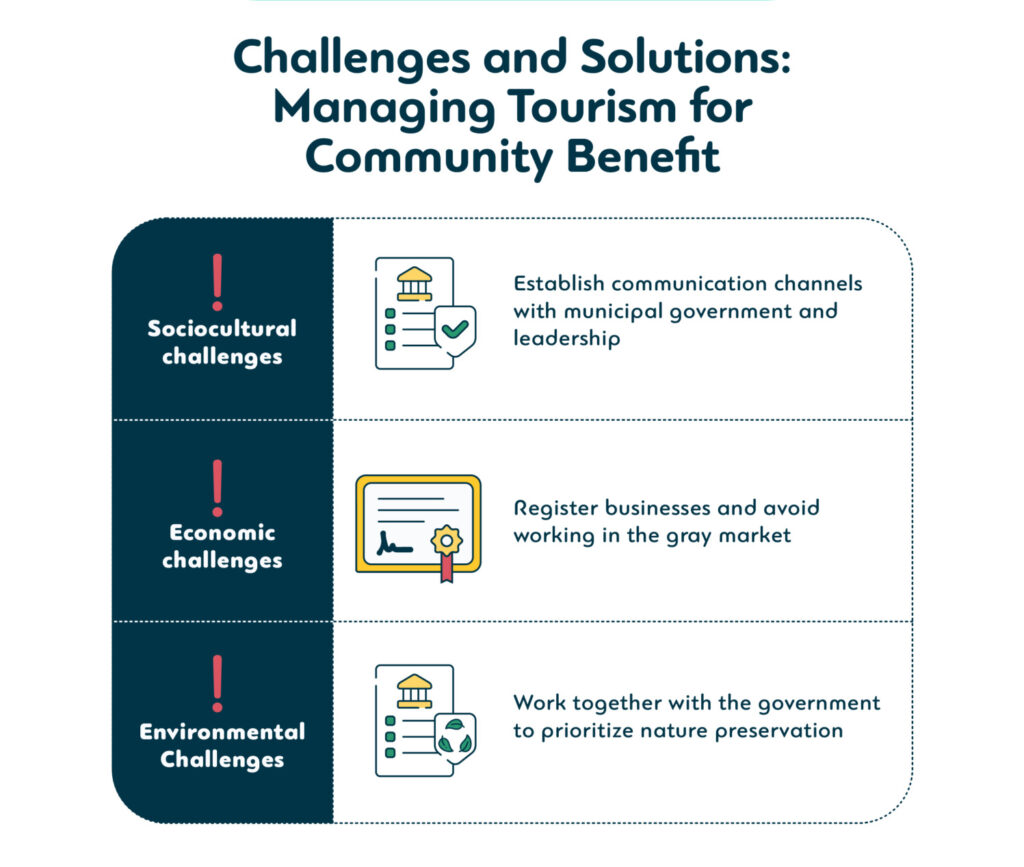
As you’ve seen in the previous example, the government played a vital role with its laws and regulations in enabling local communities to thrive while still reaping the benefits of tourism. What are the potential negative impacts tourism can have then? Let’s see.
Analysis of potential negative impacts of tourism on local communities
Many things can lead to negative impacts of tourism on local communities. A recent study reveals that the most common factors are:
- Inadequate government planning,
- Policies and regulations,
- Insufficient knowledge and skills of tour operators,
- and the broader social issues .
Below you can find the potential challenges that can impact three areas, including strategies for communities to maximize benefits while minimizing potential drawbacks of tourism.
Sociocultural challenges
Tourists with little to no awareness can irritate the local communities by failing to respect local customs and values.
The best strategy would be for local communities to establish open communication channels with municipal government and leadership. Working together, they need to come up with relevant policies and regulations.
Write brochures and put on relevant signage to communicate local customs, rules of conduct, and other important information .
Economic challenges
Overcrowding can worsen the sanitation status and break down already poor infrastructure. Local communities should always register businesses and avoid working in the gray market because it not only brings tax income to local budgets but provides legal protection.
Local communities should only collaborate with reputable and licensed tour operators. These practices can secure enough funds in local budgets to help preserve the sanitation status and streamline infrastructure maintenance and improvements.
Environmental Challenges
Overcrowding and poor regulations can disrupt nature and wildlife, thus indirectly affecting communities and making destinations less attractive to tourists.
Local communities can thwart this risk in multiple ways. For instance, with sufficient money in local budgets, they can fund nature preservation societies, launch voluntourism projects, and work together with the government to prioritize nature preservation.
As you can see, tourism benefits local communities in several ways. Economic benefits include local economic stimulation, job creation, and infrastructure developmen t. Social and cultural benefits include improved quality of life and social cohesion. And environmental benefits include improved conservation, preservation, and promotion of sustainable tourism.
The role of tourism is crucial for community development and enrichment. Yes, it also comes with adverse effects, but with the right strategies, such as collaboration with local governments, communities can overcome these challenges and start generating revenue .
The most noteworthy strategies include having relevant rules, regulations, and policies. It’s also essential to maintain communication with the government. There has to be a plan with clearly defined goals followed by a comprehensive strategy and execution timeline.
Collaboration with tour operators and local government can help local communities manage the negative impacts of tourism. Preventing overcrowding and staying true to sustainable practices is paramount in this instance.
Local government plays a vital role in promoting sustainable tourism. Enforcing relevant rules and regulations can help the community develop better behavior patterns and join forces in promoting sustainable tourism.
Local businesses should definitely establish some sort of online presence. Initially, a simple website and social media profile are more than enough.
Tourism can help local communities thrive. One of the aspects positively affected by tourism is real estate, as tourism can drive real estate prices.
People from the community perform tourism activities, making them essential for tourism development. It means that the community is always involved in tourism development.
Some tourism types, such as volunteerism, can bring educators from around the world to teach people in local communities new skills. Also, the government can recognize the potential of certain regions enabling people to take on government-funded courses.

Subscribe to our newsletter
Yay you are now subscribed to our newsletter.
Cristóbal Reali, VP of Global Sales at Mize, with over 20 years of experience, has led high-performance teams in major companies in the tourism industry, as well as in the public sector. He has successfully undertaken ventures, including a DMO and technology transformation consulting. In his role at Mize, he stands out not only for his analytical and strategic ability but also for effective leadership. He speaks English, Spanish, Portuguese, and Italian. He holds a degree in Economics from UBA, complementing his professional training at Harvard Business School Online.
Mize is the leading hotel booking optimization solution in the world. With over 170 partners using our fintech products, Mize creates new extra profit for the hotel booking industry using its fully automated proprietary technology and has generated hundreds of millions of dollars in revenue across its suite of products for its partners. Mize was founded in 2016 with its headquarters in Tel Aviv and offices worldwide.
Related Posts

Travel Management: What It Is & How It Transforms Corporate Travel
17 min. From international tech sellers to big-time pharmaceutical companies, businesses with extensive travel needs come in all sizes and industries. How do they ensure their employees have positive, safe, and budget-friendly travel experiences? The answer is effective travel management. For businesses in the tourism industry, travel management programs and systems are an integral part […]

Sustainable Tourism Development: Protecting the Environment and Supporting Local Communities
13 min. Poor tourism practices harm the planet. It’s hard to think about that while you’re flying into the sunset and swimming with dolphins, but our travel choices often negatively impact people and wildlife. Sustainable tourism development can help mitigate and improve that. According to the Ecotourism Global Market Report by The Business Research Company, […]

What Is a Tourist Flow? 6 Characteristics
5 min. En las últimas décadas, el turismo ha experimentado un crecimiento notable, pasando de ser una actividad elitista a un fenómeno de masas. De acuerdo a la OMT, el volumen de negocio del turismo hoy en día iguala, o incluso supera, a las exportaciones de petróleo, automóviles o productos alimenticios. Se trata de una […]
Advertisement
Socio-Economic and Environmental Impacts of Tourism on Local Community in Gilgit Baltistan, Pakistan: a Local Community Prospective
- Published: 12 January 2022
- Volume 14 , pages 180–199, ( 2023 )
Cite this article

- Yasir Jehan ORCID: orcid.org/0000-0003-2158-4386 1 ,
- Muzian Batool 2 ,
- Naveed Hayat 3 &
- Dostdar Hussain 2
2641 Accesses
11 Citations
Explore all metrics
Tourism has a great potential to change the structure of the economy both in developed and developing countries. Tourism development in a region has both pros and cons for local communities. On one side, it boosting up economic growth and provide various facilities to the locals. On the other side, it is creating many negative externalities such as the communities are expected to agonize from traffic jams, crowding, increasing the crime rate, destruction of the environment and natural resources, and most prominently disturbed the community’s norms and culture. The main objective of this study is to explore the perception of local community regarding socio-economic, environmental, and cultural impact of tourism. The secondary objective of the study is to evaluate the local community participation in tourism development. To accomplish these objectives, primary data has been collected from 305 respondents in Skardu, Gilgit Baltistan, Pakistan, through questionnaire. For empirical analysis, the study used varimax-rotated matrix. Results reveal that tourism activities in the region of Gilgit Baltistan improve the economic status of the members of the local community. However, tourism negatively affects the natural environment of the region and disturbed the community’s norms and culture. The local government should provide incentives to the local people and involve them in developmental decision to update their lifestyle. The findings of the study also provide insight to the tourist not to involve in unethical activities which can destroy the local norms and culture. The study also provides suggestions to the local people to cooperate and host the tourists in a better way so that they come again and again.
Graphic Abstract
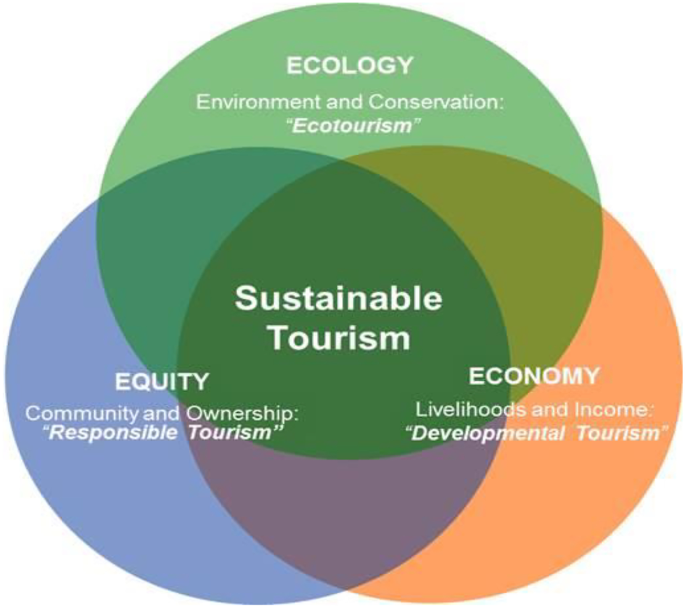
This is a preview of subscription content, log in via an institution to check access.
Access this article
Subscribe and save.
- Get 10 units per month
- Download Article/Chapter or eBook
- 1 Unit = 1 Article or 1 Chapter
- Cancel anytime
Price includes VAT (Russian Federation)
Instant access to the full article PDF.
Rent this article via DeepDyve
Institutional subscriptions
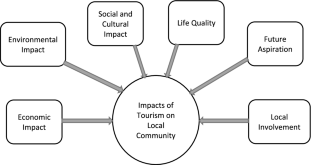
Similar content being viewed by others

Residents’ Perception of Overtourism, Tourism Impacts and Economic Dependence in Gökceada Island

The Economical and Social Impacts of Tourism on Kharga Oasis Local Citizens in Egypt
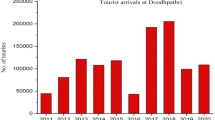
Assessing indigenous community’s perspectives and attitudes toward tourism development impacts in the northwestern Himalayas, India
Availability of data and materials.
The authors collected primary data and will be provided on request.
Aall, C., Klepp, I. G., Engeset, A. B., Skuland, S. E., & Støa, E. (2011). Leisure and sustainable development in Norway: part of the solution and the problem. Leisure Studies , 30 (4), 453-476.
Adnan Hye, Q. M., & Ali Khan, R. E. (2013). Tourism-led growth hypothesis: A case study of Pakistan. Asia Pacific Journal of Tourism Research, 18 (4), 303–313. https://doi.org/10.1080/10941665.2012.658412
Article Google Scholar
Ahn, B., Lee, B., & Shafer, C. S. (2002). Operationalising sustainability in regional tourism planning: An application of the limits of acceptable change framework. Tourism Management, 23 , 1–15. https://doi.org/10.1016/S0261-5177(01)00059-0
Almeida-García, F., Peláez-Fernández, M. Á., Balbuena-Vázquez, A., & Cortés-Macias, R. (2016). Residents’ perceptions of tourism development in Benalmádena (Spain). Tourism Management, 54 , 259–274. https://doi.org/10.1016/j.tourman.2015.11.007
Alshuwaikhat, H. M. (2005). Strategic environmental assessment can help solve environmental impact assessment failures in developing countries. Environmental Impact Assessment Review, 25 (4), 307–317. https://doi.org/10.1016/j.eiar.2004.09.003
Andereck, K. L., & Nyaupane, G. P. (2011). Exploring the nature of tourism and quality of life perceptions among residents. Journal of Travel Research , 50 (3), 248–260. https://doi.org/10.1177/2F0047287510362918
Andereck, K. L., Valentine, K. M., Knopf, R. C., & Vogt, C. A. (2005). Residents’ perceptions of community tourism impacts. Annals of Tourism Research , 32 (4), 1056-1076.
Baloch, Q. B. (2007). Managing tourism in Pakistan: A case study of Chitral valley. Journal of Managerial Sciences , 2(2), 169–190. http://www.academia.edu/download/38364352/01_qadar_bakhsh.pdf
Buckley, R. (2012). Sustainable tourism: Research and reality. Annals of Tourism Research, 39 (2), 528–546. https://doi.org/10.1016/j.annals.2012.02.003
Chang, S. C., & Lee, M. S. (2008). The linkage between knowledge accumulation capability and organizational innovation. Journal of Knowledge Management . https://doi.org/10.1108/13673270810852359
Charara, N., Cashman, A., Bonnell, R., & Gehr, R. (2011). Water use efficiency in the hotel sector of Barbados. Journal of Sustainable Tourism, 19 (2), 231–245. https://doi.org/10.1080/09669582.2010.502577
Crotti, R., & Misrahi, T. (2017). The travel & tourism competitiveness report 2017. Paving the way for a more sustainable and inclusive future. In World Economic Forum : Geneva, Switzerland (p. 2017). https://www.weforum.org/reports/the-travel-tourism-competitiveness-report-2017
Diedrich, A., & García-Buades, E. (2009). Local perceptions of tourism as indicators of destination decline. Tourism Management, 30 (4), 512–521. https://doi.org/10.1016/j.tourman.2008.10.009
Ferreira, F. A., Castro, C., & Gomes, A. S. (2020, October). Positive and negative social-cultural, economic and environmental impacts of tourism on residents. In International Conference on Tourism, Technology and Systems (pp. 288–298). Springer, Singapore.
Garau-Vadell, J. B., Gutierrez-Taño, D., & Diaz-Armas, R. (2018). Economic crisis and residents’ perception of the impacts of tourism in mass tourism destinations. Journal of Destination Marketing & Management, 7 , 68–75. https://doi.org/10.1016/j.jdmm.2016.08.008
Goleldner, C., Ritchie, B., & McIntosh, R. (2000). Tourism–Principles, Practices, Philosophies, New York : J. Willey & Sons . http://www.semesteratsea.org/wp-content/uploads/sas_courses/Huijbens_NRRT270_Natural_Resource_Tourism_Syllabus.pdf
Gössling, S. (2002). Global environmental consequences of tourism. Global Environmental Change , 12 (4), 283-302.
Gumus, F., Eskin, I., Veznikli, A. N., & Gumus, M. (2007). Availability of rural tourism for Gallipoli villages: the potentials and attitudes. International Tourism Biennial conference , Turkey, 157.
Harrill, R., & Potts, T. D. (2003). Tourism planning in historic districts: Attitudes toward tourism development in Charleston. Journal of the American Planning Association, 69 (3), 233–244.
Khalil, S., Kakar, M. K., & Malik, A. (2007). Role of tourism in economic growth: Empirical evidence from Pakistan economy [with comments]. The Pakistan Development Review , 985–995.
Ko, D. W., & Stewart, W. P. (2002). A structural equation model of residents’ attitudes for tourism development. Tourism Management, 23 (5), 521–530.
Lindberg, K., & Johnson, R. L. (1997). Modeling resident attitudes toward tourism. Annals of Tourism Research , 24 (2), 402-424.
Linderová, I., Scholz, P., & Almeida, N. (2021). Attitudes of local population towards the impacts of tourism development: Evidence from Czechia. Frontiers in Psychology, 12 , 684773. https://doi.org/10.3389/fpsyg.2021.684773
Liu, H. (2020). The socio-economic impacts of tourism development in Sierra Leone: A pilot study. European Business & Management, 6 (6), 128.
McCool, S. F., Moisey, R. N., & Nickerson, N. P. (2001). What should tourism sustain? The disconnect with industry perceptions of useful indicators. Journal of Travel Research, 40 (4), 124–131.
Nunkoo, R., & Ramkissoon, H. (2009). Small island urban tourism: A residents’ perspective., Routledge, 13 (1), 37–60.
Nunkoo, R., & Ramkissoon, H. (2011). Developing a community support model for tourism. Annals of Tourism Research, 38 (3), 964–988.
Rana, S. (2015). High-involvement work practices and employee engagement. Human Resource Development International, 18 (3), 308–316.
Sadiq, M., Othman, Z., & Keong, O. C. (2019). A study of interaction effects of political influences and earnings management on organisational performance. Asian Economic and Financial Review , 9 (5), 642-653.
Shujahi, A. H., & Hussain, A. (2016). Economic and environmental costs of tourism: Evidence from District Abbottabad. Islamabad: Pakistan Institute of Development Economics (PIDE).
Sinclair, M. T. (1998). Tourism and economic development: A survey. The Journal of Development Studies, 34 (5), 1–51.
Snaith, T., & Haley, A. J. (1999). Residents’ opinion of tourism development in the historic city of York. England. Tourism Management, 20 (1), 595–603.
Sofronov, B. (2017). The economic impact on global tourism. Annals of Spiru Haret University . Economic Series , 17 (2), 127–139.
Sunlu, U. (2003). Environmental impacts of tourism. In Conference on the Relationships between Global Trades and Local Resources in the Mediterranean Regio n (pp. 263–270).
Tosun, C. (2002). Host perceptions of impacts: A comparative tourism study. Annals of Tourism Research , 29 (1), 231–253.
Twining-Ward, L., & Butler, R. (2002). Implementing STD on a small island: Development and use of sustainable tourism development indicators in Samoa. Journal of Sustainable Tourism, 10 (5), 363–387.
Wall, G., & Mathieson, A. (2006). Tourism: Change, impacts, and opportunities. Pearson Education .
Download references
Author information
Authors and affiliations.
Department of Economics, Bacha Khan University, Charsadda, KPK, Pakistan
Yasir Jehan
Department of Management, University of Baltistan Skardu, Skardu, Pakistan
Muzian Batool & Dostdar Hussain
Department of Economics and Business Administration, University of Education, Lahore, Pakistan
Naveed Hayat
You can also search for this author in PubMed Google Scholar
Corresponding author
Correspondence to Yasir Jehan .

Ethics declarations
Ethics approval.
The ethical issues, including plagiarism, informed consent, misconduct, data fabrication and/or falsification, double publication and/or submission, and redundancy have been completely observed by the authors.
Consent for Publication
Not applicable.
Competing Interests
The authors declare no competing interests.
Additional information
Publisher's note.
Springer Nature remains neutral with regard to jurisdictional claims in published maps and institutional affiliations.
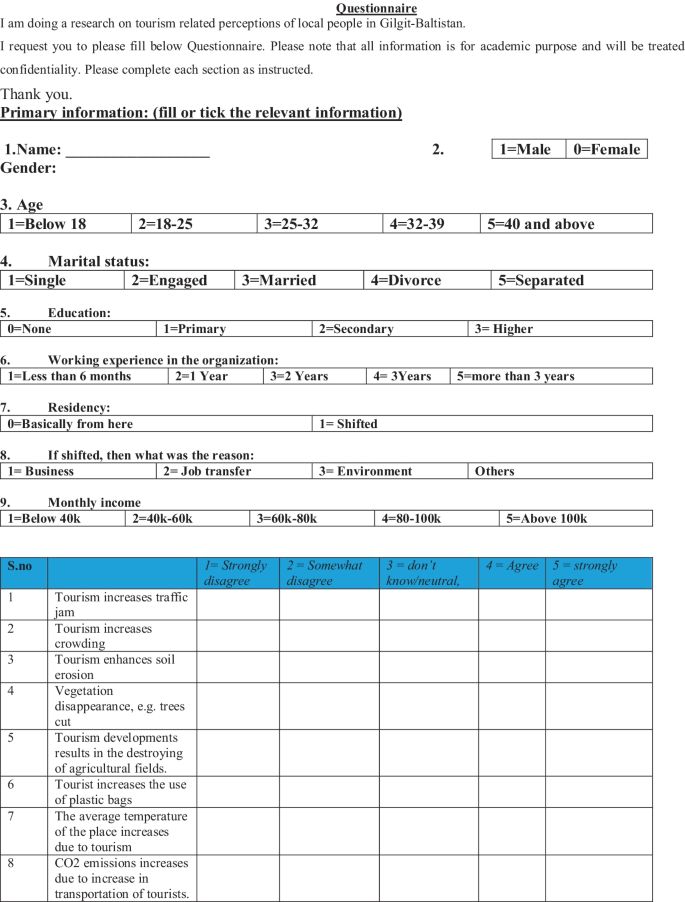
Rights and permissions
Reprints and permissions
About this article
Jehan, Y., Batool, M., Hayat, N. et al. Socio-Economic and Environmental Impacts of Tourism on Local Community in Gilgit Baltistan, Pakistan: a Local Community Prospective. J Knowl Econ 14 , 180–199 (2023). https://doi.org/10.1007/s13132-021-00885-9
Download citation
Received : 13 October 2020
Accepted : 22 December 2021
Published : 12 January 2022
Issue Date : March 2023
DOI : https://doi.org/10.1007/s13132-021-00885-9
Share this article
Anyone you share the following link with will be able to read this content:
Sorry, a shareable link is not currently available for this article.
Provided by the Springer Nature SharedIt content-sharing initiative
- Environment
- Local community
- Varimax-rotated matrix
JEL Classification
- Find a journal
- Publish with us
- Track your research
Academia.edu no longer supports Internet Explorer.
To browse Academia.edu and the wider internet faster and more securely, please take a few seconds to upgrade your browser .
Enter the email address you signed up with and we'll email you a reset link.
- We're Hiring!
- Help Center

The Impacts of Tourism on Local Communities: Developing and Operationalising a Comprehensive Monitoring Framework

Monitoring the impacts of tourism in local communities ensures sustainable tourism development. In order to do so effectively, a monitoring framework is essential. Surprisingly, there has been no scholarly attention on the development and operationalization of a comprehensive framework to monitor the impacts of tourism. Similarly, the post-1999 era has not seen the development of new or improvements to existing theories on tourism impacts and residents' reactions. This study fills the above research gap by developing and ...
Related Papers
Laurie Murphy
In the field of tourism impacts research it is often assumed that certain characteristics of tourism are related to the nature and extent of tourism impacts on the destination’s community well-being. However, a standard set of measures for tourism that allows comparison between destinations and facilitates the establishment of causal relationships between specific characteristics of tourism and associated impacts has not yet been established. Previously, Faulkner and Tideswell [Faulkner, B., & Tideswell, C. (1997). A Framework for Monitoring Community Impacts of Tourism. Journal of Sustainable Tourism, 5(1), 3 - 28] introduced a framework for monitoring social impacts of tourism, which identifies four facets of tourism in a destination: stage of tourism development, visitor-resident contact, types of visitors, and seasonality. A set of objective measures for those facets has been devised and tested on three tropical Australian regional communities. This paper reports on the process ...
J . A. R . C . Sandaruwani
Tourism has significant potentials for generating positive social, cultural and economic benefits depending on how tourism activities are managed and developed. However, tourism also has the potential to generate more negative outcomes. Therefore, the objectives of this study are first; to examine the impacts of tourism development on local communities, second; to recognize the attitudes and perception of local communities towards tourism development in their neighbourhoods. The study is based on the data gathered from 108 families in three villages to analysis the attitudes and perceptions of local communities towards tourism development. Additionally, six unstructured interviews were conducted with government officers of these villages to get the precise understanding of the tourism development in local communities and its impacts. The study reveals inadequate government planning, policies and regulations, insufficient knowledge and skills of tour operators, and the broader social...
Annals of Tourism Research
Liz Fredline
Tourism and hospitality management
Ksenija Vodeb
Purpose – The impact of tourism is an ongoing research interest among scholars as it is directly related to the tourism development process. Residents’ perceptions of tourism impacts can indicate development guidelines if planners pay attention to them. Design – We examine residents’ perceptions of tourism impacts and their support for sustainable tourism development in two similar tourism destinations, Portorož and Opatija, based on their similarity, closeness, and connectedness through time to the present. Approach – There is an urgent need for a strategic development change for both destinations, which are coping with typical negative impacts of tourism, including seasonality, noise and, overcrowding. Methodology – Four hundred and forty-six residents surveyed indicated that tourism development is an important issue. Two databases were combined in order to conduct inference data analysis using SPSS 21 statistical software. Depending on the type of variables, t-test and ANOVA were...
International Journal of Hospitality & Tourism Administration
Sedat AZAKLI , Huseyin Ozgur , Ekrem Tatoglu , Fuat Erdal
Asian Social Science
marof redzuan
ChongKin Wong
Richard Knopf
RELATED PAPERS
Lusiana D Ningrum
Pratik Borase
International Journal for Research in Applied Science and Engineering Technology
Shreenidhi Sriram
Start Fleet III
Maamar Missoum
Magis, Revista Internacional de Investigación en Educación, 16, 1–13.
Aldo Ocampo González
Jean MARIZI à Montpellier
Francis Hernandez
Marion Bolder-Boos
Marilena Maniaci
Alfredo Akbar
Egbunu O G A L A S . Justin
Despina Vlami, Mercanti Greci a Livorno 1750 - 1868 / Commercio Nazione Famiglia
ETPbooks (Enzo Terzi) , Despina Vlami
Springer eBooks
Mehmet Kitapci
Teroris Wyien
Pain Narratives in Greco-Roman Writings. Studies in the Representation of Physical and Mental Suffering
Han N Baltussen
Pascal Delwit
International Journal of Environmental Research and Public Health
mehrsadat mahdizadeh
Joseph Johny
EBioMedicine
Michael McCaleb
哪里办理菲莎河谷大学毕业证 ufv毕业证学位证书范本Offer原版一模一样
Kroniek Tijdschrift Historisch Amersfoort Jg 13 Nr 2 P 2 5
Gerard Raven
ED-MEDIA 2004
Gurminder Singh
European Journal of Nuclear Medicine and Molecular Imaging
Vassilis Mpalaris
Kwartalnik Historii Kultury Materialnej
Edmund Kizik
Seyla Benhabib
RELATED TOPICS
- We're Hiring!
- Help Center
- Find new research papers in:
- Health Sciences
- Earth Sciences
- Cognitive Science
- Mathematics
- Computer Science
- Academia ©2024
Winter is here! Check out the winter wonderlands at these 5 amazing winter destinations in Montana
- Travel Tips
What Are The Benefits Of Tourism To The Local Community
Published: December 12, 2023
Modified: December 28, 2023
by Carissa Luciano
- Plan Your Trip
- Sustainability
Introduction
Tourism has become a vital component of the global economy, with millions of people traveling to explore new destinations every year. However, the impact of tourism extends far beyond the experiences of individual travelers. It plays a crucial role in benefiting the local communities at these destinations, creating a ripple effect that brings about economic, social, and environmental advantages.
In this article, we will delve into the benefits of tourism to the local community and explore how it contributes to job creation, small business support, increased tax revenue, infrastructure development, cultural preservation, environmental conservation, social and cultural exchange, and community pride and wellbeing.
As travelers journey to different places, they not only enrich their own lives but also make a positive impact on the local community. By understanding the advantages of tourism, we can appreciate the powerful role it plays in fostering economic growth, preserving culture, and improving the overall quality of life for the local residents.
Economic Benefits
One of the significant advantages of tourism to the local community is the boost it provides to the economy. Tourism brings in revenue from visitor spending on accommodation, food, transportation, and various tourist activities. This influx of money stimulates economic growth and creates a range of opportunities for the local population.
Job Creation:
The tourism industry is labor-intensive and creates a wide array of employment opportunities. From hotel staff and tour guides to restaurant workers and transportation providers, local residents are able to secure jobs that support their livelihoods and contribute to the growth of the community. Additionally, tourism-related industries such as souvenir shops, handicraft markets, and local food vendors also benefit from the increased demand created by tourists.
Small Business Support:
With the influx of visitors, small businesses often experience a surge in customer base. Locally-owned shops, restaurants, guesthouses, and tour operators have the chance to thrive and expand their operations. Not only does this lead to increased revenue for these businesses, but it also helps to diversify the local economy and reduce dependency on a single industry.
Increased Tax Revenue:
Tourism generates tax revenue for the local government through various channels, including hotel taxes, airport fees, and sales taxes on tourist expenditures. This additional income allows the government to invest in public services and infrastructure, such as improved roads, healthcare facilities, schools, and recreational areas. Ultimately, the community benefits from having better public services and a higher standard of living.
Infrastructure Development:
To accommodate the needs of tourists, destinations often invest in improving their infrastructure, including transportation systems, airports, roads, and public facilities. These developments not only enhance the experience for visitors but also provide long-term benefits for the local community. Improved infrastructure can attract more tourists, facilitate trade and commerce, and create better connectivity for residents.
Overall, the economic benefits of tourism extend far beyond the immediate impact of visitor spending. It has the potential to transform local economies, create jobs, and improve the overall quality of life for the residents. By embracing and nurturing the tourism industry, communities can harness its economic potential to bring about lasting prosperity.
Job Creation
One of the most significant benefits of tourism to the local community is the creation of employment opportunities. The tourism industry is known for its labor-intensive nature, offering a wide range of jobs that cater to various skill sets and educational backgrounds. These jobs not only provide income for individuals but also contribute to the overall economic growth of the community.
Tourism creates direct and indirect employment opportunities in several sectors. In the hospitality industry alone, hotels, resorts, and guesthouses require staff for front desk services, housekeeping, food and beverage, and maintenance. Tour operators and travel agencies employ tour guides and travel agents to cater to the needs of visitors. Additionally, restaurants, cafes, and bars hire chefs, waitstaff, and bartenders to cater to the dining preferences of tourists.
Aside from the tourism-specific roles, there are also indirect employment opportunities in supporting industries. For instance, transportation services such as taxis, buses, and rental cars require drivers and mechanics. Local farmers and suppliers benefit from the increased demand for fresh produce and ingredients in restaurants and hotels. Craftsmen, artisans, and souvenir shop owners can thrive by catering to the growing demand for authentic local products.
Job creation in the tourism industry offers a range of benefits to the local community. Firstly, it reduces unemployment rates and provides individuals with the means to support themselves and their families. Jobs in the tourism sector often offer opportunities for career growth and skill development, allowing individuals to enhance their professional prospects.
Furthermore, the creation of employment opportunities in the tourism sector can help diversify the local economy. Relying on a single industry for economic stability can be risky, but a well-developed tourism sector can counterbalance the effects of economic fluctuations in other sectors. This diversification promotes stability and ensures a more prosperous future for the community.
In some cases, tourism can also lead to the revival of traditional skills and crafts. Local artisans and craftsmen who were struggling to sustain their livelihoods may find renewed opportunities to showcase their talents and preserve their cultural heritage. This not only adds value to the destination’s tourism offerings but also contributes to the preservation of cultural traditions and customs.
Overall, job creation through tourism plays a crucial role in empowering individuals, stimulating economic growth, and preserving cultural heritage. It provides a means for individuals to earn a living and contribute to the local community, while also strengthening the overall economic resilience and cultural identity of the destination.
Small Business Support
One of the significant benefits of tourism to the local community is its support for small businesses. When tourists visit a destination, they often seek out unique experiences and products that are representative of the local culture. This presents an excellent opportunity for small businesses to showcase their offerings and thrive in the tourism industry.
Small businesses such as local restaurants, cafes, guesthouses, boutique shops, and handicraft vendors play a crucial role in enriching the tourism experience. They offer a more authentic and personalized touch compared to larger chain establishments. Visitors are often eager to explore these smaller, locally-owned businesses to get a taste of the local culture and support the community.
By supporting small businesses, tourists contribute to the preservation and promotion of the destination’s unique cultural heritage. Local artisans and craftsmen who specialize in traditional crafts, such as pottery, weaving, or woodcarving, have an opportunity to showcase their skills and attract customers looking for unique souvenirs. Buying from these artisans not only supports their livelihoods but also helps to preserve cultural traditions that may otherwise be at risk of being lost.
Furthermore, small businesses in the tourism industry create a ripple effect of economic benefits within the community. When tourists visit a destination and spend their money at local businesses, the revenue generated circulates within the local economy. This supports other businesses in the community, from suppliers of raw materials to transport providers and service industries.
Moreover, small businesses often contribute to the uniqueness and diversity of the destination. They offer a more personalized and customized experience compared to larger corporate establishments. Visitors appreciate the local expertise, personalized service, and authentic products offered by these small businesses.
Tourism can also help to revitalize and rejuvenate struggling neighborhoods or districts. When tourists frequent small businesses in these areas, it can stimulate economic growth and encourage further investment and development. As a result, these locations see an increase in foot traffic, which can lead to the revitalization of vacant properties and the creation of new opportunities for local entrepreneurs.
Overall, the support and patronage of small businesses by tourists not only benefit the owners but also contribute to the overall economic growth, cultural preservation, and uniqueness of a destination. By choosing to engage with local businesses, tourists become active participants in the sustainable development of the local community.
Increased Tax Revenue
Another significant benefit of tourism to the local community is the increased tax revenue that it generates. When tourists visit a destination, their spending on accommodations, dining, transportation, and activities results in the collection of various taxes, which directly benefit the local government and community.
Hotel Taxes: Many destinations impose a tax on hotel and resort stays, commonly referred to as a hotel tax or occupancy tax. These taxes are typically charged as a percentage of the room rate and are collected by the lodging establishments. The revenue generated from hotel taxes goes directly to the local government, which can then be used to improve infrastructure, fund tourism promotion efforts, and support community development initiatives.
Airport Fees: Airports and other transportation hubs frequently charge various fees to passengers, including departure taxes and landing fees. These fees are a form of taxation that contributes to the revenue of the local government. The funds collected from these fees can be allocated to airport improvements, transportation infrastructure, and other public services benefiting the community.
Sales Taxes: Tourism often leads to an increase in local consumer spending, as visitors purchase goods and services such as souvenirs, meals, and entertainment. Sales taxes are imposed on these purchases, and the revenue generated from these taxes adds to the local tax pool. This increased tax revenue can be used to fund public services, education, healthcare, and other community needs.
Import and Export Duties: Some tourist destinations rely on tourism as a significant driver of their economy. In such cases, the local government may impose import and export duties on goods related to tourism, such as luxury items, handicrafts, or agricultural products. These duties contribute to the tax revenue of the community, supporting local businesses and infrastructure development.
The increased tax revenue resulting from tourism offers several benefits to the local community. Firstly, it provides the government with additional funds to invest in public services and infrastructure development. This can lead to improved roads, utilities, healthcare facilities, schools, and recreational areas that benefit both tourists and local residents.
In addition, the increased tax revenue helps to diversify and stabilize the local economy. By relying on multiple revenue streams, including tourism, the community becomes less dependent on a single industry. This diversification can help cushion the impact of economic downturns and enhance the overall resilience and sustainability of the local economy.
Furthermore, additional tax revenue generated from tourism can be allocated to tourism promotion and marketing initiatives. This can help attract more visitors to the destination, leading to a positive cycle of economic growth and increased tax revenue.
Overall, the increased tax revenue resulting from tourism plays a vital role in supporting the development of the local community. It fosters infrastructure improvements, diversifies the economy, and enhances the overall quality of life for residents by providing funding for essential public services and community initiatives.
Infrastructure Development
Tourism has a positive impact on the development of infrastructure in a destination, benefiting the local community in numerous ways. As tourism grows, destinations often find the need to invest in their infrastructure to accommodate the increasing number of visitors and provide better services and experiences. This development not only caters to tourists but also enhances the overall quality of life for local residents.
Transportation: One of the key aspects of infrastructure development in relation to tourism is transportation. Improved road networks, airports, and public transportation systems not only make it easier for tourists to access the destination but also benefit the local community’s daily commute and connectivity. Enhanced transportation infrastructure leads to smoother travel experiences for both visitors and residents, creating a positive impression and encouraging repeat visits.
Public Facilities: Tourism development often involves the construction or improvement of public facilities such as parks, public restrooms, visitor centers, and recreational areas. These facilities not only cater to the needs of tourists but also improve the quality of life for local residents. Well-maintained parks and recreational areas provide spaces for community gatherings, exercise, and relaxation, promoting a healthier and more vibrant local environment.
Utilities: The growth of tourism can prompt destinations to upgrade their utilities and services to ensure adequate supply and meet the increased demand. These improvements can include upgrading water and sewage systems, increasing electrical capacity, and enhancing waste management infrastructure. The benefits of these upgrades extend to the local community, providing better services and a higher standard of living for residents.
Heritage Preservation: As destinations witness an increase in tourists’ interests, there is often a renewed focus on preserving and showcasing the community’s heritage and cultural assets. This can lead to the restoration and preservation of historical sites, monuments, and cultural landmarks. Additionally, investment in museum facilities and interpretation centers not only enhances the tourism experience but also promotes a sense of pride and cultural identity among the local community.
Community Services: The development of tourism infrastructure often results in the creation of employment opportunities in the construction industry, providing income and job stability for local residents. Moreover, the expansion of tourism can lead to an increase in the demand for community services such as healthcare facilities, schools, and emergency services. The revenue generated from tourism can be channeled towards improving these services, benefiting the local community as a whole.
Infrastructure development driven by tourism not only improves the destination’s competitiveness and attractiveness to tourists but also enhances the overall quality of life for the local community. It creates employment opportunities, improves public services and utilities, and promotes the preservation of cultural heritage. The positive impact of infrastructure development extends far beyond the tourism sector, fostering a more sustainable and prosperous community for residents to live and thrive in.
Cultural Preservation
Tourism plays a critical role in the preservation and promotion of cultural heritage within local communities. When visitors are intrigued by the unique customs, traditions, history, and art of a destination, it encourages the preservation and celebration of these elements, fostering a sense of pride and identity among the local residents.
Cultural Tourism: Cultural tourism offers an opportunity for local communities to showcase their traditions, festivals, performing arts, handicrafts, and culinary delights. By embracing and sharing their cultural heritage with visitors, communities can keep their traditions alive and ensure their continued practice for future generations. This engagement not only safeguards cultural practices but also generates economic opportunities for artists, artisans, and performers.
Preservation of Historic Sites: Tourism drives the preservation and restoration of historical sites and landmarks. These sites often hold tremendous cultural significance, embodying the stories and history of a community. The revenue generated from tourism can be allocated towards the maintenance, conservation, and restoration of these sites, ensuring their preservation and increasing their accessibility for both locals and tourists.
Revitalization of Traditional Crafts: The demand for authentic, locally made products by tourists can ignite a revival of traditional crafts and artisanal skills within a community. As tourists seek unique and authentic souvenirs, local artisans and craftsmen have the opportunity to showcase their skills and promote their products. This supports the preservation of traditional craftsmanship, empowering artisans to continue their craft and pass it on to future generations.
Cultural Education and Awareness: The presence of tourists often increases the awareness and appreciation of local culture within the community itself. Schools, universities, and community organizations may develop programs and initiatives to educate residents about their heritage, history, and customs. This builds a stronger connection and sense of pride within the community, fostering a deeper shared understanding of their cultural identity.
Intercultural Exchange: Tourism brings people from different backgrounds and cultures together. This intercultural exchange enhances mutual understanding, fosters tolerance, and broadens perspectives. Local residents have the opportunity to learn from visitors, exchange ideas and experiences, and gain a deeper appreciation for their own culture through the lens of others.
Social Cohesion: Cultural preservation through tourism can foster social cohesion by bringing communities together. Festivals, cultural events, and exhibitions create platforms for residents to collaborate, participate, and celebrate their common heritage. This promotes a sense of unity and community pride, enhancing social bonds and creating a more harmonious living environment.
Cultural preservation through tourism not only ensures the survival and transmission of cultural heritage but also brings about economic and social benefits to local communities. By embracing and showcasing their unique traditions and customs, communities can create sustainable tourism models that not only attract visitors but also strengthen their own sense of identity and connection to their cultural roots.
Environmental Conservation
While tourism can have an impact on the environment, it also presents opportunities for environmental conservation and sustainability. Many destinations recognize the importance of preserving their natural resources and have implemented strategies to ensure that tourism development aligns with environmental protection. The benefits of tourism to the local community extend beyond the economic aspect, as it can contribute to the conservation of their natural environment.
Preservation of Natural Areas: Tourism often highlights the beauty and uniqueness of natural landscapes, including national parks, wildlife reserves, and protected areas. To attract and accommodate tourists, these destinations prioritize the preservation and conservation of their ecosystems. This can involve the establishment of protected areas, implementing sustainable tourism practices, and promoting responsible visitor behavior to reduce the impact on delicate ecosystems.
Education and Awareness: Tourism provides an avenue for educating visitors and local residents about the importance of environmental conservation. By experiencing nature firsthand and engaging with local guides, visitors gain a deeper understanding of the value of preserving natural resources. This knowledge can then be shared and disseminated within the local community, raising awareness and promoting sustainable practices among residents.
Sustainable Tourism Practices: Increasingly, tourism destinations are adopting sustainability principles and practices to minimize their environmental impact. This can include using renewable energy sources, implementing waste management systems, promoting water conservation, and encouraging responsible tourism behaviors such as minimizing waste and respecting wildlife habitats. These practices not only benefit the environment but also create a greener and more sustainable community for residents.
Conservation Funding: Tourism generates revenue that can be allocated towards conservation efforts. Environmental taxes, park entrance fees, and permits contribute to the funding of conservation initiatives and the hiring of park rangers and environmental experts. These resources support the monitoring and protection of natural areas, ensuring the sustainability of ecosystems and the preservation of biodiversity.
Economic Incentives for Conservation: Sustainable tourism practices can create economic incentives for the local community to engage in environmental conservation. For example, ecotourism initiatives that prioritize conservation and responsible practices often attract environmentally conscious travelers. This, in turn, creates a demand for eco-friendly accommodations, organic farming, and local products, providing economic opportunities for conservation-minded entrepreneurs.
Benefiting the Local Community: Environmental conservation is closely tied to the well-being and quality of life of the local community. A healthy and well-preserved environment provides opportunities for outdoor recreation, such as hiking, wildlife spotting, and nature photography, not only for tourists but also for residents. This connection to nature contributes to the overall well-being and happiness of individuals, creating a more livable and sustainable community.
By embracing sustainable tourism practices and prioritizing the conservation of natural resources, tourism can be a catalyst for environmental protection. It provides the motivation and resources to preserve ecosystems, raises awareness among visitors and locals, and creates economic incentives for the local community to engage in environmentally friendly practices. Through responsible tourism, communities can enjoy the economic benefits of tourism while preserving the environment for future generations.
Social and Cultural Exchange
One of the invaluable benefits of tourism to the local community is the opportunity for social and cultural exchange. As travelers visit new destinations, they interact with local residents, engage in cultural activities, and gain a deeper understanding of different traditions, languages, and ways of life. This exchange fosters mutual respect, appreciation, and a sense of global interconnectedness among individuals from diverse backgrounds.
Cultural Understanding: Tourism encourages cultural understanding and appreciation by allowing visitors to immerse themselves in the local culture. Through interactions with residents, participation in cultural events, and exploration of historical sites, tourists gain insight into the customs, traditions, and values of the local community. This promotes respect and empathy for cultural diversity, breaking down stereotypes and fostering a more inclusive and tolerant society.
Language and Communication: Tourism provides opportunities for language learning and communication. Visitors often make an effort to learn basic phrases and greetings in the local language, which not only facilitates communication but also shows respect for the host culture. In turn, locals may also have the chance to practice their language skills and engage in meaningful intercultural conversations with visitors. These language exchanges promote mutual understanding and bridge linguistic divides.
Food and Cuisine: Food is an integral part of any culture, and tourism offers the chance to experience and appreciate diverse culinary traditions. Culinary tourism allows visitors to sample local dishes, visit street food vendors, and even participate in cooking classes. This exchange of food culture not only delights the taste buds but also deepens understanding and appreciation for different culinary practices and the cultural significance of food.
Shared Experiences: Tourists and locals often come together to participate in cultural events, festivals, and celebrations. This shared experience fosters a sense of unity and community spirit, creating lasting memories and connections. Visitors witness firsthand the vibrancy and liveliness of local traditions, while locals have the opportunity to showcase their culture and share their joy and pride with a global audience.
Preservation of Cultural Heritage: Tourism plays a significant role in the preservation of cultural heritage as it creates economic incentives for communities to protect and showcase their traditions. The demand for cultural experiences encourages the preservation of historic sites, the continuation of traditional crafts, and the celebration of intangible cultural heritage. Through tourism, local communities are motivated to safeguard their cultural identity and pass it on to future generations.
Breaking down Stereotypes: Tourism allows for personal connections and interactions that can challenge stereotypes and promote a more accurate understanding of different cultures. When visitors engage with local residents, they see beyond the stereotypes portrayed in media and develop a more nuanced and informed perspective. This leads to greater empathy and respect for diversity, breaking down barriers and fostering a more inclusive society.
Building Global Connections: By engaging in social and cultural exchange, tourism creates connections and friendships that transcend geographical boundaries. Visitors and local residents have the opportunity to form meaningful connections, share stories, and build lasting relationships. These personal connections create a global network of individuals who have experienced the richness and diversity of different cultures, contributing to a more interconnected and empathetic world.
Social and cultural exchange through tourism enriches the lives of both visitors and local communities. It promotes understanding, appreciation, and respect for different cultures, fostering a more inclusive and tolerant society. By embracing diversity and celebrating shared experiences, tourism has the power to bridge divides, break down stereotypes, and build a more interconnected global community.
Community Pride and Wellbeing
One of the often overlooked but significant benefits of tourism to the local community is the boost it provides to community pride and overall wellbeing. When a destination attracts tourists and receives positive recognition, it instills a sense of pride among local residents. This pride, in turn, contributes to a healthier and more prosperous community.
Local Identity and Recognition: Tourism can bring attention and recognition to a destination’s unique cultural heritage, natural beauty, or historical significance. When a place is recognized and appreciated by tourists, locals develop a sense of pride in their community’s distinct identity. They take pride in showcasing their traditions, natural wonders, or historical landmarks, contributing to a stronger and more cohesive local identity.
Economic Opportunities: Tourism brings economic benefits to the local community through job creation and increased revenue. When local residents witness the positive impact of tourism on the local economy, it instills a sense of optimism and opportunity. The prospect of thriving businesses, new job opportunities, and improved infrastructure contributes to a sense of wellbeing and enhances the overall quality of life for residents.
Infrastructure and Community Development: Tourism often leads to investments in infrastructure and community development. Improved roads, transportation systems, public facilities, and other amenities not only benefit tourists but also enhance the lives of local residents. Access to better infrastructure and public services improves the overall wellbeing of the community and boosts community pride.
Social Interaction and Cultural Exchange: When tourists visit a destination, they have the opportunity to interact with local residents, creating opportunities for cultural exchange and shared experiences. These interactions not only offer cultural enrichment for visitors but also foster a sense of community pride among locals. Sharing their traditions, customs, and way of life with visitors reinforces the value and uniqueness of their own culture.
Enhanced Community Services: The revenue generated from tourism can be reinvested into the community, improving public services and social amenities. Schools, healthcare facilities, parks, and recreational areas can receive upgrades and expansions, enhancing the overall wellbeing of residents. A community that takes pride in its well-maintained facilities and services promotes a higher quality of life and a positive living environment.
Community Engagement and Empowerment: When tourism flourishes, it often encourages community members to actively participate in its development. Local residents may establish community groups, cultural organizations, or tourism associations to showcase their community’s unique offerings. This involvement fosters a sense of ownership, empowerment, and collective responsibility for the community’s success, leading to increased community pride and overall wellbeing.
Preservation of Cultural Heritage: Tourism often reinforces the importance of preserving cultural heritage, leading to increased efforts in the protection and promotion of local traditions, arts, and customs. As the community takes pride in its cultural heritage, there is a collective motivation to preserve and celebrate these traditions. This preservation strengthens community bonds, boosts cultural vitality, and enhances the overall sense of wellbeing.
Community pride and wellbeing are intangible yet vital aspects of a thriving local community. Through tourism, communities have the opportunity to showcase their uniqueness, attain economic prosperity, enhance infrastructure and services, preserve cultural heritage, and engage in meaningful interactions with visitors. All of these factors contribute to a sense of pride and wellbeing among residents, ultimately creating a more vibrant and prosperous community.
Tourism brings a multitude of benefits to the local community, creating a positive ripple effect that reaches far beyond the experiences of individual travelers. From economic growth and job creation to cultural preservation and environmental conservation, tourism plays a crucial role in enhancing the wellbeing and prosperity of the local residents.
Through job creation, tourism provides employment opportunities for the local community, stimulating economic growth and diversifying the local economy. Small businesses thrive as tourists seek out unique experiences and products, supporting entrepreneurship and preserving local traditions and crafts.
Tourism also generates increased tax revenue, which can be invested in infrastructure development, public services, and community initiatives. The improved infrastructure benefits both visitors and local residents, facilitating better transportation and enhancing the overall quality of life.
Cultural preservation is another significant benefit of tourism. As visitors engage with local traditions, languages, and customs, cultural exchange and understanding are fostered, breaking down barriers and promoting tolerance. Tourism provides economic incentives for the preservation of cultural heritage, ensuring its continuation and transmission to future generations.
Furthermore, tourism can contribute to environmental conservation by promoting sustainable practices and raising awareness about the importance of protecting natural resources. Through responsible tourism, destinations can safeguard their ecosystems and minimize their ecological footprint, creating a more sustainable future for both locals and visitors.
Beyond the tangible benefits, tourism fosters a sense of community pride and wellbeing. The recognition and appreciation of a destination by visitors lead to a stronger local identity and a healthier community spirit. Engaging with visitors allows locals to share their culture, establish connections, and build friendships that transcend borders.
In conclusion, the benefits of tourism to the local community are multifaceted and far-reaching. By embracing sustainable practices, preserving cultural heritage, and nurturing community pride, tourism can contribute to the socio-economic development, environmental sustainability, and overall wellbeing of the local residents. It is essential for destinations to carefully manage and leverage tourism to maximize its positive impact, creating a win-win situation where the local community thrives, and visitors have enriching experiences.

- Privacy Overview
- Strictly Necessary Cookies
This website uses cookies so that we can provide you with the best user experience possible. Cookie information is stored in your browser and performs functions such as recognising you when you return to our website and helping our team to understand which sections of the website you find most interesting and useful.
Strictly Necessary Cookie should be enabled at all times so that we can save your preferences for cookie settings.
If you disable this cookie, we will not be able to save your preferences. This means that every time you visit this website you will need to enable or disable cookies again.

Shopping Cart
7 ways to directly support the local economy.
- August 31, 2023

Supporting the local economy
Tourism can bring both positive and negative impacts to a destination. Whether tourism is considered good or sustainable, depends on how well these impacts are management. An important aspect of good tourism is the realisation of creating better places for people to live in and better places for people to visit.
One of the main benefits of tourism for a destination are the economic benefits. Tourism can bring a lot of income to a destination. Travellers spend money on accommodations , food, transportation, souvenirs and activities, creating jobs and supporting local businesses. This economic boost can contribute to infrastructure development, public services, and overall economic growth.
Beware of leakage
Don’t forget that local economic growth is only possible if money spent in the destination, actually stays in the destination. The concept ‘leakage’ refers to money leaving the tourism destination and ‘flowing back’ to other countries, rather than staying within the destination to benefit the local economy.
This can happen when travellers spend money and products and services provided by businesses that are not local to the destination. Leakage can occur in various ways, including:
- Imported goods such as French champagne or Dutch Gouda cheese
- Franchise operations such as McDonalds and Hilton Hotels
- Foreign-owned businesses where the investors and owners live abroad
- International travel companies that take a significant percentage of the travel fee
Leakage reduces the overall economic impact of tourism in a destination and limits the benefits that local businesses, communities and residents gain from the industry.
Measuring leakage
Leakage in tourism can be measured, although is extremely complex due to various factors and the need for accurate data collection. The goal is to quantify the amount of money leaving a destination’s economy through various channels and doesn’t contribute to the local economy directly.
The government plays an important role in tourism revenue distribution as they are in the position to collect relevant data, distinguish between local vs. non-local spending, calculate total tourism revenue and identify leakage factors.
7 tips to directly support the local economy
Luckily, there are also ways for you to truly support the local economy and provide travellers with an amazing travel experience! It comes down to the choices you make in promoting the destination, creating your itineraries and recommendations to your travellers. How are your customers going to spend their money?
In this article
- Hire local guides and drivers
- Book in locally owned accommodations
- Work with local communities
- Collaborate with local partners
- Buy local souvenirs
- Eat in local restaurants
- Donate to local projects
1. Hire local guides and drivers
The tourism industry is responsible for 1 in 11 jobs worldwide. One of the easiest ways to directly stimulate local employment in tourism is to hire local guides and drivers. Besides supporting the local economy, you’ll also add value to your travel experiences .
Locals are very familiar with their country, it’s history, people and culture. They are the connection between the destination and the traveller and in the position to turn the activity into an experience. Don’t forget to hire qualified and trained guides and drivers for quality, safety and reliability.
Want to learn more?
Read more about involving local guides in sustainable practices .
2. Book in locally owned accommodations
As mentioned before, booking with larger chain hotels will make your money leak back to international headquarters instead of staying in the destination. Directly support the local economy by booking locally owned accommodations.
Know that this does not only benefit the accommodation holder. It indirectly also benefits their local employees , their food providers and all other suppliers. Additionally, the traveller will have a better experience staying in an accommodation where they can learn more about the local culture.

3. Work with local communities
Community-based tourism is the perfect way to contribute to the local economy. The aim of community-based tourism is to directly benefit local communities financially, while travellers experience local way of life. The tourism experiences are hosted and managed by the communities themselves, which results in direct employment and ownership!
When done right, community-based tourism is the ultimate way of good tourism. It’s in the perfect position to create better lives for local communities, to preserve their culture and to offer travellers unique experiences.
Read more about our 7 tips to develop community-based tourism .
4. Collaborate with local partners
As a travel business, you are most likely working with a supply-chain in the destination. Partners that help you manage your travel experience, for example transport or activities. When selecting those partners, make sure to work with locals!
Thereby, make sure that you and your partner share the same values. This way you are able to guarantee your customers with a sustainable and unique experience. To offer customers the best possible service, you need to rely on partners that share your values, mindset and mission for sustainable tourism .
5. Buy local souvenirs
For most travellers, travelling is about making memories. Souvenirs are often bought to remind them of a specific travel experience. When buying souvenirs locally, you support the local handcrafters and their material providers.
Inform your travellers to buy souvenirs from local communities and instruct your guides to not take travellers to larger commercial shops. Thereby, make sure to explain about illegal souvenirs made from protected flora and fauna. For example, souvenirs made from poached ivory.
Read more about illegal souvenirs .
6. Eat in local restaurants
Eating and drinking in local restaurants and café’s directly benefits the local economy for the obvious reasons. It ensures the money stays in the destination and that the local owner and employees financially benefit. It also directly supports the local farmers and food producers in the area.
Besides supporting the local economy, eating locally is good for the environment. Local food doesn’t have to travel as far, so it reduces the CO2 emissions . Eating in a local restaurant is also a great experience for the traveller, who will be able to taste and explore the local cuisine.

7. Donate to local projects
Besides buying from and employing locals, you can also support the local economy by donating to local projects. You can choose to support a local project in every destination you offer and donate a fixed amount per traveller. Most travellers will want to contribute to a project in the destination they are visiting.
Donating doesn’t necessarily mean financially. You can also donate time or materials and the projects can be both social and environmental. Think about a local hospital, school or women empowerment center where you can contribute to. Or environmentally, you can support a wildlife sanctuary, a vegetable garden or tree planting project.
The local multiplier effect of tourism
If spent money stays in the destination, the economic benefits of tourism are boosted by the local multiplier effect. When money is spent locally you don’t only benefit the person you do business with. It recirculates in the economy:
Directly: By hiring local employees or purchasing local products Indirectly: By spending money at any local business Third party: When locals spend their tourism-owned money locally
How will you support the local economy?
As a travel business, you have the opportunity to decide where your money and that of your travellers ends up. By spending your money locally and with the right people, you make sure the destination directly benefits from tourism. You give locals the opportunity to do business, to be more independent and to stimulate economic growth. Support the movement of good tourism: better places to live in, and better places to visit.
You must be logged in to post a comment.
Hi, it is interesting to read posts like this. But, I wonder, are they ideas of yours, or there are some investigations or theory behind them?
I mean, I like the insights you are posting, but how do you come to those ideas?
I would love to get in contact and have a chance to cooperate.
Hi Anvar, thank you for your comment! The ideas are our own opinions and thoughts based on our work experience in the tourism industry. For inspiration, we read a lot of articles and academic papers. Please send us an email to get in contact with us!
Hello Anne, Thank you very much for your time contribution posting this. It helpful and locals love oriented.
So good to hear Kagabo!
Indeed , as a good tourism institute trainne ,the purpose to go through the course should be one that results into ‘better places to live in and better places to visit ‘ for both the locals and the visitors to our destinations
Absolutely Priscilla, that’s the goal. Good to see you’re so active on the platform!
Tthe way to go for all stakeholders ; ; as each one of us has a hand in tourism whether as a tour operatot ; tourism buyers and communities where we operate from
Anne de Jong

Roadmap to sustainable travel success (free Ebook)
Discover 6 proven paths to best-selling sustainable travel experiences.
Download free roadmap
Read our latest library additions

How to communicate sustainability effectively

How to integrate sustainability across your website

Understanding Gen Z travel needs and demands

Accessibility Links
- Skip to content
- Skip to search IOPscience
- Skip to Journals list
- Accessibility help
- Accessibility Help
Click here to close this panel.
Purpose-led Publishing is a coalition of three not-for-profit publishers in the field of physical sciences: AIP Publishing, the American Physical Society and IOP Publishing.
Together, as publishers that will always put purpose above profit, we have defined a set of industry standards that underpin high-quality, ethical scholarly communications.
We are proudly declaring that science is our only shareholder.
Roles of rural tourism in the improvement of community livelihoods in Masbate Province, the Philippines
J B Asilum 1,2 , R P Shrestha 2 , T W Tsusaka 2 and N Sasaki 2
Published under licence by IOP Publishing Ltd IOP Conference Series: Earth and Environmental Science , Volume 1359 , Frontier in Sustainable Agromaritime and Environmental Development Conference 14/12/2023 - 15/12/2023 Bogor, Indonesia Citation J B Asilum et al 2024 IOP Conf. Ser.: Earth Environ. Sci. 1359 012070 DOI 10.1088/1755-1315/1359/1/012070
Article metrics
52 Total downloads
Share this article
Author e-mails.
Author affiliations
1 School of Urban and Regional Planning, University of the Philippines Diliman, Quezon City 1101, Metro Manila, Philippines
2 Department of Development and Sustainability, School of Environment, Resources and Development, Asian Institute of Technology, Khlong Luang, Pathum Thani 12120, Thailand
Buy this article in print
The development of rural communities often involves the use of rural tourism, which has been extensively studied for its impacts on community livelihoods. However, little attention has been given to its effects in the context of the Philippines, where beach tourism is dominant, despite that rural tourism is emerging in marginalized rural areas. This study used the sustainable livelihoods framework to assess the effects of rural tourism on the livelihoods of the community in the Luacan Agricultural Landscape, Masbate Province. By analyzing the treatment effects on two samples: a control sample and a tourism sample (representing those who earn from rural tourism), the study found that rural tourism only helped the community in having more savings. In order to ensure sustainable outcomes in the community, it is highly recommended that policies be implemented to rationalize the management and development of rural tourism efforts.
Export citation and abstract BibTeX RIS
Content from this work may be used under the terms of the Creative Commons Attribution 4.0 licence . Any further distribution of this work must maintain attribution to the author(s) and the title of the work, journal citation and DOI.
One year after the wildfires, Maui is still grieving. What travelers can do to help.

MAUI, Hawaii – One of the first things patrons see when they enter Mala Tavern is a sign telling people to avoid bringing up last year’s wildfires to the staff.
The oceanfront restaurant, located at the end of Lahaina’s famous Front Street, was one of just a few buildings to have survived the deadliest wildfire in the country in more than a century.
“It’s been really heavy, and it continues to be for people,” said Ashley Davis, co-owner of Mala Tavern.
With looming operation costs and some employees wanting to return to work, the restaurant reopened as soon as it got the green light from Maui County officials – in February, it was the first on Front Street to do so.
However, with the loss of Lahaina, Mala Tavern’s foot traffic is virtually gone, and business has yet to recover. In the past six years, the restaurant has already had to close several times, including due to the pandemic.
Learn more: Best travel insurance
“We want to survive,” Davis said.
Mala Tavern’s experience mirrors that of many other Maui businesses as the island continues to grapple with the ongoing uncertainty of recovery from the devastating Aug. 8 fires, which ravaged historic Lahaina town in just hours, resulting in over 100 deaths and destroying homes, businesses, and cultural sites.
Over the past year, the Maui community has tried to balance the economic need for tourism with the emotional healing of what was lost. The island, especially Lahaina, is a tight-knit community, and many returning to work were directly affected by the fires or knew someone who was. The healing process has been far from easy.
The upcoming anniversary of the fires serves as a poignant reminder that responsible travelers who are sensitive to the tragedy and want to support the Maui community directly are the ones who are welcome.
“(The anniversary) is going to be emotional,” Davis said. “Support Maui in moving forward, be aware of what’s going on there, and try to help rather than hinder.”
'A phoenix from the ashes': How the landmark tree is faring a year after Maui wildfire
‘A delicate balance’
In the aftermath of the fires, potential travelers questioned if visiting would do more harm than good. Some residents advised staying away as they coped with the tragedy, while others who rely on tourism for their livelihoods pleaded for support . Maui’s economy highly depends on tourism, with about 70% of every dollar generated on the island involving it. In the past year, the island has since seen fewer travelers – and those financial losses have reverberated throughout the island.
In the first four months of 2024, Maui received 24% fewer visitors than the same time last year, causing a 22.5% decrease in visitor spending. Before the pandemic, Maui was the second-most visited island out of the four main Hawaiian islands for both first-time and repeat visitors, following Oahu.
“It’s a delicate balance,” said Davis. “I know people are worried about coming, but there are places that are open and need the support because that’s our economy, whether we like it or not.”
Businesses that were still recovering from the pandemic now face additional challenges in the aftermath of the fires, such as understaffing as many workers relocated to the other side of the island or left Maui entirely, according to Paula Hegele, president of MauiWine, Maui’s only winery located in Kula. Others chose not to return to work in the wake of their losses.
Surviving the inferno: How the Maui fire reshaped one family's story
According to the payroll job count from June 2024, Maui County is still 6,300 jobs short from July 2023, with the hospitality sector accounting for over half of those job losses. Insurance claims from commercial properties claimed $1.2 billion in damages, with 316 businesses making claims, according to the State of Hawaii Department of Commerce and Consumer Affairs.
State projects to assist in Maui's recovery include a Maui Business Bridge Grant to provide financial support, and as of July 31, over $10 million has been awarded. Another key project includes a Lahaina marketplace, "a space to host a variety of different businesses and offer a place for community to come together in support of each other," said Department of Business, Economic Development and Tourism Director James Kunane Tokioka. "Through efforts like this, the state and county of Maui continue to support Maui businesses and Maui-made products."
Hegele said MauiWine is busy on some days and sends employees home early on others due to the few visitors.
Although the future remains unclear, one thing is certain: the small businesses that have reopened fight forward to survive.
Nearly all of Maui has been open
Nearly all of Maui is open to visitors, with West Maui having welcomed travelers back on Oct. 8. The only off-limits area is the historic Lahaina town, which is still being cleared of debris, some of which is considered hazardous . Only Lahaina residents are allowed entry, and they must show proof of residency to the guards.
As of July, USA TODAY was able to visit the Aston Kaanapali Shores and Aston at The Whaler on Kaanapali Beach in West Maui, and the area was bustling with tourists. The reporter was invited to dine at West Maui restaurants like Auntie's Kitchen , Longhi's Restaurant and Merriman's Kapalua . Businesses in Upcountry, like Alii Lavender Farm and MauiWine , also welcomed the reporter on this story. Even a snorkeling trip to Molokini Crater with Trilogy Excursions was possible. Despite recent fires near its entrance, Haleakala is open to visitors as well.
Vivien Van Leeuwen and her family visited Maui from Salt Lake City in late July, staying in Kaanapali and doing activities such as the Road to Hana and surfing lessons. Maui had been on the family’s bucket list, and they wanted to visit before the older son graduated high school. Still, Van Leeuwen knew she wanted to tread lightly in light of the fires and the family tipped generously everywhere they went.
“Knowing the history (of the fires), we were really respectful of the space and we tried not to take pictures of the areas and don’t gawk at it because it’s so insensitive and inappropriate,” Van Leeuwen told USA TODAY. Before the trip, she and her husband “prepared our kids” by teaching them not to mention the fires when meeting locals.
The trip ended up being one of the family’s favorites. “They were so hospitable everywhere we went,” she said.
Although it may seem like business as usual for most tourists, many Maui residents are still grieving, especially as the anniversary nears.
“Some of the challenges is finding that balance with tourism, you know, supporting the local economy, and welcoming that back while still holding space for our residents (during) the rebuilding and restoring of our community,” said Anna Enomoto, a Native Hawaiian born and raised on Maui and reservations manager at the Aston Kaanapali Shores in west Maui.
Driving through West Maui, signs of the August tragedy remain. Honoapiilani Highway, heading toward Lahaina, is lined with photos of those who lost their lives in the fire. The charred remains of homes and trees are still visible, serving as somber reminders.
‘A direct impact is the biggest change you can make’
Potential travelers often call Enomoto to ask if coming to Maui is OK and what’s open.
“The fact that you’re asking that question says so much to me, and also the reason why I want you to come,” Enomoto said. “You’re the type of visitor who’s very mindful. You’re sensitive to what happened.”
Enomoto encourages visitors to volunteer as a meaningful way to help Maui heal. The island offers a variety of volunteer opportunities, including farming, house-building, reforestation, translation, meal-prepping and beach clean-ups.
By spending quality time with the community and helping to "revitalize" the island, travelers will gain a deeper understanding of Maui's history. “I think it will give visitors the chance to connect,” she said.
Most importantly, people should ensure their money goes directly into community members' pockets, not just to the hotels. Supporting local businesses and tipping well are the first steps.
“People think them coming here is like they’re feeding us, that savior mentality, you need us to come here, without us you don’t thrive, but for us, that’s not the case,” Shannon Ii, a Native Hawaiian whose family lived in Lahaina for generations and lost their homes in the fire. “When you come to travel, are you impacting the community? Are you making it better or worse?”
Ii wants travelers to go one step further: help the locals you meet.
“Buy a gift card, and when you’re at a restaurant, give it to a server,” Ii said. “I bet you that server lost their home. A direct impact is the biggest change you can make.”
“That’s the biggest thing: bring your aloha with you, bring your open hearts because they will see it,” Enomoto said. “The local people will see if you’re genuinely caring about them.”

The Impact of Gambling Sites on Local Communities
G ambling has really always attracted much attention and therefore is discussed mostly in the context of the possible negative consequences and the social issues related to it. But the social benefits of gambling sites are also another aspect that cannot be overlooked either. Even though online gambling is being widely adopted in various parts of the world where it is legal and regulated, the effects of this industry on the local economy and community have emerged to be quite substantial. This article aims at identifying how gambling sites can be beneficial to the society in its local community.
Economic Contributions
The effects that can be observed directly and most are the economic effects and one of them is the effect on the local communities. This is because, the online gambling business earns huge revenues which are then reinvested in the local economy through taxes, fees and other contributions. In jurisdictions that allow online gambling, there are usually taxes on gambling operators and the revenue generated is then channeled toward social needs such as education, health and construction among others.
For instance, in countries such as the United Kingdom, which has really one of the most developed and legalized markets for the best online gambling sites , taxes on gambling operators bring millions of pounds to the state budget every year. Most of the money is spent on different public projects, which means that the local population will receive new possibilities for better services and work.
Job Creation
The online gambling industry is a major source of employment that creates numerous job vacancies for people of all categories. For software development, IT support, customer service and marketing, gambling sites need a combination of employees. Employment opportunities may be created in the regions where online gambling is a well-developed business, which will help to decrease the unemployment rate and give the population a stable income.
Also, the growth of the online gambling business has led to the emergence of new businesses such as digital marketing firms, payment gateway providers and cyber security firms. They also create job vacancies in the community, and since people spend their money on these gambling sites, it promotes the economy, hence, the impacts of gambling sites are good for society.
Technological Advancements and Innovation
The online gambling industry is arguably one of the most advanced industries in the world in as much as technology is concerned in terms of user experience, security and accessibility. It is due to the needs of the online gambling industry that advanced technologies like the blockchain, artificial intelligence and virtual reality have greatly evolved. Many times, these technologies cross over into other sectors of the economy thus providing a boost to the overall economy and encouraging innovation.
For instance, the adoption of the blockchain in online gambling has paved the way to increase the efficiency and reliability of the sector and has provided a ground for the integration of the blockchain in the finance industry and supply chain management. Similarly, the advancements in virtual reality which were initially to create virtual casinos are now really being applied in education, health and fun.
Supporting Local Charities and Community Initiatives
Numerous gambling operators understand that it is useful to support the communities they function in. Therefore, most online gambling sites have to participate in corporate social responsibility (CSR) where the sites have to give a portion of their earnings to charity, community projects and other social needs. They also really have a positive effect on the local communities as they offer funding to different social issues such as poverty, education and health.
For example, some online gambling companies have created their foundations or have collaborated with other NGOs to promote social causes for needy groups of people. These efforts not only enhance the health and quality of life of local people but also assist in the creation of a favorable image of the gambling business and its attitude toward society.
Boosting Tourism and Hospitality
In the areas where online gambling is combined with brick-and-mortar casinos and other similar facilities, the well-developed gambling business can contribute to tourism development and help local hotels and restaurants. Tourists who visit casinos and gambling venues also have a way of spending money on food, shelter and other social amenities within the local region.
In addition, the connection between online gambling brands and significant sporting events or entertainment experiences may draw people to the region and lead to the expansion of local enterprises. By definition, tourists bring in a lot of revenue courtesy of the activities they engage in and this can boost the economy of a region especially if it has been struggling before.
During the ongoing debates about the effects of gambling on society, one cannot help but recognize the potential of gambling sites for the community. There are benefits of legalizing online gambling which include; the provision of employment, generating revenue, encouraging inventions and negation of the social impact of gambling. Therefore, through the provision of social incentives to the communities they are in, the gambling operators can be a force of benefit to the people and the lives they live.
©2024 " Racine County Eye ". Use of this feed is for personal non-commercial use only. If you are not reading this article in your feed reader, then the site is guilty of copyright infringement. Please contact me at [email protected]
![Gambling has really always attracted much attention and therefore is discussed mostly in the context of the possible negative consequences and the social issues related to it. But the social benefits of gambling sites are also another aspect that cannot be overlooked either. Even though online gambling is being widely adopted in various parts of […] Gambling has really always attracted much attention and therefore is discussed mostly in the context of the possible negative consequences and the social issues related to it. But the social benefits of gambling sites are also another aspect that cannot be overlooked either. Even though online gambling is being widely adopted in various parts of […]](https://img-s-msn-com.akamaized.net/tenant/amp/entityid/AA1oSz5i.img?w=768&h=512&m=6)
- Marketplace
- Sustainable Practices
- Habitat Conservation
- Biodiversity
- Species Management
- Human-Wildlife Interaction
- Machinery and Equipment
- National Forests
- State Parks
- Diy Building Plans
- Lumber Prices
- Forestry Services
How Ecotourism Benefits the Environment and Local Communities
- August 16, 2024
Joel Cunningham
Ecotourism has emerged as a transformative force, offering a sustainable bridge between conservation efforts and community development. This travel philosophy not only nurtures the environment but also empowers local communities, fostering a symbiotic relationship that promotes ecological preservation and socio-economic benefits.
What is Ecotourism?
Ecotourism is a form of sustainable travel that supports the conservation of the environment and improves the well-being of local people. Its primary goal is to experience and appreciate nature in ways that are minimally intrusive or destructive. Ecotourism typically involves travel to destinations where flora, fauna, and cultural heritage are the primary attractions. It strives to provide an educational experience for the traveler while promoting the conservation of natural resources. This involves responsible travel to natural areas, conserving the environment, and improving the welfare of the local people. By adhering to these principles, ecotourism aims to reduce the impact of tourism on the environment and foster a greater appreciation for nature among travelers.
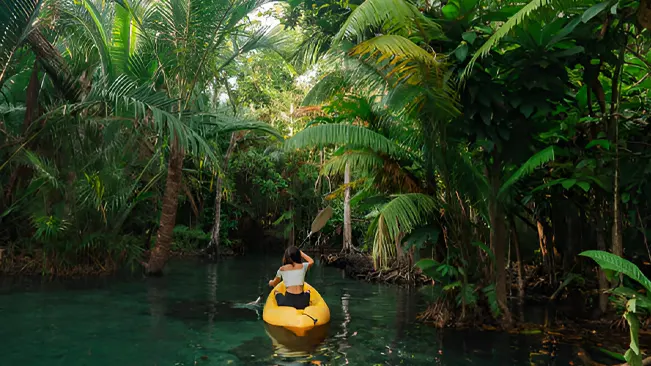
Furthermore, ecotourism plays a crucial role in providing direct financial benefits for conservation and economic benefits for local communities. Through this model, a portion of the tourism income is funneled back into preserving the ecosystems and supporting the local economies where it operates. This can include funding for park facilities, employment for local people in tourism businesses, and the use of local materials, products, and traditions in the construction and operation of tourism facilities. By engaging tourists in these efforts, ecotourism encourages a sense of environmental stewardship and helps ensure that development brings a positive experience for local inhabitants, tourism companies, and the tourists themselves.
The Benefits of Ecotourism
Ecotourism offers a path for travelers to explore the natural world responsibly, minimizing their ecological footprint. A key advantage of this form of tourism is its emphasis on reducing environmental pollution and managing waste effectively. Ecotourists are encouraged to conserve energy, utilize renewable energy sources like solar power, and reduce reliance on single-use plastics. Such practices ensure that the natural areas remain unspoiled and resilient against environmental degradation.
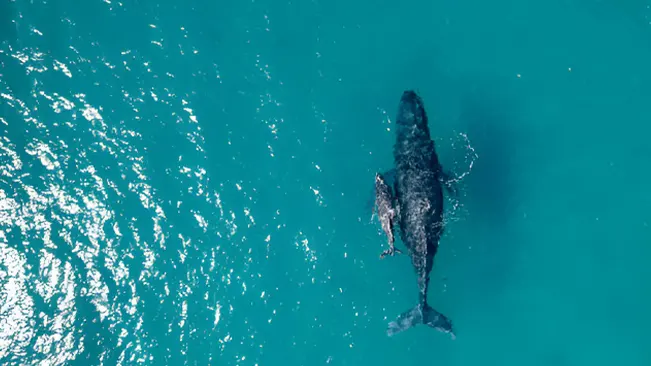
Ecotourism benefits local communities by channeling tourist spending into the economy, creating jobs, and generating income. It also enhances travel experiences with cultural immersion in local customs, languages, and cuisine. Moreover, it educates visitors on ecological conservation through activities like guided tours and conservation projects, raising awareness about environmental issues and fostering global environmental stewardship.
How Ecotourism Benefits Local Communities
Ecotourism benefits local communities by boosting the economy through increased spending on local services and products. It creates jobs in guiding, hospitality, and transport, and promotes the sale of local crafts and food. This income can improve community services, infrastructure, and living standards, helping to reduce poverty and ensure that economic gains are enjoyed by residents.

Ecotourism promotes cultural preservation and education by fostering interaction between tourists and local communities. This exchange enhances cultural pride and understanding, while tourists gain respect for local customs. Many programs also include educational components, where community members share knowledge about ecosystems and conservation, reinforcing the importance of preserving cultural heritage and environmental resources.
How Ecotourism Benefits the Environment
Ecotourism plays a crucial role in environmental conservation, particularly when it involves visiting national parks and protected areas. Visitors are encouraged to minimize their impact by adhering strictly to designated trails and paths to avoid disturbing the local flora and fauna. Additionally, it’s important that tourists avoid leaving any waste behind, such as plastic bottles or other non-biodegradable materials, which can cause long-term harm to ecosystems if not properly disposed of.

Moreover, responsible ecotourism practices help mitigate some of the adverse effects tourism can have on natural environments, such as deforestation and pollution that may result from activities like fishing or camping without adequate waste management. By educating tourists about the importance of responsible behavior such as disposing of waste properly, respecting wildlife, and preserving natural landscapes ecotourism ensures the ongoing protection and sustainability of these precious environments. This education not only helps in maintaining the health of ecosystems but also enhances visitors’ overall experience by fostering a deeper connection with nature.
The Main Principles of Ecotourism
1. respect the local culture.
Respecting local culture is an integral part of responsible tourism. When visiting new places, it’s important to honor the customs, beliefs, and traditions of the local population. This could include dressing modestly at religious sites, refraining from taking photographs of people without their consent, and being cautious about cultural sensitivities surrounding food choices and language usage. Such respect not only enhances mutual understanding but also enriches the travel experience, allowing visitors to form deeper connections with the community.

Additionally, by observing local norms and etiquette, tourists can avoid offending the host community, which can lead to a more welcoming and inclusive atmosphere. It’s important for travelers to educate themselves about the cultural practices and expectations of each destination before arriving. This preparation shows a level of respect that is often appreciated by local residents, paving the way for a more authentic and immersive cultural experience.
2. Support local businesses
Supporting local businesses is a crucial aspect of sustainable tourism. Tourists can contribute positively to the local economy by purchasing local products and dining at restaurants owned by local residents. This practice helps to keep money within the community, supporting family-owned businesses and preserving local jobs. Additionally, engaging with local enterprises offers tourists a unique insight into the area’s culture and traditions, providing a more genuine experience compared to what might be offered by larger, international chains.

Furthermore, by choosing to spend money on local goods and services, visitors can enjoy distinctive products and experiences that are not available elsewhere, from traditional crafts to regional cuisine. This not only makes for a memorable trip but also fosters economic development in often underserved areas, promoting prosperity in a way that respects the cultural and social fabric of the community.
3. Do not take souvenirs from protected areas
When visiting natural areas such as national parks, it’s crucial to leave the environment as you found it. This means taking all your trash with you to avoid pollution and protect wildlife, as well as resisting the temptation to take natural souvenirs like rocks, plants, or other materials from protected areas. Removing such items can disrupt local ecosystems, harm biodiversity, and degrade the natural heritage that makes these locations special.
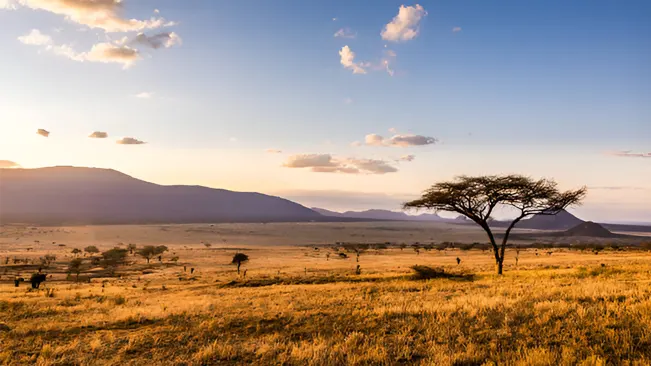
Tourists should also be aware of the long-term negative impacts that removing souvenirs from natural settings can have on ecological health and the visual aesthetics of the environment. By adhering to the principle of “leave no trace,” visitors ensure that these precious natural resources remain intact and vibrant for future generations to enjoy. Promoting and practicing such environmental responsibility supports conservation efforts and maintains the natural allure of these protected areas.
4. Use sustainable transportation
Using sustainable modes of transportation during travel is beneficial for both the environment and the local community. Options like biking, walking, or using public transit help reduce carbon emissions, decrease traffic congestion, and lessen the overall environmental footprint of tourism. These transportation methods are not only Eco-friendly but often provide a closer and more engaging experience of the local area.
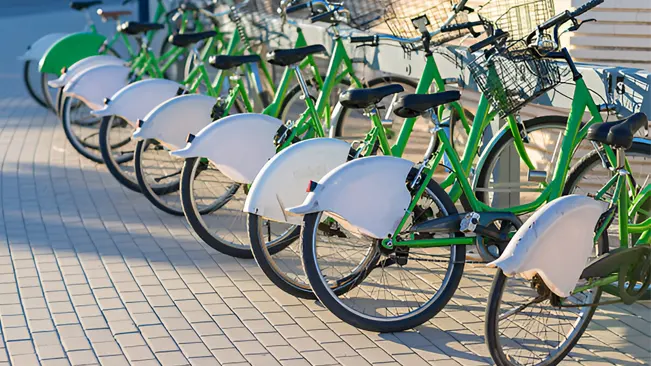
Additionally, sustainable transportation methods can be cost-effective and offer health benefits, such as increased physical activity and reduced stress levels. Tourists are encouraged to explore their surroundings at a slower pace, which can lead to unexpected discoveries and a richer connection with the destination. This approach not only helps preserve the environment for future visitors but also enhances the quality of the visitor experience, making travel more enjoyable and meaningful.
Why Should You Choose Ecotourism?
Choosing ecotourism as a travel option offers a unique opportunity to explore stunning locales while making a positive impact on the environment and local communities. This form of tourism encourages travelers to immerse themselves in local cultures, customs, and traditions, enriching their travel experience. More importantly, ecotourism is geared towards conserving natural resources and reducing tourists’ carbon footprints. By opting for accommodations that use sustainable practices, minimizing energy consumption, and supporting initiatives that preserve wildlife habitats and ecosystems, travelers can ensure that the beautiful places they visit today remain intact for future generations to appreciate.
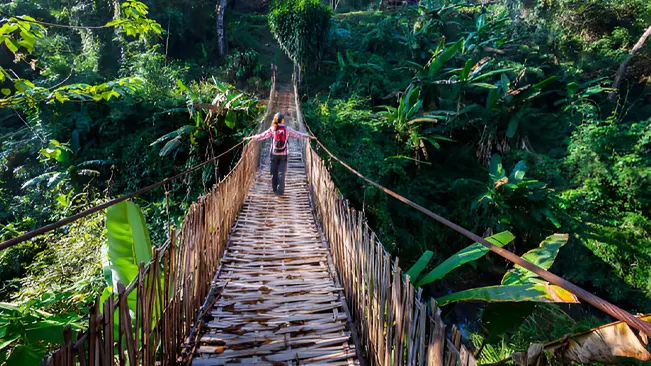
Ecotourism often includes activities where tourists contribute to conservation, like joining projects or attending sustainability workshops. This enhances the travel experience and supports local economies through Eco-friendly jobs. To maximize your ecotourism experience, research local environmental regulations, interact responsibly with wildlife, and respect local customs and legal restrictions.
- What is ecotourism? Ecotourism is a form of sustainable travel that focuses on visiting natural areas, contributing to environmental conservation, and improving the well-being of local people. It encourages low-impact behaviors and promotes environmental awareness among travelers.
- How does ecotourism benefit the environment? Ecotourism helps protect the environment by fostering a deep appreciation for nature among tourists. Activities are designed to minimize impact on natural resources, support the conservation of habitats, and reduce pollution through sustainable practices.
- In what ways does ecotourism support local communities? Ecotourism contributes to local economies by creating jobs that depend on sustainable practices, such as guiding, hospitality, and local artisan crafts. It also channels funds directly into community projects that enhance education, infrastructure, and health care.
- Can ecotourism help in wildlife conservation? Yes, ecotourism plays a significant role in wildlife conservation by funding reserves and parks and educating tourists about the importance of biodiversity. It also helps regulate access to sensitive environments, reducing illegal activities like poaching.
- What are the best practices for a tourist to follow when engaging in ecotourism? Tourists should adhere to guidelines such as staying on marked trails, using Eco-friendly products, supporting local businesses, and respecting cultural norms and traditions. Avoiding activities that harm the environment or disrupt local communities is also crucial.
- How does ecotourism promote cultural preservation? Ecotourism encourages respectful cultural exchange. Tourists learn about and participate in local traditions and ways of life, which helps preserve and celebrate unique cultural identities while providing economic benefits from these cultural interactions.
- What should I consider before choosing an ecotourism destination? Research the ecotourism credentials of a destination to ensure they adhere to genuine sustainable practices. Look for certifications from recognized organizations and check reviews from previous visitors to understand the impact and authenticity of the ecotourism activities offered.
- Are there any negative effects of ecotourism? If not managed properly, ecotourism can lead to over visitation, which might strain local resources and disrupt wildlife. Effective management and regulation are essential to mitigate such impacts and ensure that ecotourism remains a positive force for the environment and local communities.
Download Access Form
To access the download, we kindly ask you to provide your information in the form below. Your privacy matters to us, and we assure you that your information will be kept confidential and used only for the purpose of providing you with the download.

I'm Joel Cunningham, an expert in pruning and weed management with over a decade of experience. My skills are rooted in formal training and extensive practice, focusing on advanced pruning techniques and efficient weed control. I'm known for my quality work, precision, and deep understanding of plant health and soil dynamics. My contributions extend to educational initiatives where I share sustainable practices and advice, establishing myself as a reliable and authoritative figure in the gardening community.
Leave your comment
Related posts.
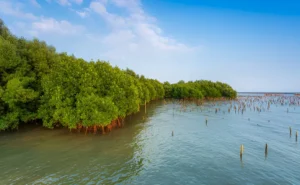
Benefits of Mangrove Forests

Forestry and Environmental Conservation

Forest Water Filtration: Ensuring Clean and Safe Water
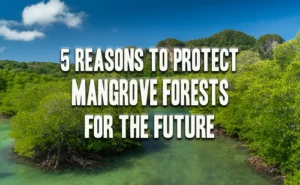
5 Reasons To Protect Mangrove Forests For The Future

Lower Your Carbon Footprint: Essential Tips for Sustainable Gardening
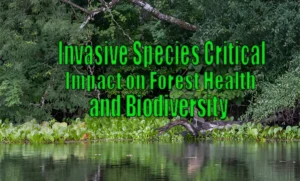
Invasive Species: Critical Impact on Forest Health and Biodiversity
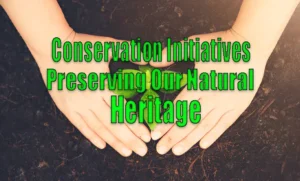
Conservation Initiatives Preserving Our Natural Heritage
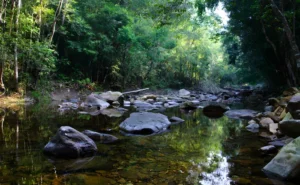
Ecological Restoration: The Incredible Power to Heal Nature

Mangrove Swamps: Nature’s Shield Against Coastal Erosion
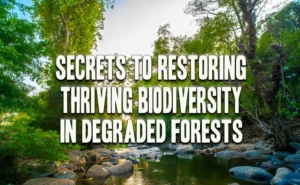
Secrets to Restoring Biodiversity in Degraded Forests

Alarming Deforestation: Causes, Effects, and Critical Solutions

Secrets of Carbon Footprint: What You Need to Know
The Independent Uganda: You get the Truth we Pay the Price
Kitara fc vs al hilal: why both legs are to be played at al hilal’s stadium.
- Rwandan parliament elects female speaker during inaugural session
- Chocolate makers ‘may have to cut cocoa content’
- Women birders visit Bongole GreenFingers Farm as agro-tourism in Uganda grows
WAR: 32,000 Sudanese refugees enter Uganda in one year
- MONKEY POX: Uganda puts 23 districts on high alert
- All set for new Premier League as Man City look to make it five in a row
- EAC governments asked to stop lip service and fund education
- New research shows presence of concealed ocean beneath surface of Mars
- King Mswati III of Eswatini in Jinja, visits Kiira Motors
MTN Uganda’s 30 Days of Y’ello Care: A record-breaking year of collaboration with agility and community impact
The Independent August 16, 2024 NEWS Leave a comment

Kampala, Uganda | THE INDEPENDENT | In 2007, MTN Uganda embarked on a transformative journey with the launch of the 21 Days of Y’ello Care programme. This initiative was designed to empower employees to contribute directly to their local communities, embodying the company’s commitment to corporate social responsibility.
Initially conceived as a singular internal initiative, the programme, which runs annually from June 1 to June 21, has since evolved into a collaborative movement involving multiple organizations and significantly broadening its scope and impact in communities.
This year, in its 17th edition of 21 Days of Y’ello Care, MTN Uganda staff collaborated with 35 organizations across various sectors, supporting projects in five schools: Kansanga Seed Secondary School in Kampala, St. Joseph’s Aid Society in Kyankwanzi district in the west, Ongongoja Secondary School in Katakwi district in the east, Bishop Dunstan Nsubuga Memorial School in Kalangala district in central, and Ariwa Secondary School in Yumbe district in the north. This marks the highest number of collaborations in the initiative’s history. Last year, MTN Uganda staff partnered with four organizations, focusing on economic empowerment.
Bryan Mbasa, Senior Manager of the MTN Foundation, highlighted the strategic decision to involve other organizations in the 21 Days of Y’ello Care program.
“We at MTN Uganda believe that we can only make a lasting impact on the lives of many, providing them with tools and resources they need to thrive and succeed for a better future through collaboration with organizations,” he said.
“These organizations bring both financial and technical support in areas where we have limitations, creating synergies in our activities.”
These partnerships have provided opportunities for organizations that wish to extend services but may lack the resources to do so independently. For instance, during this year’s 21 Days of Y’ello Care, which extended to 30 days in commemoration of MTN Group’s 30 years of operation, American Tower Corporation Uganda partnered with MTN Uganda staff to provide eighty solar panels to Ongongoja Senior Secondary School in Katakwi district. MTN Uganda provided twenty fully installed computers with internet access and lighting for students and teachers.
The Maendeleo Foundation and Centenary Technology Services offered digital and financial literacy to learners, while Tecno Mobile established teacher resource centers in four rural schools. Roofings Group contributed five hundred fruit trees to the five institutions and Faces Up played a crucial role in empowering schoolchildren through creative arts for psychosocial support during the campaign in the refugee settlement.
More other organizations including Stanbic Bank engaged in providing scholastic materials, career guidance, menstrual hygiene, and general skills.
Samuel Mwogeza, Executive Director and Head of Private and Personal Banking at Stanbic Bank Uganda, expressed pride in the partnership with MTN Uganda for the 2024 edition of “21 Days of Y’ello Care.”
“We are proud to have contributed to two of the four schools identified by MTN Uganda. Our partnership upgraded facilities at Bishop Dunstan Secondary School in Kalangala, including the provision of reusable sanitary towels to support girls’ dignity and the installation of seating to create a conducive learning environment,” he said. “In Yumbe, we augmented MTN’s digital infrastructure upgrade with a solar power system, ensuring reliable access to computer facilities.”
Mwogeza also noted that they delivered financial literacy training at Ongongoja Secondary School in Katakwi district, highlighting the benefits of affordable health insurance through their Medi Protect solution.
“This partnership embodies our commitment to driving positive change and aligns with our vision, ‘Uganda is our home, we drive her growth,’” he added.
“We congratulate MTN Uganda on the success of ’30 Days of Y’ello Care’ and look forward to future collaborations that foster sustainable development and community growth.”
Ssekitto Kalule Emmanuel, founder of Faces Up, described being part of the 30 days of Y’ello Care as empowering. “We were inspired and witnessed first-hand the power of partnership founded on intentionality and service,” he said.
Tags MTN Uganda Y'ello Care
Related Articles

August 16, 2024

Govt initiates new effort to support empty stomachs in schools

Leave a Reply Cancel reply
Your email address will not be published. Required fields are marked *
Save my name, email, and website in this browser for the next time I comment.
Notify me of follow-up comments by email.
Notify me of new posts by email.
US outdoors tourists pack an economic punch. What else they leave behind can be messy
DENVER — Adam Ducharme made an unpleasant discovery this summer while helping volunteers install signs telling visitors where to camp, park or launch boats near Leadville, a mountain town surrounded by 14,000-foot peaks in central Colorado.
“We were digging holes, putting in signs, and then backfilling the holes with rocks and sort of compounding it with dirt,” Ducharme said. “And every third rock that I picked up to put into the hole had human waste on it.”
Ducharme, the region’s first tourism director, was hired in 2022 to not only market the area, but also to help manage the effects of throngs of visitors who have descended on the scenic state after outdoor recreation boomed during the pandemic.
To address sustainability concerns, Colorado is the first state to fold what tourism officials call a “destination stewardship” department into its state-level tourism office, said Hayes Norris, the communications manager at the Colorado Tourism Office.
Most states welcome visitors, who are vital to their economies — in Pennsylvania, for example, 124 state parks attract 40 million visitors annually, according to the governor’s office . Outdoor recreation adds an estimated $14 billion annually to the Pennsylvania economy and supports 150,000 jobs, the state said. But the economic benefits are accompanied by crowds that can degrade the natural resources of fragile ecosystems.
More: Campers clamor for spots in Pennsylvania state parks, breaking Memorial Day weekend record
There’s even evidence of human waste in the regional groundwater supply in and around Leadville, Ducharme said. One of his tourism counterparts in Ouray, a high-altitude Colorado town with a population of 923 known as the Switzerland of America, said officials no longer actively promote their summer season because they are at capacity. Instead, they try to draw people year-round to lessen the impact of one season, and they focus on encouraging responsible tourism among their existing visitors.
“Summertime, we don’t really necessarily promote coming to Ouray,” said Kailey Rhoten, the tourism and destination marketing director for the city. “We promote what you can do when you’re in Ouray. Summertime is when I’m actually going out in the field, meeting people. That’s when we’re hitting it the hardest with more of that educational piece.”
More: What does outdoor recreation do for Pennsylvania's economy? $14 billion
Tackling overuse
The outdoor recreation boom was already on the rise before people sought socially distant fun during the early days of the pandemic. But it has been exacerbated by heavy use as people continue to plan hikes, pitch tents and seek out lakes and rivers during the extreme heat events that are now part of most American summers. Often, that recreation is in places that haven’t had adequate budgets for maintenance or staff, said Marci Mowery, president of the nonprofit Pennsylvania Parks & Forests Foundation.
In Pennsylvania — where all state parks and parking are free — there’s an effort to direct people to less-visited parks or trails, Mowery said. Their volunteers also have been actively teaching some visitors about Leave No Trace principles, which are a framework of minimum impact practices for anyone visiting the outdoors.
“We need to educate people that there are other alternatives and to have an alternative in their pocket,” Mowery said. “So if they show up at a very popular trailhead, rather than making their own parking space and wedging themselves in, to go to another trail in the state park system or in the forest or in a nearby park.”
More: 500 voices helping set agenda for Pennsylvania's outdoor recreation industry
Overuse can diminish the overall visitor experience for people seeking the solitude of wilderness or the outdoors. And it can make it more challenging for rural search-and-rescue teams to respond to emergencies, especially when new or inexperienced outdoor enthusiasts seek out adventure.
In Washington state, for example, a popular federal wilderness area known as the Enchantments allows limited overnight camping, accessible only to backpackers via a competitive lottery. But people are allowed to hike the challenging 18-mile route during the day without a permit. Fueled by social media posts of clear mountain lakes and mountain goats, as well as online lists touting the Enchantments trek as a world trail-running highlight, a growing number of enthusiasts try to complete the trek in one go. They can’t always finish, and some must call for emergency help, the Chelan County Sheriff’s Office told the Seattle Times .
A study of pandemic recreation habits by Pennsylvania State University, the University of Montana and the Leave No Trace Center for Outdoor Ethics found that nearly half of adults in the United States now participate in outdoor recreation “at least once per month.” Twenty percent of those people may be entirely new to outdoor recreation since the pandemic, the study found.
That new popularity coincides with the challenges many state parks now face because of climate change, said Rachel Norton, executive director of the California State Parks Foundation, a nonprofit that supports state parks and forests. She points to the 2020 fires that burned more than 97% of the state’s beloved Big Basin Redwoods State Park. Portions of the park reopened last year for day visitors with reservations.
“It was really a gut punch to a lot of people in California because that park was so well loved and it was like, OK, it’s here,'” Norton said. “We love these places, we value these places, and now climate change is here and it’s threatening these places. They’re actually getting beat up more by the impacts of climate change and visitation. And so there’s just really a need to fund them and maintain them and manage them somewhat differently as the climate changes.”
In Pennsylvania, state parks and forests got a $75 million bump in the 2022 state budget thanks to money from federal American Rescue Plan Act . It is “a down payment on this larger need to invest,” Mowery said. But state funding often is not enough to address the backlog of needs or the future effects of climate change, she said, pointing to the flood damage at one park that recently experienced 5½ inches of rain in 45 minutes.
Expanding access
To manage crowds and provide more opportunities for local and out-of-state visitors, some states, including California, North Dakota and Pennsylvania , have opened or are planning new state parks or trail systems to accommodate more visitors.
North Dakota recently devoted $17.9 million to its maintenance backlog and has an $8 million plan to expand a remote recreation area near the Canadian border into its 14th state park . Plans call for 35 campsites and about six cabins at the Pembina Gorge in northeastern North Dakota, which has steep valley cliffs and the largest continuous, undisturbed forest in the state.
The gorge is closer to Winnipeg than it is to any populous North Dakota cities, said state parks Director Cody Schulz, so officials anticipate that when it opens in 2025, the new park will be a four-season draw for Canadian visitors. He said he was struck when he started the job two years ago by how, while the borders were closed during the height of the pandemic, Canadian visitors to state parks dropped by 63%. But overall visits to state parks were up by about 20% and continue to remain steady. The park hopes to tap the Canadian market even as it serves its own residents, he said.
“There’s some pent-up demand and we just want to make sure that our supply matches the demand,” he said. “This is a unique opportunity for us to check all of those strategic boxes: stewardship and conservation, economic development and tourism.”
Even as they accommodate more visitors, many state parks also hope to expand who has access to the outdoors, especially visitors of color who’ve been excluded in the past, and those of limited economic means who rely on the affordability of state parks for recreation.
Reclaiming 'fat': Ample Movement, in Jamestown, NY, uses outdoors to change views
In California, where it can cost as much as $20 a day to park at some beach parks, the state plans to boost spending on a popular program that allows people to check out free day passes from their local libraries. And at North Dakota state parks, visitors can nab a $2 tent camping site on Tuesdays, a less popular day for visitors.
Other state park systems, including in Colorado and Oregon, have tweaked their online reservation systems so people who can’t plan ahead for a spot at popular campsites are more likely to land last-minute vacancies.
Colorado has tried to tailor its tourism marketing efforts to the needs of individual communities, Norris said. About a third of the state’s 17 recent tourism marketing grants to local boosters have an element of responsible tourism or destination stewardship.
Other state marketing efforts include campaigns like “Doo Colorado Right,” a $40,000 push aimed at educating visitors about outdoor toilet etiquette. The campaign began in the Gunnison Valley, another highly-trafficked locale with many backcountry visitors. Local tourism officials around the state handed out 3,500 backpacking trowels with fungal mycelium-based tablets that speed the disintegration of human waste. The instructions: Dig a 6-inch-deep cathole, drop in the tablets and a biodegradable wipe, and cover it up with dirt.
Ducharme said his own family has adapted new toilet habits when camping, based on what he’s unearthed recently — and the campaign. When car camping in remote places without bathroom facilities, for example, they bring a portable toilet. So-called wag bags also are an option for backpackers, who can pack out waste and dispose of it in municipal trash instead of digging up fragile high-elevation tundra.
The trowel campaign is a playful take on the state’s existing “Do Colorado Right” messaging, Norris said. That campaign got its start during the pandemic to educate visitors about responsible and respectful travel in Colorado — even as they make the most of their trip by choosing lesser-known attractions and off-peak times for their visits, she said.
“It’s done really well on social channels, does really well on TikTok and Instagram because it makes it very fun and lighthearted and less finger-wagging,” Norris said. “It’s more like ‘do this and you’ll have a better experience.'”
Erika Bolstad is a Stateline correspondent based in Portland, Oregon, and the author of Windfall, published by Sourcebooks in 2023. Previously, she wrote for E&E News, the McClatchy Washington Bureau and the Miami Herald.

IMAGES
COMMENTS
Conclusion: Tourism brings many benefits to local communities beyond economic gains. It contributes to cultural preservation, infrastructure development, entrepreneurship, social understanding, and environmental conservation. By embracing sustainable tourism practices and involving local communities in decision-making processes, we can ensure ...
References (17) Abstract. Purpose: This literature review paper aims to comprehensively analyze and synthesize existing research on the socioeconomic impacts of tourism on local communities. It ...
These findings suggest that national, regional, and local governments or community developers should make tourism a strategic pillar in their policies for rural development and implement tourism ...
Community-based tourism can reap great rewards. Done well, it enables local organisations to protect precious habitats, preserve unique culture and empower grassroots employees. This article was ...
The tourism industry is a vertical with one of the most comprehensive impacts on economic and social landscapes. That's precisely what makes it essential for macro- and micro-economies. Tourism can help generate additional revenue streams for local communities enabling locals to kickstart new businesses, rebuild and restore structures, and ...
The above-mentioned issues are the direct benefits of tourism to the local community. More importantly, hotel tourism is very important for the community. So many standardized hotels are constructed due to the presence of the tourism industry. ... The Socio-Economic Impact of Tourism on Communities Around the Pilanesberg National Park, North ...
Tourism has a great potential to change the structure of the economy both in developed and developing countries. Tourism development in a region has both pros and cons for local communities. On one side, it boosting up economic growth and provide various facilities to the locals. On the other side, it is creating many negative externalities such as the communities are expected to agonize from ...
BACKGROUND: Tourism development can have a positive or negative impact on the lives of local communities. AIM: This systematic review aims to determine the impact of tourism on the quality of life ...
These studies have shown that existing tourism developments directly affect local communities (Sharpley, Citation 1994). The resulting dynamics—arising from community involvement—shape values, behaviors, lifestyles, and quality of life, leading to the formation of new perceptions associated with tourism (Hall & Page, Citation 2014).
During January 2017, we surveyed households in three communities (n = 197) with varying levels of tourism involvement and conducted focus groups with village elders (n = 28). Individuals and communities who engaged in tourism-related livelihoods expressed stronger support for conservation and reduced reliance on the natural environment.
The other negative impact of tourism is erosion of the local communities' socio-cultural assets. In the past, every stranger had been considered a guest and had received respect from the people. And the local people had been treating them with hospitality, and there was no expectation of an equivalent return for their services.
Development and Their Implications on Local Communities. tourists in 2014. According to Buultjens et al. (2015) the. tourism industry makes a significant contribution to Sr i. Lanka's economy ...
Overall, community-based tourism can have a positive impact on local communities. It can provide economic benefits, foster a sense of pride and ownership, and promote environmental sustainability. For travelers looking to experience a destination in a more meaningful way, community-based tourism is an excellent option.
Induced spending, which is the re-circulation of a tourist dollar within a community, is another way that tourism indirectly has an impact on a community. [9] For example, a foreign tourist injects money into the local economy when he spends a dollar on a souvenir made by a local at the tourism destination.
Monitoring the impacts of tourism in local communities ensures sustainable tourism development. In order to do so effectively, a monitoring framework is essential. ... Purpose - The impact of tourism is an ongoing research interest among scholars as it is directly related to the tourism development process. Residents' perceptions of tourism ...
Tourism brings a multitude of benefits to the local community, creating a positive ripple effect that reaches far beyond the experiences of individual travelers. From economic growth and job creation to cultural preservation and environmental conservation, tourism plays a crucial role in enhancing the wellbeing and prosperity of the local ...
6. Eat in local restaurants. Eating and drinking in local restaurants and café's directly benefits the local economy for the obvious reasons. It ensures the money stays in the destination and that the local owner and employees financially benefit. It also directly supports the local farmers and food producers in the area.
The development of rural communities often involves the use of rural tourism, which has been extensively studied for its impacts on community livelihoods. However, little attention has been given to its effects in the context of the Philippines, where beach tourism is dominant, despite that rural tourism is emerging in marginalized rural areas.
literature uncovers a nuanced web of socio-economic impacts in tourism-driven communities. Positive effects include increased income, employment opportunities, and infrastructure development ...
Over the past year, the Maui community has tried to balance the economic need for tourism with the emotional healing of what was lost. The island, especially Lahaina, is a tight-knit community ...
The effects that can be observed directly and most are the economic effects and one of them is the effect on the local communities. This is because, the online gambling business earns huge ...
Tourism is an excellent pathway with which to promote and provide access to cultural heritage. Sustainable cultural tourism offers a new perspective, as it places cultural heritage and local communities at the centre of decision-making processes. In this context, traditional tourism must be updated accordingly to the new times. This research aims to classify a cultural heritage piece found in ...
Ecotourism offers significant benefits for both the environment and local communities. By engaging in conservation projects and sustainable practices, tourists help preserve natural habitats and support biodiversity. This hands-on involvement not only aids in environmental protection but also boosts local economies through Eco-friendly jobs and tourism-related services. Additionally ...
Kampala, Uganda | THE INDEPENDENT | In 2007, MTN Uganda embarked on a transformative journey with the launch of the 21 Days of Y'ello Care programme. This initiative was designed to empower employees to contribute directly to their local communities, embodying the company's commitment to corporate social responsibility. Initially conceived as a singular internal initiative, the …
Ducharme, the region's first tourism director, was hired in 2022 to not only market the area, but also to help manage the effects of throngs of visitors who have descended on the scenic state ...
In tourism, resilience refers to the ability of destinations, businesses, and communities to withstand, adapt to, and recover from disruptions caused by disasters and crises. While initial efforts to curb the negative impacts of crises usually focus on recovery, it is argued that the tourism industry must shift towards building a long-term ...
The origin of the word "Cherepovets" is a subject of much debate among the local historians. According to one version, the city supposedly received its name from the word "skull" (Russian: череп, cherep).In antiquity, a pagan sanctuary was there in honor of the god Veles on the hill at the confluence of the Sheksna and Yagorba Rivers.The top of the hill was called the "skull."
Tazyeen Alam Impact of Tourism o n Local Communities. 210. 95%, almost 60% tourists prefer l iving in hotels in the c ountry. while the remaining 40% stay at their friends or rela tives in. the ...
Hotels near Historical And Ethnographic Museum Manor of Galskiye Hotels near Monument to the founders of Cherepovets - Monks Feodosy and Athanasius Hotels near Vereschagin's House Museum Hotels near Rainbow Aquapark Hotels near Metallurgy Industry Museum Hotels near Museum House I. A.Milyutina Hotels near Church of the Assumption Hotels near Museum of History and Local Lore Hotels near ...
r/SeattleWA is the active Reddit community for Seattle, Washington and the Puget Sound area! Do you want lively open discussions, upcoming events, local artist creations, community meet-ups, Seattle history, current news, community outreach, and careful transparent moderation? This place is for you.